Organometallic Compound And Organic Light-emitting Device Including The Same
LEE; Jiyoun ; et al.
U.S. patent application number 16/941793 was filed with the patent office on 2020-11-12 for organometallic compound and organic light-emitting device including the same. The applicant listed for this patent is Samsung Electronics Co., Ltd.. Invention is credited to Byoungki CHOI, Kyuyoung HWANG, Sangdong KIM, Yoonhyun KWAK, Ohyun KWON, Banglin LEE, Jiyoun LEE.
| Application Number | 20200358012 16/941793 |
| Document ID | / |
| Family ID | 1000004986500 |
| Filed Date | 2020-11-12 |

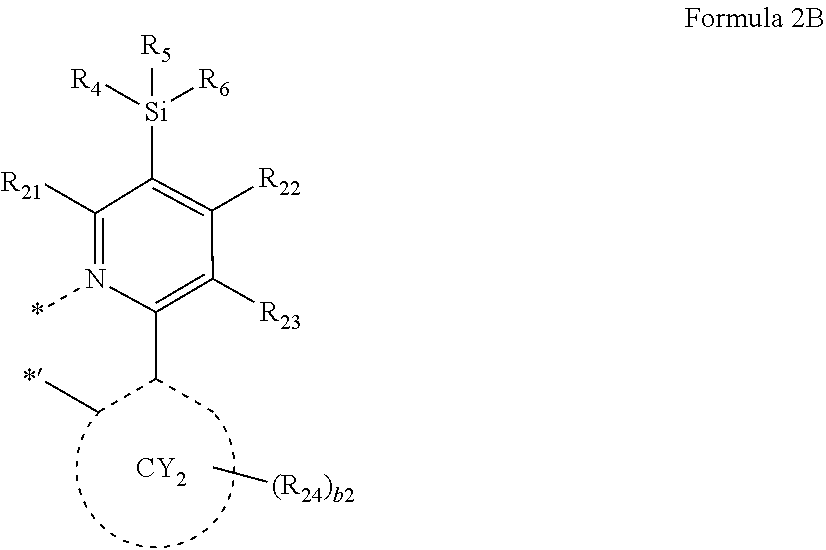
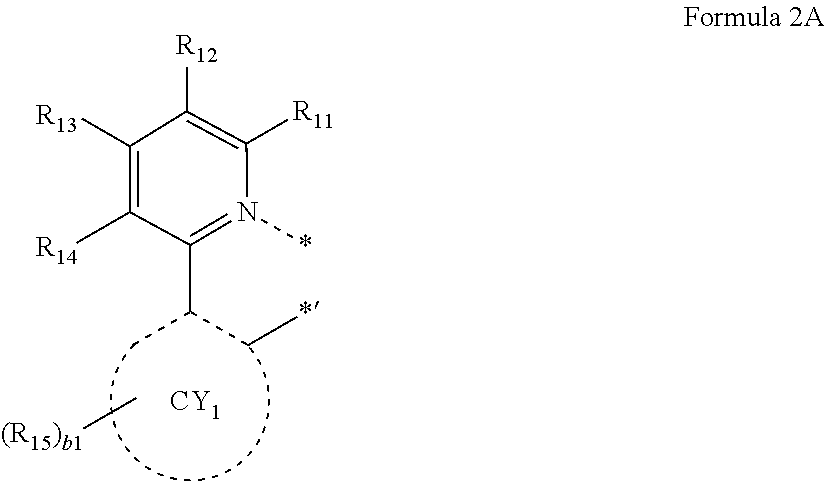
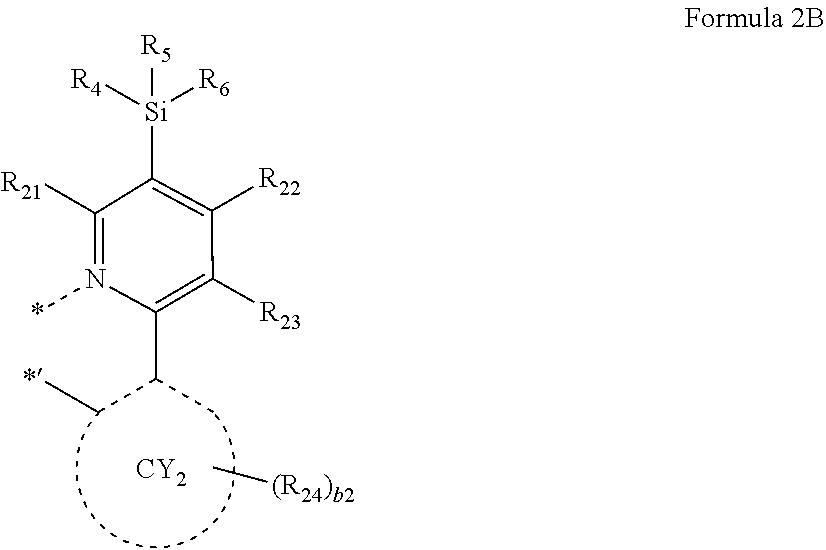
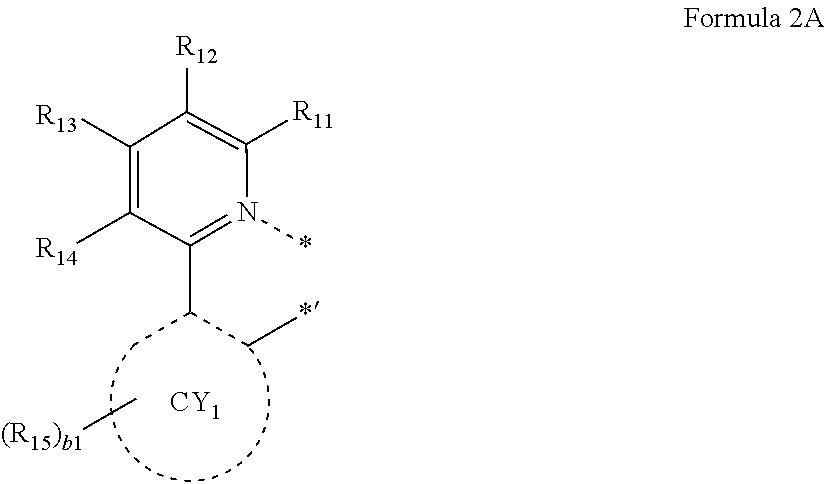
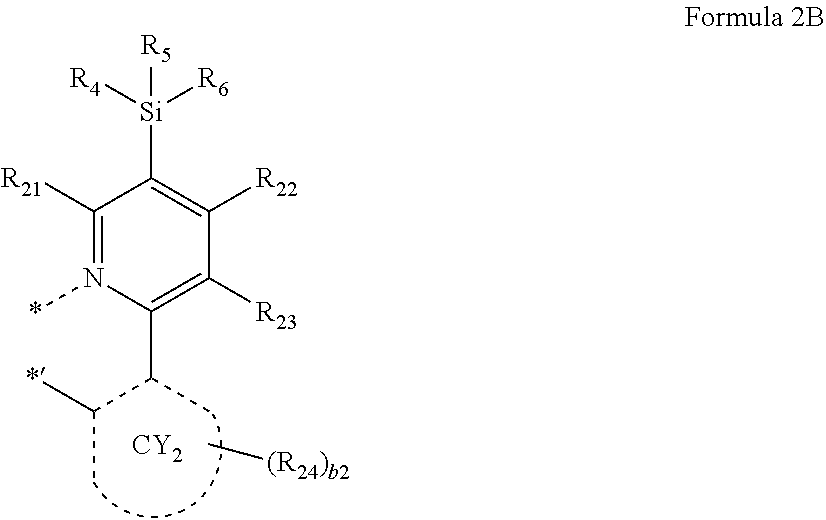




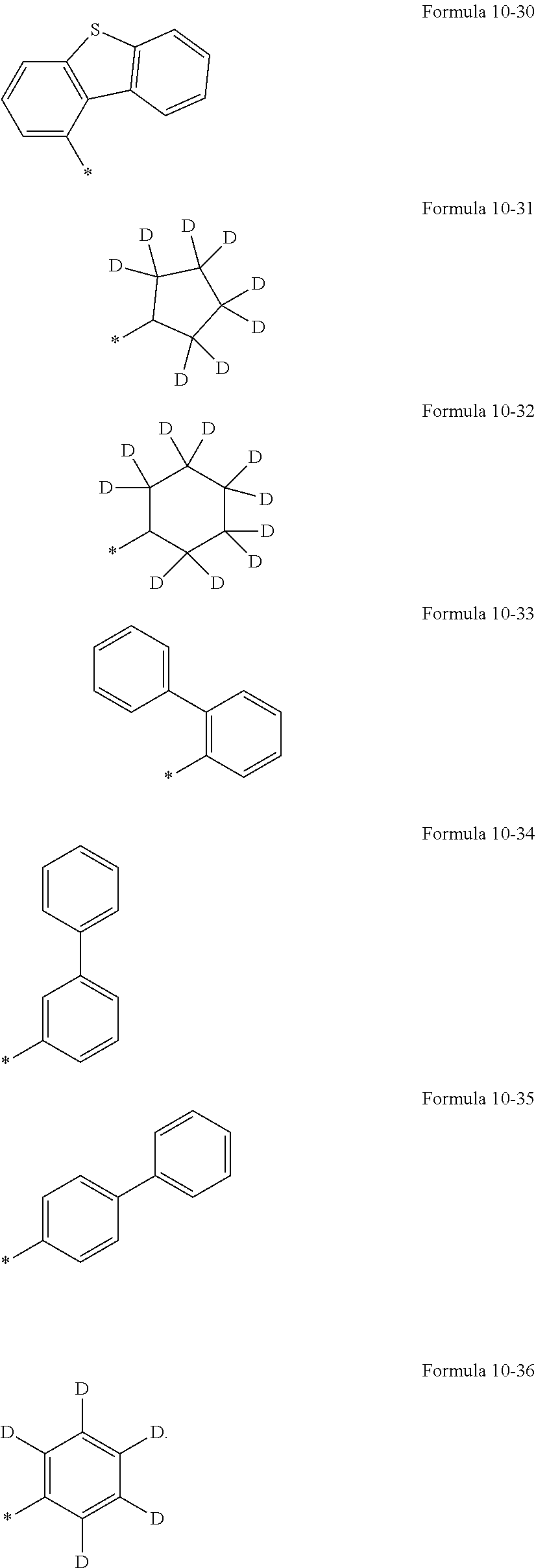
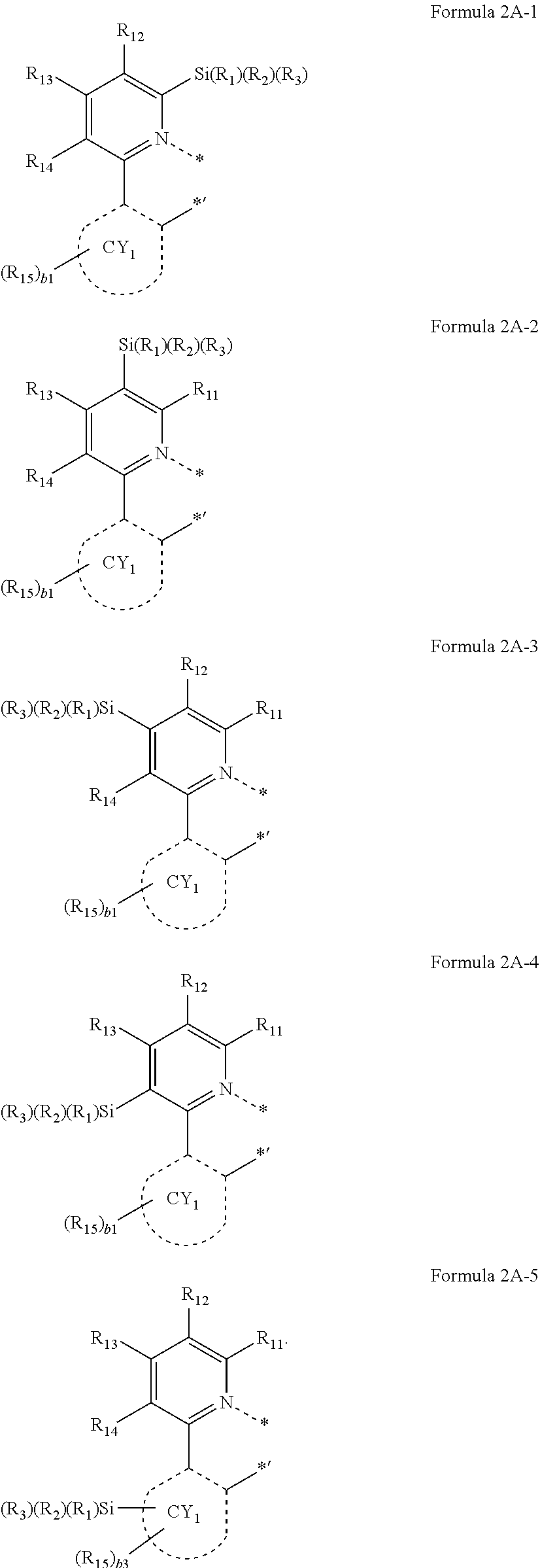
View All Diagrams
| United States Patent Application | 20200358012 |
| Kind Code | A1 |
| LEE; Jiyoun ; et al. | November 12, 2020 |
ORGANOMETALLIC COMPOUND AND ORGANIC LIGHT-EMITTING DEVICE INCLUDING THE SAME
Abstract
An organometallic compound represented by Formula 1: M(L.sub.1).sub.n1(L.sub.2).sub.n2 Formula 1 ##STR00001## ##STR00002## wherein in Formulae 1, 2A, and 2B, groups and substituents are the same as disclosed in the specification.
| Inventors: | LEE; Jiyoun; (Incheon, KR) ; KWAK; Yoonhyun; (Seoul, KR) ; KWON; Ohyun; (Yongin-si, KR) ; KIM; Sangdong; (Seoul, KR) ; LEE; Banglin; (Suwon-si, KR) ; CHOI; Byoungki; (Hwaseong-si, KR) ; HWANG; Kyuyoung; (Anyang-si, KR) | ||||||||||
| Applicant: |
|
||||||||||
|---|---|---|---|---|---|---|---|---|---|---|---|
| Family ID: | 1000004986500 | ||||||||||
| Appl. No.: | 16/941793 | ||||||||||
| Filed: | July 29, 2020 |
Related U.S. Patent Documents
| Application Number | Filing Date | Patent Number | ||
|---|---|---|---|---|
| 15062819 | Mar 7, 2016 | |||
| 16941793 | ||||
| Current U.S. Class: | 1/1 |
| Current CPC Class: | C09K 11/025 20130101; H01L 51/0085 20130101; C09K 2211/185 20130101; H01L 2251/552 20130101; C09K 2211/1007 20130101; C09K 2211/1029 20130101; H01L 51/5016 20130101; C07F 15/0033 20130101; H01L 51/0094 20130101; H01L 51/5004 20130101; C09K 11/06 20130101; H01L 51/0072 20130101; H01L 51/5012 20130101 |
| International Class: | H01L 51/00 20060101 H01L051/00; C07F 15/00 20060101 C07F015/00; C09K 11/06 20060101 C09K011/06; C09K 11/02 20060101 C09K011/02 |
Foreign Application Data
| Date | Code | Application Number |
|---|---|---|
| Mar 13, 2015 | KR | 10-2015-0035155 |
Claims
1. An organometallic compound represented by Formula 1: M(L.sub.1).sub.n1(L.sub.2).sub.n2 Formula 1 wherein M in Formula 1 is iridium, in Formula 1, L.sub.1 is selected from ligands represented by Formula 2A(1) to 2A(128), n1 is 1 or 2, provided that when n1 is 2 or greater, two or more groups L.sub.1 are identical to or different from each other, in Formula 1, L.sub.2 is selected from ligands represented by Formula 2B(1) to 2B(64), n2 is 1 or 2, provided that when n2 is 2 or greater, two or more groups L.sub.2 are identical to or different from each other, in Formula 1, L.sub.1 and L.sub.2 are different from each other, and the sum of n1 and n2 is 3, each of * and *' in Formulae 2A and 2B indicates a binding site to M in Formula 1, ##STR00199## ##STR00200## ##STR00201## ##STR00202## ##STR00203## ##STR00204## ##STR00205## ##STR00206## ##STR00207## ##STR00208## ##STR00209## ##STR00210## ##STR00211## ##STR00212## ##STR00213## ##STR00214## ##STR00215## ##STR00216## ##STR00217## ##STR00218## ##STR00219## ##STR00220## ##STR00221## ##STR00222## ##STR00223## ##STR00224## ##STR00225## ##STR00226## ##STR00227## ##STR00228## ##STR00229## ##STR00230## ##STR00231## ##STR00232## ##STR00233## ##STR00234## ##STR00235## ##STR00236## ##STR00237## ##STR00238## wherein, R.sub.1 to R.sub.6 in Formulae 2A(1) to 2A(128) and 2B(1) to B2(64) are each independently selected from --CH.sub.3, --CD.sub.3, --CD.sub.2H, --CDH.sub.2, and a phenyl group, R.sub.12, R.sub.13, R.sub.15, R.sub.15a to R.sub.15d, R.sub.21, R.sub.23, R.sub.24 and R.sub.24a to R.sub.24d in Formulae 2A(1) to 2A(128) and 2B(1) to B2(64) are each independently selected from a deuterium, --F, --CH.sub.3, --CD.sub.3, --CD.sub.2H, --CDH.sub.2, --CF.sub.3, --CF.sub.2H, --CFH.sub.2, groups represented by Formulae 9-1 to 9-19, groups represented by Formulae 10-7 to 10-12, and groups represented by Formulae 10-31 and 10-32, R.sub.22 in Formulae 2B(1) to B2(64) is selected from groups represented by Formulae 9-1 to 9-19, groups represented by Formulae 10-7 to 10-12, and groups represented by Formulae 10-31 and 10-32, and each of * and *' in Formulae 2A(1) to 2A(128) and 2B(1) to B2(64) indicates a binding site to M in Formula 1: ##STR00239## ##STR00240##
2. The organometallic compound of claim 1, wherein the organometallic compound is one of the following Compounds: ##STR00241## ##STR00242## ##STR00243## ##STR00244## ##STR00245## ##STR00246## ##STR00247## ##STR00248## ##STR00249## ##STR00250## ##STR00251## ##STR00252## ##STR00253## ##STR00254## ##STR00255## ##STR00256## ##STR00257## ##STR00258## ##STR00259## ##STR00260## ##STR00261## ##STR00262## ##STR00263## ##STR00264## ##STR00265## ##STR00266## ##STR00267## ##STR00268## ##STR00269## ##STR00270##
3. An organic light-emitting device comprising: a first electrode, a second electrode, and an organic layer disposed between the first electrode and the second electrode, wherein the organic layer comprises an emission layer and at least one organometallic compounds of claim 1.
4. The organic light-emitting device of claim 3, wherein the first electrode is an anode, the second electrode is a cathode, and the organic layer comprises i) a hole transport region disposed between the first electrode and the emission layer, wherein the hole transport region comprises a hole injection layer, a hole transport layer, an electron blocking layer, or any combination thereof, and ii) an electron transport region disposed between the emission layer and the second electrode, wherein the electron transport region comprises a hole blocking layer, an electron transport layer, an electron injection layer, or any combination thereof.
5. The organic light-emitting device of claim 3, wherein the emission layer comprises the organometallic compound.
6. The organic light-emitting device of claim 5, wherein the organometallic compound acts as a dopant and the emission layer further comprises a host.
Description
CROSS-REFERENCE TO RELATED APPLICATION
[0001] This application claims priority to U.S. patent application Ser. No. 15/062,819, filed Mar. 7, 2016 and claims priority and the benefit of Korean Patent Application No. 10-2015-0035155, filed on Mar. 13, 2015, in the Korean Intellectual Property Office, the content of which is incorporated herein in its entirety by reference.
BACKGROUND
1. Field
[0002] The present disclosure relates to relate to an organometallic compound and an organic light-emitting device including the same.
2. Description of the Related Art
[0003] Organic light emitting devices (OLEDs) are self-emission devices that have wide viewing angles, high contrast ratios, and short response times. In addition, OLEDs have good brightness, driving voltage, and response speed characteristics, and produce full-color images.
[0004] In an example, an organic light-emitting device includes an anode, a cathode, and an organic layer that is disposed between the anode and the cathode, and further includes an emission layer. A hole transport region may be disposed between the anode and the emission layer, and an electron transport region may be disposed between the emission layer and the cathode. Holes provided from the anode may move toward the emission layer through the hole transport region, and electrons provided from the cathode may move toward the emission layer through the electron transport region. The holes and the electrons are recombined in the emission layer to produce excitons. These excitons change from an excited state to a ground state, thereby generating light.
[0005] Different types of organic light emitting devices are known. However, there still remains a need in OLEDs having low driving voltage, high efficiency, high brightness, and long lifespan.
SUMMARY
[0006] Provided are a novel organometallic compound and an organic light-emitting device including the same.
[0007] Additional aspects will be set forth in part in the description which follows and, in part, will be apparent from the description, or may be learned by practice of the presented exemplary embodiments.
[0008] According to an aspect of an exemplary embodiment, there is provided an organometallic compound represented by Formula 1:
M(L.sub.1).sub.n1(L.sub.2).sub.n2 Formula 1
##STR00003##
##STR00004##
[0009] M in Formula 1 may be selected from iridium, platinum, osmium, titanium, zirconium, hafnium, europium, terbium, thulium, and rhodium,
[0010] in Formula 1, L.sub.1 may be selected from ligands represented by Formula 2A, n1 may be 1 or 2, and when n1 is 2 or greater, two or more groups L.sub.1 may be identical to or different from each other,
[0011] in Formula 1, L.sub.2 may be selected from ligands represented by Formula 2B, n2 may be 1 or 2, and when n2 is 2 or greater, two or more groups L.sub.2 may be identical to or different from each other,
[0012] in Formula 1, L.sub.1 and L.sub.2 may be different from each other, and the sum of n1 and n2 may be 2 or 3,
[0013] each of * and *' in Formulae 2A and 2B may indicate a binding site to M in Formula 1,
[0014] CY.sub.1 and CY.sub.2 in Formulae 2A and 2B may be each independently selected from a C.sub.5-C.sub.60 carbocyclic group and a C.sub.1-C.sub.60 heterocyclic group, provided that CY.sub.2 is none of a dibenzofuran, a dibenzothiophene, a dibenzothiophene sulfone, a carbazole, and a dibenzosilole,
[0015] R.sub.11 to R.sub.15 in Formula 2A may be each independently selected from a hydrogen, a deuterium, --F, --C, --Br, --I, --SF.sub.5, a hydroxyl group, a cyano group, a nitro group, an amino group, an amidino group, a hydrazine group, a hydrazone group, a carboxylic acid group or a salt thereof, a sulfonic acid group or a salt thereof, a phosphoric acid group or a salt thereof, a substituted or unsubstituted C.sub.1-C.sub.60 alkyl group, a substituted or unsubstituted C.sub.2-C.sub.60 alkenyl group, a substituted or unsubstituted C.sub.2-C.sub.60 alkynyl group, a substituted or unsubstituted C.sub.1-C.sub.60 alkoxy group, a substituted or unsubstituted C.sub.3-C.sub.10 cycloalkyl group, a substituted or unsubstituted C.sub.1-C.sub.60 heterocycloalkyl group, a substituted or unsubstituted C.sub.3-C.sub.10 cycloalkenyl group, a substituted or unsubstituted C.sub.1-C.sub.10 heterocycloalkenyl group, a substituted or unsubstituted C.sub.6-C.sub.60 aryl group, a substituted or unsubstituted C.sub.6-C.sub.60 aryloxy group, a substituted or unsubstituted C.sub.6-C.sub.60 arylthio group, a substituted or unsubstituted C.sub.7-C.sub.60 arylalkyl group, a substituted or unsubstituted C.sub.1-C.sub.60 heteroaryl group, a substituted or unsubstituted C.sub.1-C.sub.60 heteroaryloxy group, a substituted or unsubstituted C.sub.1-C.sub.60 heteroarylthio group, a substituted or unsubstituted C.sub.2-C.sub.60 heteroarylalkyl group, a substituted or unsubstituted monovalent non-aromatic condensed polycyclic group, a substituted or unsubstituted monovalent non-aromatic condensed heteropolycyclic group, --Si(R.sub.1)(R.sub.2)(R.sub.3), --N(Q.sub.1)(Q.sub.2), --B(Q.sub.3)(Q.sub.4), and --P(.dbd.O)(Q.sub.5)(Q.sub.6),
[0016] R.sub.21 to R.sub.24 in Formula 2B may be each independently selected from a hydrogen, a deuterium, --F, --C, --Br, --I, --SF.sub.5, a hydroxyl group, a cyano group, a nitro group, an amino group, an amidino group, a hydrazine group, a hydrazone group, a carboxylic acid group or a salt thereof, a sulfonic acid group or a salt thereof, a phosphoric acid group or a salt thereof, a substituted or unsubstituted C.sub.1-C.sub.60 alkyl group, a substituted or unsubstituted C.sub.2-C.sub.60 alkenyl group, a substituted or unsubstituted C.sub.2-C.sub.60 alkynyl group, a substituted or unsubstituted C.sub.1-C.sub.60 alkoxy group, a substituted or unsubstituted C.sub.3-C.sub.10 cycloalkyl group, a substituted or unsubstituted C.sub.1-C.sub.60 heterocycloalkyl group, a substituted or unsubstituted C.sub.3-C.sub.10 cycloalkenyl group, a substituted or unsubstituted C.sub.1-C.sub.10 heterocycloalkenyl group, a substituted or unsubstituted C.sub.6-C.sub.60 aryl group, a substituted or unsubstituted C.sub.6-C.sub.60 aryloxy group, a substituted or unsubstituted C.sub.6-C.sub.60 arylthio group, a substituted or unsubstituted C.sub.7-C.sub.60 arylalkyl group, a substituted or unsubstituted C.sub.1-C.sub.60 heteroaryl group, a substituted or unsubstituted C.sub.1-C.sub.60 heteroaryloxy group, a substituted or unsubstituted C.sub.1-C.sub.60 heteroarylthio group, a substituted or unsubstituted C.sub.2-C.sub.60 heteroarylalkyl group, a substituted or unsubstituted monovalent non-aromatic condensed polycyclic group, a substituted or unsubstituted monovalent non-aromatic condensed heteropolycyclic group, --N(Q.sub.1)(Q.sub.2), --B(Q.sub.3)(Q.sub.4), and --P(.dbd.O)(Q.sub.5)(Q.sub.6),
[0017] b1 and b2 in Formulae 2A and 2B may be each independently an integer selected from 0 to 4, provided that
[0018] i) one selected from R.sub.11 to R.sub.14 in Formula 2A or ii) one selected from R.sub.15 in the number of b1 in Formula 2A, may be --Si(R.sub.1)(R.sub.2)(R.sub.3),
[0019] at least one of R.sub.21 to R.sub.23 in Formula 2B may not be a hydrogen,
[0020] R.sub.1 to R.sub.3 in --Si(R.sub.1)(R.sub.2)(R.sub.3) of Formula 2A and R.sub.4 to R.sub.6 in Formula 2B may be each independently selected from a hydrogen, a deuterium, a substituted or unsubstituted C.sub.1-C.sub.60 alkyl group, a substituted or unsubstituted C.sub.2-C.sub.60 alkenyl group, a substituted or unsubstituted C.sub.2-C.sub.60 alkynyl group, a substituted or unsubstituted C.sub.1-C.sub.60 alkoxy group, a substituted or unsubstituted C.sub.3-C.sub.10 cycloalkyl group, a substituted or unsubstituted C.sub.1-C.sub.10 heterocycloalkyl group, a substituted or unsubstituted C.sub.3-C.sub.10 cycloalkenyl group, a substituted or unsubstituted C.sub.1-C.sub.10 heterocycloalkenyl group, a substituted or unsubstituted C.sub.6-C.sub.60 aryl group, a substituted or unsubstituted C.sub.6-C.sub.60 aryloxy group, a substituted or unsubstituted C.sub.1-C.sub.60 heteroaryl group, a substituted or unsubstituted monovalent non-aromatic condensed polycyclic group, a substituted or unsubstituted monovalent non-aromatic condensed heteropolycyclic group, and --Si(Q.sub.51)(Q.sub.52)(Q.sub.53), and
[0021] at least one of substituents of the substituted C.sub.1-C.sub.60 alkyl group, substituted C.sub.2-C.sub.60 alkenyl group, substituted C.sub.2-C.sub.60 alkynyl group, substituted C.sub.1-C.sub.60 alkoxy group, substituted C.sub.3-C.sub.10 cycloalkyl group, substituted C.sub.1-C.sub.10 heterocycloalkyl group, substituted C.sub.3-C.sub.10 cycloalkenyl group, substituted C.sub.1-C.sub.10 heterocycloalkenyl group, substituted C.sub.6-C.sub.60 aryl group, substituted C.sub.6-C.sub.60 aryloxy group, substituted C.sub.6-C.sub.60 arylthio group, a substituted C.sub.7-C.sub.60 arylalkyl group, substituted C.sub.1-C.sub.60 heteroaryl group, a substituted C.sub.1-C.sub.60 heteroaryloxy group, a substituted C.sub.1-C.sub.60 heteroarylthio group, a substituted C.sub.2-C.sub.60 heteroarylalkyl group, substituted monovalent non-aromatic condensed polycyclic group, and substituted monovalent non-aromatic condensed heteropolycyclic group may be selected from
[0022] a deuterium, --F, --Cl, --Br, --I, --CD.sub.3, --CD.sub.2H, --CDH.sub.2, --CF.sub.3, --CF.sub.2H, --CFH.sub.2, a hydroxyl group, a cyano group, a nitro group, an amino group, an amidino group, a hydrazine group, a hydrazone group, a carboxylic acid group or a salt thereof, a sulfonic acid group or a salt thereof, a phosphoric acid group or a salt thereof, a C.sub.1-C.sub.60 alkyl group, a C.sub.2-C.sub.60 alkenyl group, a C.sub.2-C.sub.60 alkynyl group, and a C.sub.1-C.sub.60 alkoxy group;
[0023] a C.sub.1-C.sub.60 alkyl group, a C.sub.2-C.sub.60 alkenyl group, a C.sub.2-C.sub.60 alkynyl group, and a C.sub.1-C.sub.60 alkoxy group, each substituted with at least one of a deuterium, --F, --C, --Br, --I, --CD.sub.3, --CD.sub.2H, --CDH.sub.2, --CF.sub.3, --CF.sub.2H, --CFH.sub.2, a hydroxyl group, a cyano group, a nitro group, an amino group, an amidino group, a hydrazine group, a hydrazone group, a carboxylic acid group or a salt thereof, a sulfonic acid group or a salt thereof, a phosphoric acid group or a salt thereof, a C.sub.3-C.sub.10 cycloalkyl group, a C.sub.1-C.sub.10 heterocycloalkyl group, a C.sub.3-C.sub.10 cycloalkenyl group, a C.sub.1-C.sub.10 heterocycloalkenyl group, a C.sub.6-C.sub.60 aryl group, a C.sub.6-C.sub.60 aryloxy group, a C.sub.6-C.sub.60 arylthio group, a C.sub.7-C.sub.60 arylalkyl group, a C.sub.1-C.sub.60 heteroaryl group, a C.sub.1-C.sub.60 heteroaryloxy group, a C.sub.1-C.sub.60 heteroarylthio group, a C.sub.2-C.sub.60 heteroarylalkyl group, a monovalent non-aromatic condensed polycyclic group, a monovalent non-aromatic condensed heteropolycyclic group, --N(Q.sub.11)(Q.sub.12), --B(Q.sub.13)(Q.sub.14), and --P(.dbd.O)(Q.sub.15)(Q.sub.16);
[0024] a C.sub.3-C.sub.10 cycloalkyl group, a C.sub.1-C.sub.10 heterocycloalkyl group, a C.sub.3-C.sub.10 cycloalkenyl group, a C.sub.1-C.sub.10 heterocycloalkenyl group, a C.sub.6-C.sub.60 aryl group, a C.sub.6-C.sub.60 aryloxy group, a C.sub.6-C.sub.60 arylthio group, a C.sub.7-C.sub.60 arylalkyl group, a C.sub.1-C.sub.60 heteroaryl group, a C.sub.1-C.sub.60 heteroaryloxy group, a C.sub.1-C.sub.60 heteroarylthio group, a C.sub.2-C.sub.60 heteroarylalkyl group, a monovalent non-aromatic condensed polycyclic group, and a monovalent non-aromatic condensed heteropolycyclic group;
[0025] a C.sub.3-C.sub.10 cycloalkyl group, a C.sub.1-C.sub.10 heterocycloalkyl group, a C.sub.3-C.sub.10 cycloalkenyl group, a C.sub.1-C.sub.10 heterocycloalkenyl group, a C.sub.6-C.sub.60 aryl group, a C.sub.6-C.sub.60 aryloxy group, a C.sub.6-C.sub.60 arylthio group, C.sub.7-C.sub.60 arylalkyl group, a C.sub.1-C.sub.60 heteroaryl group, C.sub.1-C.sub.60 heteroaryloxy group, C.sub.1-C.sub.60 heteroarylthio group, C.sub.2-C.sub.60 heteroarylalkyl group, a monovalent non-aromatic condensed polycyclic group, and a monovalent non-aromatic condensed heteropolycyclic group, each substituted with at least one of a deuterium, --F, --C, --Br, --I, --CD.sub.3, --CD.sub.2H, --CDH.sub.2, --CF.sub.3, --CF.sub.2H, --CFH.sub.2, a hydroxyl group, a cyano group, a nitro group, an amino group, an amidino group, a hydrazine group, a hydrazone group, a carboxylic acid group or a salt thereof, a sulfonic acid group or a salt thereof, a phosphoric acid group or a salt thereof, a C.sub.1-C.sub.60 alkyl group, a C.sub.2-C.sub.60 alkenyl group, a C.sub.2-C.sub.60 alkynyl group, a C.sub.1-C.sub.60 alkoxy group, a C.sub.3-C.sub.10 cycloalkyl group, a C.sub.1-C.sub.10 heterocycloalkyl group, a C.sub.3-C.sub.10 cycloalkenyl group, a C.sub.1-C.sub.10 heterocycloalkenyl group, a C.sub.6-C.sub.60 aryl group, a C.sub.6-C.sub.60 aryloxy group, a C.sub.6-C.sub.60 arylthio group, a C.sub.7-C.sub.60 arylalkyl group, a C.sub.1-C.sub.60 heteroaryl group, a C.sub.1-C.sub.60 heteroaryloxy group, a C.sub.1-C.sub.60 heteroarylthio group, a C.sub.2-C.sub.60 heteroarylalkyl group, a monovalent non-aromatic condensed polycyclic group, a monovalent non-aromatic condensed heteropolycyclic group, --N(Q.sub.21)(Q.sub.22), --B(Q.sub.23)(Q.sub.24), and --P(.dbd.O)(Q.sub.25)(Q.sub.26); and
[0026] --N(Q.sub.31)(Q.sub.32), --B(Q.sub.33)(Q.sub.34), and --P(.dbd.O)(Q.sub.35)(Q.sub.36),
[0027] wherein Q.sub.1 to Q.sub.6, Q.sub.11 to Q.sub.16, Q.sub.21 to Q.sub.26, Q.sub.31 to Q.sub.36 and Q.sub.51 to Q.sub.53 may be each independently selected from a hydrogen, a deuterium, --F, --C, --Br, --I, a hydroxyl group, a cyano group, a nitro group, an amino group, an amidino group, a hydrazine group, a hydrazone group, a carboxylic acid group or a salt thereof, a sulfonic acid group or a salt thereof, a phosphoric acid group or a salt thereof, a substituted or unsubstituted C.sub.1-C.sub.60 alkyl group, a substituted or unsubstituted C.sub.2-C.sub.60 alkenyl group, a substituted or unsubstituted C.sub.2-C.sub.60 alkynyl group, a substituted or unsubstituted C.sub.1-C.sub.60 alkoxy group, a substituted or unsubstituted C.sub.3-C.sub.10 cycloalkyl group, a substituted or unsubstituted C.sub.1-C.sub.10 heterocycloalkyl group, a substituted or unsubstituted C.sub.3-C.sub.10 cycloalkenyl group, a substituted or unsubstituted C.sub.1-C.sub.10 heterocycloalkenyl group, a substituted or unsubstituted C.sub.6-C.sub.60 aryl group, a substituted or unsubstituted C.sub.6-C.sub.60 aryloxy group, a substituted or unsubstituted C.sub.6-C.sub.60 arylthio group, a substituted or unsubstituted C.sub.7-C.sub.60 arylalkyl group, a substituted or unsubstituted C.sub.1-C.sub.60 heteroaryl group, a substituted or unsubstituted C.sub.1-C.sub.60 heteroaryloxy group, a substituted or unsubstituted C.sub.1-C.sub.60 heteroarylthio group, a substituted or unsubstituted C.sub.2-C.sub.60 heteroarylalkyl group, a substituted or unsubstituted monovalent non-aromatic condensed polycyclic group, and a substituted or unsubstituted monovalent non-aromatic condensed heteropolycyclic group.
[0028] According to an aspect of another exemplary embodiment, an organic light-emitting device includes:
[0029] a first electrode,
[0030] a second electrode, and
[0031] an organic layer disposed between the first electrode and the second electrode,
[0032] wherein the organic layer includes an emission layer and at least one organometallic compound represented by Formula 1.
[0033] The emission layer may include the organometallic compound represented by Formula 1.
BRIEF DESCRIPTION OF THE DRAWINGS
[0034] These and/or other aspects will become apparent and more readily appreciated from the following description of the exemplary embodiments, taken in conjunction with the accompanying drawings in which:
[0035] FIG. 1 is a schematic cross-sectional view of an organic light-emitting device according to an embodiment.
DETAILED DESCRIPTION
[0036] Reference will now be made in detail to exemplary embodiments, examples of which are illustrated in the accompanying drawings, wherein like reference numerals refer to like elements throughout. In this regard, the present exemplary embodiments may have different forms and should not be construed as being limited to the descriptions set forth herein. Accordingly, the exemplary embodiments are merely described below, by referring to the figures, to explain aspects. As used herein, the term "and/or" includes any and all combinations of one or more of the associated listed items. Expressions such as "at least one of," when preceding a list of elements, modify the entire list of elements and do not modify the individual elements of the list.
[0037] It will be understood that when an element is referred to as being "on" another element, it can be directly in contact with the other element or intervening elements may be present therebetween. In contrast, when an element is referred to as being "directly on" another element, there are no intervening elements present.
[0038] It will be understood that, although the terms first, second, third etc. may be used herein to describe various elements, components, regions, layers, and/or sections, these elements, components, regions, layers, and/or sections should not be limited by these terms. These terms are only used to distinguish one element, component, region, layer, or section from another element, component, region, layer, or section. Thus, a first element, component, region, layer, or section discussed below could be termed a second element, component, region, layer, or section without departing from the teachings of the present embodiments.
[0039] The terminology used herein is for the purpose of describing particular embodiments only and is not intended to be limiting. As used herein, the singular forms "a," "an," and "the" are intended to include the plural forms as well, unless the context clearly indicates otherwise.
[0040] The term "or" means "and/or." It will be further understood that the terms "comprises" and/or "comprising," or "includes" and/or "including" when used in this specification, specify the presence of stated features, regions, integers, steps, operations, elements, and/or components, but do not preclude the presence or addition of one or more other features, regions, integers, steps, operations, elements, components, and/or groups thereof.
[0041] Unless otherwise defined, all terms (including technical and scientific terms) used herein have the same meaning as commonly understood by one of ordinary skill in the art to which this general inventive concept belongs. It will be further understood that terms, such as those defined in commonly used dictionaries, should be interpreted as having a meaning that is consistent with their meaning in the context of the relevant art and the present disclosure, and will not be interpreted in an idealized or overly formal sense unless expressly so defined herein.
[0042] Exemplary embodiments are described herein with reference to cross section illustrations that are schematic illustrations of idealized embodiments. As such, variations from the shapes of the illustrations as a result, for example, of manufacturing techniques and/or tolerances, are to be expected. Thus, embodiments described herein should not be construed as limited to the particular shapes of regions as illustrated herein but are to include deviations in shapes that result, for example, from manufacturing. For example, a region illustrated or described as flat may, typically, have rough and/or nonlinear features. Moreover, sharp angles that are illustrated may be rounded. Thus, the regions illustrated in the figures are schematic in nature and their shapes are not intended to illustrate the precise shape of a region and are not intended to limit the scope of the present claims.
[0043] An organometallic compound according to an embodiment is represented by Formula 1 below:
M(L.sub.1).sub.n1(L.sub.2).sub.n2 Formula 1
[0044] M in Formula 1 may be selected from iridium (Ir), platinum (Pt), osmium (Os), titanium (Ti), zirconium (Zr), hafnium (Hf), europium (Eu), terbium (Tb), thulium (Tm), and rhodium (Rh).
[0045] For example, M in Formula 1 may be selected from iridium (Ir), platinum (Pt), osmium (Os), and rhodium (Rh).
[0046] In some embodiments, M in Formula 1 may be iridium (Ir) or platinum (Pt), but is not limited thereto.
[0047] In Formula 1, L.sub.1 may be selected from ligands represented by Formula 2A, n1 may be 1 or 2, and when n1 is 2 or greater, two or more groups L.sub.1 may be identical to or different from each other. In Formula 1, L.sub.2 may be selected from ligands represented by Formula 2B, n2 may be 1 or 2, and when n2 is 2 or greater, two or more groups L.sub.2 may be identical to or different from each other.
##STR00005##
##STR00006##
[0048] Formulae 2A and 2B may be understood by referring to the following description.
[0049] In Formula 1, L.sub.1 and L.sub.2 may be different from each other, and the sum of n1 and n2 may be 2 or 3.
[0050] Each of * and *' in Formulae 2A and 2B may indicate a binding site to M in Formula 1.
[0051] In some embodiments, M in Formula 1 may be Ir, and the sum of n1 and n2 may be 3; or M may be Pt, and the sum of n1 and n2 may be 2.
[0052] In some embodiments, the organometallic compound represented by Formula 1 may not be a salt consisting of an ion pair but may be a neutral compound, for example, a complex in which the metal atom and the ligand are connected by a coordination bond or a covalent bond. In other, words, in some embodiments, the interaction between the metal and the ligand in the organometallic compound represented by Formula 1 may not be purely electrostatic.
[0053] CY.sub.1 and CY.sub.2 in Formulae 2A and 2B may be each independently selected from a C.sub.5-C.sub.60 carbocyclic group and a C.sub.1-C.sub.60 heterocyclic group, provided that CY.sub.2 is none of a dibenzofuran, a dibenzothiophene, a dibenzothiophene sulfone, a carbazole, and a dibenzosilole.
[0054] For example, CY.sub.1 in Formula 2A may be selected from a benzene, an indene, a naphthalene, an azulene, a heptalene, an indacene, an acenaphthylene, a fluorene, a spiro-fluorene, a benzofluorene, a dibenzofluorene, a phenalene, a phenanthrene, an anthracene, a fluoranthene, a triphenylene, a pyrene, a chrysene, a naphthacene, a picene, a perylene, a pentacene, a hexacene, a pentaphene, a rubicene, a coronene, an ovalene, an isoindole, an indole, an indazole, a purine, a quinoline, an isoquinoline, a benzoquinoline, a phthalazine, a naphthyridine, a quinoxaline, a quinazoline, a cinnoline, a phenanthridine, an acridine, a phenanthroline, a phenazine, a benzoimidazole, a benzofuran, a benzothiophene, an isobenzothiazole, a benzoxazole, an isobenzoxazole, a benzocarbazole, a dibenzocarbazole, an imidazopyridine, an imidazopyrimidine, a dibenzofuran, a dibenzothiophene, a dibenzothiophene sulfone, a carbazole, and a dibenzosilole, and
[0055] CY.sub.2 in Formula 2B may be selected from a benzene, an indene, a naphthalene, an azulene, a heptalene, an indacene, an acenaphthylene, a fluorene, a spiro-fluorene, a benzofluorene, a dibenzofluorene, a phenalene, a phenanthrene, an anthracene, a fluoranthene, a triphenylene, a pyrene, a chrysene, a naphthacene, a picene, a perylene, a pentacene, a hexacene, a pentaphene, a rubicene, a coronene, an ovalene, an isoindole, an indole, an indazole, a purine, a quinoline, an isoquinoline, a benzoquinoline, a phthalazine, a naphthyridine, a quinoxaline, a quinazoline, a cinnoline, a phenanthridine, an acridine, a phenanthroline, a phenazine, a benzoimidazole, a benzofuran, a benzothiophene, an isobenzothiazole, a benzoxazole, an isobenzoxazole, a benzocarbazole, a dibenzocarbazole, an imidazopyridine, and an imidazopyrimidine.
[0056] In some embodiments, CY.sub.1 in Formula 2A may be selected from a benzene, a naphthalene, a fluorene, a phenalene, a phenanthrene, an anthracene, a triphenylene, a pyrene, a chrysene, a benzofuran, a benzothiophene, a dibenzofuran, a dibenzothiophene, a dibenzothiophene sulfone, a carbazole, and a dibenzosilole, and
[0057] CY.sub.2 in Formula 2B may be selected from a benzene, a naphthalene, a fluorene, a phenalene, a phenanthrene, an anthracene, a triphenylene, a pyrene, and a chrysene.
[0058] In some embodiments, CY.sub.1 in Formula 2A may be selected from a benzene, a naphthalene, a fluorene, a dibenzofuran, a dibenzothiophene, a dibenzothiophene sulfone, a carbazole, and a dibenzosilole, and
[0059] CY.sub.2 in Formula 2B may be a benzene.
[0060] In some embodiments, CY.sub.1 and CY.sub.2 in Formulae 2A and 2B may simultaneously be a benzene, but are not limited thereto.
[0061] R.sub.11 to R.sub.15 in Formula 2A may be each independently selected from a hydrogen, a deuterium, --F, --C, --Br, --I, --SF.sub.5, a hydroxyl group, a cyano group, a nitro group, an amino group, an amidino group, a hydrazine group, a hydrazone group, a carboxylic acid group or a salt thereof, a sulfonic acid group or a salt thereof, a phosphoric acid group or a salt thereof, a substituted or unsubstituted C.sub.1-C.sub.60 alkyl group, a substituted or unsubstituted C.sub.2-C.sub.60 alkenyl group, a substituted or unsubstituted C.sub.2-C.sub.60 alkynyl group, a substituted or unsubstituted C.sub.1-C.sub.60 alkoxy group, a substituted or unsubstituted C.sub.3-C.sub.10 cycloalkyl group, a substituted or unsubstituted C.sub.1-C.sub.60 heterocycloalkyl group, a substituted or unsubstituted C.sub.3-C.sub.10 cycloalkenyl group, a substituted or unsubstituted C.sub.1-C.sub.10 heterocycloalkenyl group, a substituted or unsubstituted C.sub.6-C.sub.60 aryl group, a substituted or unsubstituted C.sub.6-C.sub.60 aryloxy group, a substituted or unsubstituted C.sub.6-C.sub.60 arylthio group, a substituted or unsubstituted C.sub.7-C.sub.60 arylalkyl group, a substituted or unsubstituted C.sub.1-C.sub.60 heteroaryl group, a substituted or unsubstituted C.sub.1-C.sub.60 heteroaryloxy group, a substituted or unsubstituted C.sub.1-C.sub.60 heteroarylthio group, a substituted or unsubstituted C.sub.2-C.sub.60 heteroarylalkyl group, a substituted or unsubstituted monovalent non-aromatic condensed polycyclic group, a substituted or unsubstituted monovalent non-aromatic condensed heteropolycyclic group, --Si(R.sub.1)(R.sub.2)(R.sub.3), --N(Q.sub.1)(Q.sub.2), --B(Q.sub.3)(Q.sub.4), and --P(.dbd.O)(Q.sub.5)(Q.sub.6), and
[0062] R.sub.21 to R.sub.24 in Formula 2B may be each independently selected from a hydrogen, a deuterium, --F, --C, --Br, --I, --SF.sub.5, a hydroxyl group, a cyano group, a nitro group, an amino group, an amidino group, a hydrazine group, a hydrazone group, a carboxylic acid group or a salt thereof, a sulfonic acid group or a salt thereof, a phosphoric acid group or a salt thereof, a substituted or unsubstituted C.sub.1-C.sub.60 alkyl group, a substituted or unsubstituted C.sub.2-C.sub.60 alkenyl group, a substituted or unsubstituted C.sub.2-C.sub.60 alkynyl group, a substituted or unsubstituted C.sub.1-C.sub.60 alkoxy group, a substituted or unsubstituted C.sub.3-C.sub.10 cycloalkyl group, a substituted or unsubstituted C.sub.1-C.sub.60 heterocycloalkyl group, a substituted or unsubstituted C.sub.3-C.sub.10 cycloalkenyl group, a substituted or unsubstituted C.sub.1-C.sub.10 heterocycloalkenyl group, a substituted or unsubstituted C.sub.6-C.sub.60 aryl group, a substituted or unsubstituted C.sub.6-C.sub.60 aryloxy group, a substituted or unsubstituted C.sub.6-C.sub.60 arylthio group, a substituted or unsubstituted C.sub.7-C.sub.60 arylalkyl group, a substituted or unsubstituted C.sub.1-C.sub.60 heteroaryl group, a substituted or unsubstituted C.sub.1-C.sub.60 heteroaryloxy group, a substituted or unsubstituted C.sub.1-C.sub.60 heteroarylthio group, a substituted or unsubstituted C.sub.2-C.sub.60 heteroarylalkyl group, a substituted or unsubstituted monovalent non-aromatic condensed polycyclic group, a substituted or unsubstituted monovalent non-aromatic condensed heteropolycyclic group, --N(Q.sub.1)(Q.sub.2), --B(Q.sub.3)(Q.sub.4), and --P(.dbd.O)(Q)(Q.sub.6).
[0063] For example, R.sub.11 to R.sub.15 in Formula 2A may be each independently selected from
[0064] a hydrogen, a deuterium, --F, --Cl, --Br, --I, --SF.sub.5, a hydroxyl group, a cyano group, a nitro group, an amino group, an amidino group, a hydrazine group, a hydrazone group, a carboxylic acid group or a salt thereof, a sulfonic acid group or a salt thereof, a phosphoric acid group or a salt thereof, a C.sub.1-C.sub.20 alkyl group, and a C.sub.1-C.sub.20alkoxy group;
[0065] a C.sub.1-C.sub.20 alkyl group and a C.sub.1-C.sub.20 alkoxy group, each substituted with at least one selected from a deuterium, --F, --C, --Br, --I, --CD.sub.3, --CD.sub.2H, --CDH.sub.2, --CF.sub.3, --CF.sub.2H, --CFH.sub.2, a hydroxyl group, a cyano group, a nitro group, an amino group, an amidino group, a hydrazine group, a hydrazone group, a carboxylic acid group or a salt thereof, a sulfonic acid group or a salt thereof, a phosphoric acid group or a salt thereof, a C.sub.1-C.sub.60 alkyl group, a C.sub.1-C.sub.60 alkoxy group, a C.sub.3-C.sub.10 cycloalkyl group, a C.sub.1-C.sub.10 heterocycloalkyl group, a C.sub.3-C.sub.10 cycloalkenyl group, a C.sub.1-C.sub.10 heterocycloalkenyl group, a C.sub.6-C.sub.14 aryl group, a C.sub.1-C.sub.14 heteroaryl group, a monovalent non-aromatic condensed polycyclic group, and a monovalent non-aromatic condensed heteropolycyclic group;
[0066] a C.sub.3-C.sub.10 cycloalkyl group, a C.sub.1-C.sub.10 heterocycloalkyl group, a C.sub.3-C.sub.10 cycloalkenyl group, a C.sub.1-C.sub.10 heterocycloalkenyl group, a C.sub.6-C.sub.14 aryl group, a C.sub.1-C.sub.14 heteroaryl group, a monovalent non-aromatic condensed polycyclic group, and a monovalent non-aromatic condensed heteropolycyclic group;
[0067] a C.sub.3-C.sub.10 cycloalkyl group, a C.sub.1-C.sub.10 heterocycloalkyl group, a C.sub.3-C.sub.10 cycloalkenyl group, a C.sub.1-C.sub.10 heterocycloalkenyl group, a C.sub.6-C.sub.14 aryl group, a C.sub.1-C.sub.14 heteroaryl group, a monovalent non-aromatic condensed polycyclic group, and a monovalent non-aromatic condensed heteropolycyclic group, each substituted with at least one selected from a deuterium, --F, --C, --Br, --I, --CD.sub.3, --CD.sub.2H, --CDH.sub.2, --CF.sub.3, --CF.sub.2H, --CFH.sub.2, a hydroxyl group, a cyano group, a nitro group, an amino group, an amidino group, a hydrazine group, a hydrazone group, a carboxylic acid group or a salt thereof, a sulfonic acid group or a salt thereof, a phosphoric acid group or a salt thereof, a C.sub.1-C.sub.20 alkyl group, a C.sub.1-C.sub.20 alkoxy group, a C.sub.3-C.sub.10 cycloalkyl group, a C.sub.1-C.sub.10 heterocycloalkyl group, a C.sub.3-C.sub.10 cycloalkenyl group, a C.sub.1-C.sub.10 heterocycloalkenyl group, a C.sub.6-C.sub.14 aryl group, a C.sub.1-C.sub.14 heteroaryl group, a monovalent non-aromatic condensed polycyclic group, and a monovalent non-aromatic condensed heteropolycyclic group; and
[0068] --Si(R.sub.1)(R.sub.2)(R.sub.3), --N(Q.sub.1)(Q.sub.2), --B(Q.sub.3)(Q.sub.4), and --P(.dbd.O)(Q.sub.5)(Q.sub.6), and
[0069] R.sub.21 to R.sub.24 in Formula 2B may be each independently selected from
[0070] a hydrogen, a deuterium, --F, --Cl, --Br, --I, --SF.sub.5, a hydroxyl group, a cyano group, a nitro group, an amino group, an amidino group, a hydrazine group, a hydrazone group, a carboxylic acid group or a salt thereof, a sulfonic acid group or a salt thereof, a phosphoric acid group or a salt thereof, a C.sub.1-C.sub.20 alkyl group, and a C.sub.1-C.sub.20 alkoxy group;
[0071] a C.sub.1-C.sub.20 alkyl group and a C.sub.1-C.sub.20 alkoxy group, each substituted with at least one selected from a deuterium, --F, --C, --Br, --I, --CD.sub.3, --CD.sub.2H, --CDH.sub.2, --CF.sub.3, --CF.sub.2H, --CFH.sub.2, a hydroxyl group, a cyano group, a nitro group, an amino group, an amidino group, a hydrazine group, a hydrazone group, a carboxylic acid group or a salt thereof, a sulfonic acid group or a salt thereof, a phosphoric acid group or a salt thereof, a C.sub.1-C.sub.10 alkyl group, a C.sub.1-C.sub.10 alkoxy group, a C.sub.3-C.sub.10 cycloalkyl group, a C.sub.1-C.sub.10 heterocycloalkyl group, a C.sub.3-C.sub.10 cycloalkenyl group, a C.sub.1-C.sub.10 heterocycloalkenyl group, a C.sub.6-C.sub.14 aryl group, a C.sub.1-C.sub.14 heteroaryl group, a monovalent non-aromatic condensed polycyclic group, and a monovalent non-aromatic condensed heteropolycyclic group;
[0072] a C.sub.3-C.sub.10 cycloalkyl group, a C.sub.1-C.sub.10 heterocycloalkyl group, a C.sub.3-C.sub.10 cycloalkenyl group, a C.sub.1-C.sub.10 heterocycloalkenyl group, a C.sub.6-C.sub.14 aryl group, a C.sub.1-C.sub.14 heteroaryl group, a monovalent non-aromatic condensed polycyclic group, and a monovalent non-aromatic condensed heteropolycyclic group;
[0073] a C.sub.3-C.sub.10 cycloalkyl group, a C.sub.1-C.sub.10 heterocycloalkyl group, a C.sub.3-C.sub.10 cycloalkenyl group, a C.sub.1-C.sub.10 heterocycloalkenyl group, a C.sub.6-C.sub.14 aryl group, a C.sub.1-C.sub.14 heteroaryl group, a monovalent non-aromatic condensed polycyclic group, and a monovalent non-aromatic condensed heteropolycyclic group, each substituted with at least one selected from a deuterium, --F, --C, --Br, --I, --CD.sub.3, --CD.sub.2H, --CDH.sub.2, --CF.sub.3, --CF.sub.2H, --CFH.sub.2, a hydroxyl group, a cyano group, a nitro group, an amino group, an amidino group, a hydrazine group, a hydrazone group, a carboxylic acid group or a salt thereof, a sulfonic acid group or a salt thereof, a phosphoric acid group or a salt thereof, a C.sub.1-C.sub.20 alkyl group, a C.sub.1-C.sub.20 alkoxy group, a C.sub.3-C.sub.10 cycloalkyl group, a C.sub.1-C.sub.10 heterocycloalkyl group, a C.sub.3-C.sub.10 cycloalkenyl group, a C.sub.1-C.sub.10 heterocycloalkenyl group, a C.sub.6-C.sub.14 aryl group, a C.sub.1-C.sub.14 heteroaryl group, a monovalent non-aromatic condensed polycyclic group, and a monovalent non-aromatic condensed heteropolycyclic group; and
[0074] --N(Q.sub.1)(Q.sub.2), --B(Q.sub.3)(Q.sub.4), and --P(.dbd.O)(Q.sub.5)(Q.sub.6),
[0075] wherein Q.sub.1 to Q.sub.6 may be each independently selected from a substituted or unsubstituted C.sub.1-C.sub.20 alkyl group, a substituted or unsubstituted C.sub.1-C.sub.20 alkoxy group, a substituted or unsubstituted C.sub.3-C.sub.10 cycloalkyl group, a substituted or unsubstituted C.sub.1-C.sub.10 heterocycloalkyl group, a substituted or unsubstituted C.sub.3-C.sub.10 cycloalkenyl group, a substituted or unsubstituted C.sub.1-C.sub.10 heterocycloalkenyl group, a substituted or unsubstituted C.sub.6-C.sub.14 aryl group, a substituted or unsubstituted C.sub.1-C.sub.14 heteroaryl group, a substituted or unsubstituted monovalent non-aromatic condensed polycyclic group, and a substituted or unsubstituted monovalent non-aromatic condensed heteropolycyclic group.
[0076] In some embodiments, R.sub.11 to R.sub.15 in Formula 2A may be each independently selected from
[0077] a hydrogen, a deuterium, --F, --Cl, --Br, --I, a hydroxyl group, a cyano group, a nitro group, an amino group, an amidino group, a hydrazine group, a hydrazone group, a carboxylic acid group or a salt thereof, a sulfonic acid group or a salt thereof, a phosphoric acid group or a salt thereof, --SF.sub.5, a C.sub.1-C.sub.20 alkyl group, and a C.sub.1-C.sub.20 alkoxy group;
[0078] a C.sub.1-C.sub.20 alkyl group and a C.sub.1-C.sub.20 alkoxy group, each substituted with at least one selected from a deuterium, --F, --C, --Br, --I, --CD.sub.3, --CD.sub.2H, --CDH.sub.2, --CF.sub.3, --CF.sub.2H, --CFH.sub.2, a hydroxyl group, a cyano group, a nitro group, an amino group, an amidino group, a hydrazine group, a hydrazone group, a carboxylic acid group or a salt thereof, a sulfonic acid group or a salt thereof, a phosphoric acid group or a salt thereof, a C.sub.1-C.sub.60 alkyl group, a cyclopentyl group, a cyclohexyl group, a cycloheptyl group, a cyclooctyl group, an adamantanyl group, a norbornanyl group, a norbornenyl group, a cyclopentenyl group, a cyclohexenyl group, a cycloheptenyl group, a phenyl group, a naphthyl group, a pyridinyl group, and a pyrimidinyl group;
[0079] a cyclopentyl group, a cyclohexyl group, a cycloheptyl group, a cyclooctyl group, an adamantanyl group, a norbornanyl group, a norbornenyl group, a cyclopentenyl group, a cyclohexenyl group, a cycloheptenyl group, a phenyl group, a naphthyl group, a fluorenyl group, a phenanthrenyl group, an anthracenyl group, a fluoranthenyl group, a triphenylenyl group, a pyrenyl group, a chrysenyl group, a pyrrolyl group, a thiophenyl group, a furanyl group, an imidazolyl group, a pyrazolyl group, a thiazolyl group, an isothiazolyl group, an oxazolyl group, an isoxazolyl group, a pyridinyl group, a pyrazinyl group, a pyrimidinyl group, a pyridazinyl group, an isoindolyl group, an indolyl group, an indazolyl group, a purinyl group, a quinolinyl group, an isoquinolinyl group, a benzoquinolinyl group, a quinoxalinyl group, a quinazolinyl group, a cinnolinyl group, a carbazolyl group, a phenanthrolinyl group, a benzoimidazolyl group, a benzofuranyl group, a benzothiophenyl group, an isobenzothiazolyl group, a benzoxazolyl group, an isobenzoxazolyl group, a triazolyl group, a tetrazolyl group, an oxadiazolyl group, a triazinyl group, a dibenzofuranyl group, a dibenzothiophenyl group, a benzocarbazolyl group, a dibenzocarbazolyl group, an imidazopyridinyl group, and an imidazopyrimidinyl group;
[0080] a cyclopentyl group, a cyclohexyl group, a cycloheptyl group, a cyclooctyl group, an adamantanyl group, a norbornanyl group, a norbornenyl group, a cyclopentenyl group, a cyclohexenyl group, a cycloheptenyl group, a phenyl group, a naphthyl group, a fluorenyl group, a phenanthrenyl group, an anthracenyl group, a fluoranthenyl group, a triphenylenyl group, a pyrenyl group, a chrysenyl group, a pyrrolyl group, a thiophenyl group, a furanyl group, an imidazolyl group, a pyrazolyl group, a thiazolyl group, an isothiazolyl group, an oxazolyl group, an isoxazolyl group, a pyridinyl group, a pyrazinyl group, a pyrimidinyl group, a pyridazinyl group, an isoindolyl group, an indolyl group, an indazolyl group, a purinyl group, a quinolinyl group, an isoquinolinyl group, a benzoquinolinyl group, a quinoxalinyl group, a quinazolinyl group, a cinnolinyl group, a carbazolyl group, a phenanthrolinyl group, a benzoimidazolyl group, a benzofuranyl group, a benzothiophenyl group, an isobenzothiazolyl group, a benzoxazolyl group, an isobenzoxazolyl group, a triazolyl group, a tetrazolyl group, an oxadiazolyl group, a triazinyl group, a dibenzofuranyl group, a dibenzothiophenyl group, a benzocarbazolyl group, a dibenzocarbazolyl group, an imidazopyridinyl group, and an imidazopyrimidinyl group, each substituted with at least one selected from a deuterium, --F, --C, --Br, --I, --CD.sub.3, --CD.sub.2H, --CDH.sub.2, --CF.sub.3, --CF.sub.2H, --CFH.sub.2, a hydroxyl group, a cyano group, a nitro group, an amino group, an amidino group, a hydrazine group, a hydrazone group, a carboxylic acid group or a salt thereof, a sulfonic acid group or a salt thereof, a phosphoric acid group or a salt thereof, a C.sub.1-C.sub.20 alkyl group, a C.sub.1-C.sub.20 alkoxy group, a cyclopentyl group, a cyclohexyl group, a cycloheptyl group, a cyclooctyl group, an adamantanyl group, a norbornanyl group, a norbornenyl group, a cyclopentenyl group, a cyclohexenyl group, a cycloheptenyl group, a phenyl group, a naphthyl group, a fluorenyl group, a phenanthrenyl group, an anthracenyl group, a fluoranthenyl group, a triphenylenyl group, a pyrenyl group, a chrysenyl group, a pyrrolyl group, a thiophenyl group, a furanyl group, an imidazolyl group, a pyrazolyl group, a thiazolyl group, an isothiazolyl group, an oxazolyl group, an isoxazolyl group, a pyridinyl group, a pyrazinyl group, a pyrimidinyl group, a pyridazinyl group, an isoindolyl group, an indolyl group, an indazolyl group, a purinyl group, a quinolinyl group, an isoquinolinyl group, a benzoquinolinyl group, a quinoxalinyl group, a quinazolinyl group, a cinnolinyl group, a carbazolyl group, a phenanthrolinyl group, a benzoimidazolyl group, a benzofuranyl group, a benzothiophenyl group, an isobenzothiazolyl group, a benzoxazolyl group, an isobenzoxazolyl group, a triazolyl group, a tetrazolyl group, an oxadiazolyl group, a triazinyl group, a dibenzofuranyl group, a dibenzothiophenyl group, a benzocarbazolyl group, a dibenzocarbazolyl group, an imidazopyridinyl group, and an imidazopyrimidinyl group; and
[0081] --Si(R.sub.1)(R.sub.2)(R.sub.3), --B(Q.sub.3)(Q.sub.4), and --P(.dbd.O)(Q.sub.5)(Q.sub.6), and
[0082] R.sub.21 to R.sub.24 in Formula 2B may be each independently selected from
[0083] a hydrogen, a deuterium, --F, --Cl, --Br, --I, a hydroxyl group, a cyano group, a nitro group, an amino group, an amidino group, a hydrazine group, a hydrazone group, a carboxylic acid group or a salt thereof, a sulfonic acid group or a salt thereof, a phosphoric acid group or a salt thereof, --SF.sub.5, a C.sub.1-C.sub.20 alkyl group, and a C.sub.1-C.sub.20 alkoxy group;
[0084] a C.sub.1-C.sub.20 alkyl group and a C.sub.1-C.sub.20 alkoxy group, each substituted with at least one selected from a deuterium, --F, --C, --Br, --I, --CD.sub.3, --CD.sub.2H, --CDH.sub.2, --CF.sub.3, --CF.sub.2H, --CFH.sub.2, a hydroxyl group, a cyano group, a nitro group, an amino group, an amidino group, a hydrazine group, a hydrazone group, a carboxylic acid group or a salt thereof, a sulfonic acid group or a salt thereof, a phosphoric acid group or a salt thereof, a C.sub.1-C.sub.10 alkyl group, a cyclopentyl group, a cyclohexyl group, a cycloheptyl group, a cyclooctyl group, an adamantanyl group, a norbornanyl group, a norbornenyl group, a cyclopentenyl group, a cyclohexenyl group, a cycloheptenyl group, a phenyl group, a naphthyl group, a pyridinyl group, and a pyrimidinyl group;
[0085] a cyclopentyl group, a cyclohexyl group, a cycloheptyl group, a cyclooctyl group, an adamantanyl group, a norbornanyl group, a norbornenyl group, a cyclopentenyl group, a cyclohexenyl group, a cycloheptenyl group, a phenyl group, a naphthyl group, a fluorenyl group, a phenanthrenyl group, an anthracenyl group, a fluoranthenyl group, a triphenylenyl group, a pyrenyl group, a chrysenyl group, a pyrrolyl group, a thiophenyl group, a furanyl group, an imidazolyl group, a pyrazolyl group, a thiazolyl group, an isothiazolyl group, an oxazolyl group, an isoxazolyl group, a pyridinyl group, a pyrazinyl group, a pyrimidinyl group, a pyridazinyl group, an isoindolyl group, an indolyl group, an indazolyl group, a purinyl group, a quinolinyl group, an isoquinolinyl group, a benzoquinolinyl group, a quinoxalinyl group, a quinazolinyl group, a cinnolinyl group, a carbazolyl group, a phenanthrolinyl group, a benzoimidazolyl group, a benzofuranyl group, a benzothiophenyl group, an isobenzothiazolyl group, a benzoxazolyl group, an isobenzoxazolyl group, a triazolyl group, a tetrazolyl group, an oxadiazolyl group, a triazinyl group, a dibenzofuranyl group, a dibenzothiophenyl group, a benzocarbazolyl group, a dibenzocarbazolyl group, an imidazopyridinyl group, and an imidazopyrimidinyl group;
[0086] a cyclopentyl group, a cyclohexyl group, a cycloheptyl group, a cyclooctyl group, an adamantanyl group, a norbornanyl group, a norbornenyl group, a cyclopentenyl group, a cyclohexenyl group, a cycloheptenyl group, a phenyl group, a naphthyl group, a fluorenyl group, a phenanthrenyl group, an anthracenyl group, a fluoranthenyl group, a triphenylenyl group, a pyrenyl group, a chrysenyl group, a pyrrolyl group, a thiophenyl group, a furanyl group, an imidazolyl group, a pyrazolyl group, a thiazolyl group, an isothiazolyl group, an oxazolyl group, an isoxazolyl group, a pyridinyl group, a pyrazinyl group, a pyrimidinyl group, a pyridazinyl group, an isoindolyl group, an indolyl group, an indazolyl group, a purinyl group, a quinolinyl group, an isoquinolinyl group, a benzoquinolinyl group, a quinoxalinyl group, a quinazolinyl group, a cinnolinyl group, a carbazolyl group, a phenanthrolinyl group, a benzoimidazolyl group, a benzofuranyl group, a benzothiophenyl group, an isobenzothiazolyl group, a benzoxazolyl group, an isobenzoxazolyl group, a triazolyl group, a tetrazolyl group, an oxadiazolyl group, a triazinyl group, a dibenzofuranyl group, a dibenzothiophenyl group, a benzocarbazolyl group, a dibenzocarbazolyl group, an imidazopyridinyl group, and an imidazopyrimidinyl group, each substituted with at least one selected from a deuterium, --F, --C, --Br, --I, --CD.sub.3, --CD.sub.2H, --CDH.sub.2, --CF.sub.3, --CF.sub.2H, --CFH.sub.2, a hydroxyl group, a cyano group, a nitro group, an amino group, an amidino group, a hydrazine group, a hydrazone group, a carboxylic acid group or a salt thereof, a sulfonic acid group or a salt thereof, a phosphoric acid group or a salt thereof, a C.sub.1-C.sub.20 alkyl group, a C.sub.1-C.sub.20 alkoxy group, a cyclopentyl group, a cyclohexyl group, a cycloheptyl group, a cyclooctyl group, an adamantanyl group, a norbornanyl group, a norbornenyl group, a cyclopentenyl group, a cyclohexenyl group, a cycloheptenyl group, a phenyl group, a naphthyl group, a fluorenyl group, a phenanthrenyl group, an anthracenyl group, a fluoranthenyl group, a triphenylenyl group, a pyrenyl group, a chrysenyl group, a pyrrolyl group, a thiophenyl group, a furanyl group, an imidazolyl group, a pyrazolyl group, a thiazolyl group, an isothiazolyl group, an oxazolyl group, an isoxazolyl group, a pyridinyl group, a pyrazinyl group, a pyrimidinyl group, a pyridazinyl group, an isoindolyl group, an indolyl group, an indazolyl group, a purinyl group, a quinolinyl group, an isoquinolinyl group, a benzoquinolinyl group, a quinoxalinyl group, a quinazolinyl group, a cinnolinyl group, a carbazolyl group, a phenanthrolinyl group, a benzoimidazolyl group, a benzofuranyl group, a benzothiophenyl group, an isobenzothiazolyl group, a benzoxazolyl group, an isobenzoxazolyl group, a triazolyl group, a tetrazolyl group, an oxadiazolyl group, a triazinyl group, a dibenzofuranyl group, a dibenzothiophenyl group, a benzocarbazolyl group, a dibenzocarbazolyl group, an imidazopyridinyl group, and an imidazopyrimidinyl group; and
[0087] --B(Q.sub.3)(Q.sub.4) and --P(.dbd.O)(Q.sub.5)(Q.sub.6),
[0088] wherein Q.sub.3 to Q.sub.6 may be each independently selected from
[0089] --CH.sub.3, --CD.sub.3, --CD.sub.2H, --CDH.sub.2, --CH.sub.2CH.sub.3, --CH.sub.2CD.sub.3, --CH.sub.2CD.sub.2H, --CH.sub.2CDH.sub.2, --CHDCH.sub.3, --CHDCD.sub.2H, --CHDCDH.sub.2, --CHDCD.sub.3, --CD.sub.2CD.sub.3, --CD.sub.2CD.sub.2H, and --CD.sub.2CDH.sub.2;
[0090] an n-propyl group, an isopropyl group, an n-butyl group, an isobutyl group, a sec-butyl group, a tert-butyl group, an n-pentyl group, an isopentyl group, a sec-pentyl group, a tert-pentyl group, a phenyl group, and a naphthyl group; and an n-propyl group, an isopropyl group, an n-butyl group, an isobutyl group, a sec-butyl group, a tert-butyl group, an n-pentyl group, an isopentyl group, a sec-pentyl group, a tert-pentyl group, a phenyl group, and a naphthyl group, each substituted with at least one selected from a deuterium, a C.sub.1-C.sub.10 alkyl group, and a phenyl group.
[0091] In some embodiments, R.sub.11 to R.sub.15 in Formula 2A may be each independently selected from
[0092] a hydrogen, a deuterium, --F, a cyano group, a nitro group, --SF.sub.5, a methyl group, an ethyl group, an n-propyl group, an isopropyl group, an n-butyl group, an isobutyl group, a sec-butyl group, a tert-butyl group, an n-pentyl group, an isopentyl group, a sec-pentyl group, a tert-pentyl group, an n-hexyl group, an iso-hexyl group, a sec-hexyl group, a tert-hexyl group, an n-heptyl group, an iso-heptyl group, a sec-heptyl group, a tert-heptyl group, an n-octyl group, an iso-octyl group, a sec-octyl group, a tert-octyl group, an n-nonyl group, an iso-nonyl group, a sec-nonyl group, a tert-nonyl group, an n-decyl group, an iso-decyl group, a sec-decyl group, a tert-decyl group, a methoxy group, an ethoxy group, a propoxy group, a butoxy group, a pentoxy group, a cyclopentyl group, a cyclohexyl group, a cycloheptyl group, a cyclooctyl group, an adamantanyl group, a norbornanyl group, a norbornenyl group, a cyclopentenyl group, a cyclohexenyl group, a cycloheptenyl group, a phenyl group, a naphthyl group, a pyridinyl group, a pyrimidinyl group, a dibenzofuranyl group, and a dibenzothiophenyl group;
[0093] a methyl group, an ethyl group, an n-propyl group, an isopropyl group, an n-butyl group, an isobutyl group, a sec-butyl group, a tert-butyl group, an n-pentyl group, an isopentyl group, a sec-pentyl group, a tert-pentyl group, an n-hexyl group, an iso-hexyl group, a sec-hexyl group, a tert-hexyl group, an n-heptyl group, an iso-heptyl group, a sec-heptyl group, a tert-heptyl group, an n-octyl group, an iso-octyl group, a sec-octyl group, a tert-octyl group, an n-nonyl group, an iso-nonyl group, a sec-nonyl group, a tert-nonyl group, an n-decyl group, an iso-decyl group, a sec-decyl group, a tert-decyl group, a methoxy group, an ethoxy group, a propoxy group, a butoxy group, a pentoxy group, a cyclopentyl group, a cyclohexyl group, a cycloheptyl group, a cyclooctyl group, an adamantanyl group, a norbornanyl group, a norbornenyl group, a cyclopentenyl group, a cyclohexenyl group, a cycloheptenyl group, a phenyl group, a naphthyl group, a pyridinyl group, a pyrimidinyl group, a dibenzofuranyl group, and a dibenzothiophenyl group, each substituted with at least one selected from a deuterium, --F, --CD.sub.3, --CD.sub.2H, --CDH.sub.2, --CF.sub.3, --CF.sub.2H, --CFH.sub.2, a cyano group, a nitro group, a C.sub.1-C.sub.10 alkyl group, a C.sub.1-C.sub.10 alkoxy group, a cyclopentyl group, a cyclohexyl group, a cycloheptyl group, a cyclooctyl group, an adamantanyl group, a norbornanyl group, a norbornenyl group, a cyclopentenyl group, a cyclohexenyl group, a cycloheptenyl group, a phenyl group, a naphthyl group, a pyridinyl group, a pyrimidinyl group, a dibenzofuranyl group, and a dibenzothiophenyl group; and
[0094] --Si(R.sub.1)(R.sub.2)(R.sub.3), --B(Q.sub.3)(Q.sub.4), and --P(.dbd.O)(Q.sub.5)(Q.sub.6), and
[0095] R.sub.21 to R.sub.24 in Formula 2B may be each independently selected from
[0096] a hydrogen, a deuterium, --F, a cyano group, a nitro group, --SF.sub.5, a methyl group, an ethyl group, an n-propyl group, an isopropyl group, an n-butyl group, an isobutyl group, a sec-butyl group, a tert-butyl group, an n-pentyl group, an isopentyl group, a sec-pentyl group, a tert-pentyl group, an n-hexyl group, an iso-hexyl group, a sec-hexyl group, a tert-hexyl group, an n-heptyl group, an iso-heptyl group, a sec-heptyl group, a tert-heptyl group, an n-octyl group, an iso-octyl group, a sec-octyl group, a tert-octyl group, an n-nonyl group, an iso-nonyl group, a sec-nonyl group, a tert-nonyl group, an n-decyl group, an iso-decyl group, a sec-decyl group, a tert-decyl group, a methoxy group, an ethoxy group, a propoxy group, a butoxy group, a pentoxy group, a cyclopentyl group, a cyclohexyl group, a cycloheptyl group, a cyclooctyl group, an adamantanyl group, a norbornanyl group, a norbornenyl group, a cyclopentenyl group, a cyclohexenyl group, a cycloheptenyl group, a phenyl group, a naphthyl group, a pyridinyl group, a pyrimidinyl group, a dibenzofuranyl group, and a dibenzothiophenyl group;
[0097] a methyl group, an ethyl group, an n-propyl group, an isopropyl group, an n-butyl group, an isobutyl group, a sec-butyl group, a tert-butyl group, an n-pentyl group, an isopentyl group, a sec-pentyl group, a tert-pentyl group, an n-hexyl group, an iso-hexyl group, a sec-hexyl group, a tert-hexyl group, an n-heptyl group, an iso-heptyl group, a sec-heptyl group, a tert-heptyl group, an n-octyl group, an iso-octyl group, a sec-octyl group, a tert-octyl group, an n-nonyl group, an iso-nonyl group, a sec-nonyl group, a tert-nonyl group, an n-decyl group, an iso-decyl group, a sec-decyl group, a tert-decyl group, a methoxy group, an ethoxy group, a propoxy group, a butoxy group, a pentoxy group, a cyclopentyl group, a cyclohexyl group, a cycloheptyl group, a cyclooctyl group, an adamantanyl group, a norbornanyl group, a norbornenyl group, a cyclopentenyl group, a cyclohexenyl group, a cycloheptenyl group, a phenyl group, a naphthyl group, a pyridinyl group, a pyrimidinyl group, a dibenzofuranyl group, and a dibenzothiophenyl group, each substituted with at least one selected from a deuterium, --F, --CD.sub.3, --CD.sub.2H, --CDH.sub.2, --CF.sub.3, --CF.sub.2H, --CFH.sub.2, a cyano group, a nitro group, a C.sub.1-C.sub.10 alkyl group, a C.sub.1-C.sub.10 alkoxy group, a cyclopentyl group, a cyclohexyl group, a cycloheptyl group, a cyclooctyl group, an adamantanyl group, a norbornanyl group, a norbornenyl group, a cyclopentenyl group, a cyclohexenyl group, a cycloheptenyl group, a phenyl group, a naphthyl group, a pyridinyl group, a pyrimidinyl group, a dibenzofuranyl group, and a dibenzothiophenyl group; and
[0098] --B(Q.sub.3)(Q.sub.4) and --P(.dbd.O)(Q.sub.5)(Q.sub.6),
[0099] wherein Q.sub.3 to Q.sub.6 may be each independently selected from
[0100] --CH.sub.3, --CD.sub.3, --CD.sub.2H, --CDH.sub.2, --CH.sub.2CH.sub.3, --CH.sub.2CD.sub.3, --CH.sub.2CD.sub.2H, --CH.sub.2CDH.sub.2, --CHDCH.sub.3, --CHDCD.sub.2H, --CHDCDH.sub.2, --CHDCD.sub.3, --CD.sub.2CD.sub.3, --CD.sub.2CD.sub.2H, and --CD.sub.2CDH.sub.2;
[0101] an n-propyl group, an isopropyl group, an n-butyl group, an isobutyl group, a sec-butyl group, a tert-butyl group, an n-pentyl group, an isopentyl group, a sec-pentyl group, a tert-pentyl group, a phenyl group, and a naphthyl group; and
[0102] an n-propyl group, an isopropyl group, an n-butyl group, an isobutyl group, a sec-butyl group, a tert-butyl group, an n-pentyl group, an isopentyl group, a sec-pentyl group, a tert-pentyl group, a phenyl group, and a naphthyl group, each substituted with at least one selected from a deuterium, a C.sub.1-C.sub.10 alkyl group, and a phenyl group.
[0103] In some embodiments, R.sub.11 to R.sub.15 in Formula 2A may be each independently selected from a hydrogen, a deuterium, --F, a cyano group, a nitro group, --SF.sub.5, --CH.sub.3, --CD.sub.3, --CD.sub.2H, --CDH.sub.2, --CF.sub.3, --CF.sub.2H, --CFH.sub.2, groups represented by Formulae 9-1 to 9-19 below, groups represented by Formulae 10-1 to 10-36 below, and --Si(R.sub.1)(R.sub.2)(R.sub.3), and
[0104] R.sub.21 to R.sub.24 in Formula 2B may be each independently selected from a hydrogen, a deuterium, --F, a cyano group, a nitro group, --SF.sub.5, --CH.sub.3, --CD.sub.3, --CD.sub.2H, --CDH.sub.2, --CF.sub.3, --CF.sub.2H, --CFH.sub.2, groups represented by Formulae 9-1 to 9-19 below, and groups represented by Formulae 10-1 to 10-36 below. However, one or more embodiments are not limited thereto:
##STR00007## ##STR00008## ##STR00009## ##STR00010## ##STR00011##
[0105] * in Formulae in 9-1 to 9-19 and 10-1 to 10-36 may indicate a binding site to a neighboring atom.
[0106] b1 and b2 in Formulae 2A and 2B may be each independently an integer selected from 0 to 4. b1 may be the number of R.sub.15 in Formula 2A, and when b1 is 2 or greater, two or more groups R.sub.15 may be identical to or different from each other. b2 may be the number of R.sub.24 in Formula 2B, and when b2 is 2 or greater, two or more groups R.sub.24 may be identical to or different from each other.
[0107] i) one selected from R.sub.11 to R.sub.14 in Formula 2A or ii) one selected from R.sub.15 in the number of b1 in Formula 2A, may be --Si(R.sub.1)(R.sub.2)(R.sub.3). That is, Ligand L.sub.1 represented by Formula 2A essentially has one substituent represented by --Si(R.sub.1)(R.sub.2)(R.sub.3).
[0108] Meanwhile, at least one selected from R.sub.21 to R.sub.23 in Formula 2B may not be a hydrogen. That is, a case in which all of R.sub.21 to R.sub.23 in Formula 2B are simultaneously a hydrogen is excluded.
[0109] In some embodiments, R.sub.22 in Formula 2B may not be a hydrogen.
[0110] In some embodiments, R.sub.22 in Formula 2B may be neither a hydrogen nor a methyl group.
[0111] In some embodiments, R.sub.22 in Formula 2B may be selected from
[0112] a deuterium, --F, a cyano group, a nitro group, --SF.sub.5, a methyl group, an ethyl group, an n-propyl group, an isopropyl group, an n-butyl group, an isobutyl group, a sec-butyl group, a tert-butyl group, an n-pentyl group, an isopentyl group, a sec-pentyl group, a tert-pentyl group, an n-hexyl group, an iso-hexyl group, a sec-hexyl group, a tert-hexyl group, an n-heptyl group, an iso-heptyl group, a sec-heptyl group, a tert-heptyl group, an n-octyl group, an iso-octyl group, a sec-octyl group, a tert-octyl group, an n-nonyl group, an iso-nonyl group, a sec-nonyl group, a tert-nonyl group, an n-decyl group, an iso-decyl group, a sec-decyl group, a tert-decyl group, a methoxy group, an ethoxy group, a propoxy group, a butoxy group, a pentoxy group, a cyclopentyl group, a cyclohexyl group, a cycloheptyl group, a cyclooctyl group, an adamantanyl group, a norbornanyl group, a norbornenyl group, a cyclopentenyl group, a cyclohexenyl group, a cycloheptenyl group, a phenyl group, a naphthyl group, a pyridinyl group, a pyrimidinyl group, a dibenzofuranyl group, and a dibenzothiophenyl group;
[0113] a methyl group, an ethyl group, an n-propyl group, an isopropyl group, an n-butyl group, an isobutyl group, a sec-butyl group, a tert-butyl group, an n-pentyl group, an isopentyl group, a sec-pentyl group, a tert-pentyl group, an n-hexyl group, an iso-hexyl group, a sec-hexyl group, a tert-hexyl group, an n-heptyl group, an iso-heptyl group, a sec-heptyl group, a tert-heptyl group, an n-octyl group, an iso-octyl group, a sec-octyl group, a tert-octyl group, an n-nonyl group, an iso-nonyl group, a sec-nonyl group, a tert-nonyl group, an n-decyl group, an iso-decyl group, a sec-decyl group, a tert-decyl group, a methoxy group, an ethoxy group, a propoxy group, a butoxy group, a pentoxy group, a cyclopentyl group, a cyclohexyl group, a cycloheptyl group, a cyclooctyl group, an adamantanyl group, a norbornanyl group, a norbornenyl group, a cyclopentenyl group, a cyclohexenyl group, a cycloheptenyl group, a phenyl group, a naphthyl group, a pyridinyl group, a pyrimidinyl group, a dibenzofuranyl group, and a dibenzothiophenyl group, each substituted with at least one selected from a deuterium, --F, --CD.sub.3, --CD.sub.2H, --CDH.sub.2, --CF.sub.3, --CF.sub.2H, --CFH.sub.2, a cyano group, a nitro group, a C.sub.1-C.sub.10 alkyl group, a C.sub.1-C.sub.10 alkoxy group, a cyclopentyl group, a cyclohexyl group, a cycloheptyl group, a cyclooctyl group, an adamantanyl group, a norbornanyl group, a norbornenyl group, a cyclopentenyl group, a cyclohexenyl group, a cycloheptenyl group, a phenyl group, a naphthyl group, a pyridinyl group, a pyrimidinyl group, a dibenzofuranyl group, and a dibenzothiophenyl group; and
[0114] --B(Q.sub.3)(Q.sub.4) and --P(.dbd.O)(Q.sub.5)(Q.sub.6),
[0115] wherein Q.sub.3 to Q.sub.6 may be each independently selected from
[0116] --CH.sub.3, --CD.sub.3, --CD.sub.2H, --CDH.sub.2, --CH.sub.2CH.sub.3, --CH.sub.2CD.sub.3, --CH.sub.2CD.sub.2H, --CH.sub.2CDH.sub.2, --CHDCH.sub.3, --CHDCD.sub.2H, --CHDCDH.sub.2, --CHDCD.sub.3, --CD.sub.2CD.sub.3, --CD.sub.2CD.sub.2H, and --CD.sub.2CDH.sub.2;
[0117] an n-propyl group, an isopropyl group, an n-butyl group, an isobutyl group, a sec-butyl group, a tert-butyl group, an n-pentyl group, an isopentyl group, a sec-pentyl group, a tert-pentyl group, a phenyl group, and a naphthyl group; and
[0118] an n-propyl group, an isopropyl group, an n-butyl group, an isobutyl group, a sec-butyl group, a tert-butyl group, an n-pentyl group, an isopentyl group, a sec-pentyl group, a tert-pentyl group, a phenyl group, and a naphthyl group, each substituted with at least one selected from a deuterium, a C.sub.1-C.sub.10 alkyl group, and a phenyl group.
[0119] In some embodiments, R.sub.22 in Formula 2B may be selected from a deuterium, --F, a cyano group, a nitro group, --SF, --CH.sub.3, --CD.sub.3, --CD.sub.2H, --CDH.sub.2, --CF.sub.3, --CF.sub.2H, --CFH.sub.2, groups represented by Formulae 9-1 to 9-19, and groups represented by Formulae 10-1 to 10-36 (for example, --CD.sub.3, --CD.sub.2H, --CDH.sub.2, --CF.sub.3, --CF.sub.2H, --CFH.sub.2, groups represented by Formulae 9-1 to 9-19, and groups represented by Formulae 10-1 to 10-36), but is not limited thereto.
[0120] R.sub.1 to R.sub.3 in --Si(R.sub.1)(R.sub.2)(R.sub.3) of Formula 2A and R.sub.4 to R.sub.6 in Formula 2B may be each independently selected from a hydrogen, a deuterium, a substituted or unsubstituted C.sub.1-C.sub.60 alkyl group, a substituted or unsubstituted C.sub.2-C.sub.60 alkenyl group, a substituted or unsubstituted C.sub.2-C.sub.60 alkynyl group, a substituted or unsubstituted C.sub.1-C.sub.60 alkoxy group, a substituted or unsubstituted C.sub.3-C.sub.10 cycloalkyl group, a substituted or unsubstituted C.sub.1-C.sub.10 heterocycloalkyl group, a substituted or unsubstituted C.sub.3-C.sub.10 cycloalkenyl group, a substituted or unsubstituted C.sub.1-C.sub.10 heterocycloalkenyl group, a substituted or unsubstituted C.sub.6-C.sub.60 aryl group, a substituted or unsubstituted C.sub.6-C.sub.60 aryloxy group, a substituted or unsubstituted C.sub.1-C.sub.60 heteroaryl group, a substituted or unsubstituted monovalent non-aromatic condensed polycyclic group, a substituted or unsubstituted monovalent non-aromatic condensed heteropolycyclic group, and --Si(Q.sub.51)(Q.sub.52)(Q.sub.53).
[0121] For example, R.sub.1 to R.sub.3 in --Si(R.sub.1)(R.sub.2)(R.sub.3) of Formula 2A and R.sub.4 to R.sub.6 in Formula 2B may be each independently selected from
[0122] a hydrogen, a deuterium, a C.sub.1-C.sub.20 alkyl group, a C.sub.1-C.sub.20 alkoxy group, and --Si(Q.sub.51)(Q.sub.52)(Q.sub.53);
[0123] a C.sub.1-C.sub.20 alkyl group and a C.sub.1-C.sub.20 alkoxy group, each substituted with at least one selected from a deuterium, --F, --C, --Br, --I, --CD.sub.3, --CD.sub.2H, --CDH.sub.2, --CF.sub.3, --CF.sub.2H, --CFH.sub.2, a hydroxyl group, a cyano group, a nitro group, an amino group, an amidino group, a hydrazine group, a hydrazone group, a carboxylic acid group or a salt thereof, a sulfonic acid group or a salt thereof, a phosphoric acid group or a salt thereof, a C.sub.1-C.sub.10 alkyl group, a cyclopentyl group, a cyclohexyl group, a cycloheptyl group, a cyclooctyl group, an adamantanyl group, a norbornanyl group, a norbornenyl group, a cyclopentenyl group, a cyclohexenyl group, a cycloheptenyl group, a phenyl group, a naphthyl group, a pyridinyl group, and a pyrimidinyl group;
[0124] a cyclopentyl group, a cyclohexyl group, a cycloheptyl group, a cyclooctyl group, an adamantanyl group, a norbornanyl group, a norbornenyl group, a cyclopentenyl group, a cyclohexenyl group, a cycloheptenyl group, a phenyl group, a naphthyl group, a fluorenyl group, a phenanthrenyl group, an anthracenyl group, a fluoranthenyl group, a triphenylenyl group, a pyrenyl group, a chrysenyl group, a pyrrolyl group, a thiophenyl group, a furanyl group, an imidazolyl group, a pyrazolyl group, a thiazolyl group, an isothiazolyl group, an oxazolyl group, an isoxazolyl group, a pyridinyl group, a pyrazinyl group, a pyrimidinyl group, a pyridazinyl group, an isoindolyl group, an indolyl group, an indazolyl group, a purinyl group, a quinolinyl group, an isoquinolinyl group, a benzoquinolinyl group, a quinoxalinyl group, a quinazolinyl group, a cinnolinyl group, a carbazolyl group, a phenanthrolinyl group, a benzoimidazolyl group, a benzofuranyl group, a benzothiophenyl group, an isobenzothiazolyl group, a benzoxazolyl group, an isobenzoxazolyl group, a triazolyl group, a tetrazolyl group, an oxadiazolyl group, a triazinyl group, a dibenzofuranyl group, a dibenzothiophenyl group, a benzocarbazolyl group, a dibenzocarbazolyl group, an imidazopyridinyl group, and an imidazopyrimidinyl group; and
[0125] a cyclopentyl group, a cyclohexyl group, a cycloheptyl group, a cyclooctyl group, an adamantanyl group, a norbornanyl group, a norbornenyl group, a cyclopentenyl group, a cyclohexenyl group, a cycloheptenyl group, a phenyl group, a naphthyl group, a fluorenyl group, a phenanthrenyl group, an anthracenyl group, a fluoranthenyl group, a triphenylenyl group, a pyrenyl group, a chrysenyl group, a pyrrolyl group, a thiophenyl group, a furanyl group, an imidazolyl group, a pyrazolyl group, a thiazolyl group, an isothiazolyl group, an oxazolyl group, an isoxazolyl group, a pyridinyl group, a pyrazinyl group, a pyrimidinyl group, a pyridazinyl group, an isoindolyl group, an indolyl group, an indazolyl group, a purinyl group, a quinolinyl group, an isoquinolinyl group, a benzoquinolinyl group, a quinoxalinyl group, a quinazolinyl group, a cinnolinyl group, a carbazolyl group, a phenanthrolinyl group, a benzoimidazolyl group, a benzofuranyl group, a benzothiophenyl group, an isobenzothiazolyl group, a benzoxazolyl group, an isobenzoxazolyl group, a triazolyl group, a tetrazolyl group, an oxadiazolyl group, a triazinyl group, a dibenzofuranyl group, a dibenzothiophenyl group, a benzocarbazolyl group, a dibenzocarbazolyl group, an imidazopyridinyl group, and an imidazopyrimidinyl group, each substituted with at least one selected from a deuterium, --F, --C, --Br, --I, --CD.sub.3, --CD.sub.2H, --CDH.sub.2, --CF.sub.3, --CF.sub.2H, --CFH.sub.2, a hydroxyl group, a cyano group, a nitro group, an amino group, an amidino group, a hydrazine group, a hydrazone group, a carboxylic acid group or a salt thereof, a sulfonic acid group or a salt thereof, a phosphoric acid group or a salt thereof, a C.sub.1-C.sub.20 alkyl group, a C.sub.1-C.sub.20 alkoxy group, a cyclopentyl group, a cyclohexyl group, a cycloheptyl group, a cyclooctyl group, an adamantanyl group, a norbornanyl group, a norbornenyl group, a cyclopentenyl group, a cyclohexenyl group, a cycloheptenyl group, a phenyl group, a naphthyl group, a fluorenyl group, a phenanthrenyl group, an anthracenyl group, a fluoranthenyl group, a triphenylenyl group, a pyrenyl group, a chrysenyl group, a pyrrolyl group, a thiophenyl group, a furanyl group, an imidazolyl group, a pyrazolyl group, a thiazolyl group, an isothiazolyl group, an oxazolyl group, an isoxazolyl group, a pyridinyl group, a pyrazinyl group, a pyrimidinyl group, a pyridazinyl group, an isoindolyl group, an indolyl group, an indazolyl group, a purinyl group, a quinolinyl group, an isoquinolinyl group, a benzoquinolinyl group, a quinoxalinyl group, a quinazolinyl group, a cinnolinyl group, a carbazolyl group, a phenanthrolinyl group, a benzoimidazolyl group, a benzofuranyl group, a benzothiophenyl group, an isobenzothiazolyl group, a benzoxazolyl group, an isobenzoxazolyl group, a triazolyl group, a tetrazolyl group, an oxadiazolyl group, a triazinyl group, a dibenzofuranyl group, a dibenzothiophenyl group, a benzocarbazolyl group, a dibenzocarbazolyl group, an imidazopyridinyl group, and an imidazopyrimidinyl group,
[0126] wherein Q.sub.51 to Q.sub.53 may be each independently selected from
[0127] a hydrogen, a deuterium, --CH.sub.3, --CD.sub.3, --CD.sub.2H, --CDH.sub.2, --CH.sub.2CH.sub.3, --CH.sub.2CD.sub.3, --CH.sub.2CD.sub.2H, --CH.sub.2CDH.sub.2, --CHDCH.sub.3, --CHDCD.sub.2H, --CHDCDH.sub.2, --CHDCD.sub.3, --CD.sub.2CD.sub.3, --CD.sub.2CD.sub.2H, and --CD.sub.2CDH.sub.2;
[0128] an n-propyl group, an isopropyl group, an n-butyl group, an isobutyl group, a sec-butyl group, a tert-butyl group, an n-pentyl group, an isopentyl group, a sec-pentyl group, a tert-pentyl group, a phenyl group, and a naphthyl group; and
[0129] an n-propyl group, an isopropyl group, an n-butyl group, an isobutyl group, a sec-butyl group, a tert-butyl group, an n-pentyl group, an isopentyl group, a sec-pentyl group, a tert-pentyl group, a phenyl group, and a naphthyl group, each substituted with at least one selected from a deuterium, a C.sub.1-C.sub.10 alkyl group, and a phenyl group.
[0130] In some embodiments, R.sub.1 to R.sub.3 in --Si(R.sub.1)(R.sub.2)(R.sub.3) of Formula 2A and R.sub.4 to R.sub.6 in Formula 2B may be each independently selected from
[0131] a hydrogen, a deuterium, --CH.sub.3, --CD.sub.3, --CD.sub.2H, --CDH.sub.2, --CH.sub.2CH.sub.3, --CH.sub.2CD.sub.3, --CH.sub.2CD.sub.2H, --CH.sub.2CDH.sub.2, --CHDCH.sub.3, --CHDCD.sub.2H, --CHDCDH.sub.2, --CHDCD.sub.3, --CD.sub.2CD.sub.3, --CD.sub.2CD.sub.2H, and --CD.sub.2CDH.sub.2;
[0132] an n-propyl group, an isopropyl group, an n-butyl group, an isobutyl group, a sec-butyl group, a tert-butyl group, an n-pentyl group, an isopentyl group, a sec-pentyl group, a tert-pentyl group, a phenyl group, a naphthyl group, and --Si(Q.sub.51)(Q.sub.52)(Q.sub.53); and
[0133] an n-propyl group, an isopropyl group, an n-butyl group, an isobutyl group, a sec-butyl group, a tert-butyl group, an n-pentyl group, an isopentyl group, a sec-pentyl group, a tert-pentyl group, a phenyl group and, a naphthyl group, each substituted with at least one selected from a deuterium, a C.sub.1-C.sub.10 alkyl group, and a phenyl group,
[0134] wherein Q.sub.51 to Q.sub.53 may be each independently selected from
[0135] a hydrogen, a deuterium, --CH.sub.3, --CD.sub.3, --CD.sub.2H, --CDH.sub.2, --CH.sub.2CH.sub.3, --CH.sub.2CD.sub.3, --CH.sub.2CD.sub.2H, --CH.sub.2CDH.sub.2, --CHDCH.sub.3, --CHDCD.sub.2H, --CHDCDH.sub.2, --CHDCD.sub.3, --CD.sub.2CD.sub.3, --CD.sub.2CD.sub.2H, and --CD.sub.2CDH.sub.2;
[0136] an n-propyl group, an isopropyl group, an n-butyl group, an isobutyl group, a sec-butyl group, a tert-butyl group, an n-pentyl group, an isopentyl group, a sec-pentyl group, a tert-pentyl group, a phenyl group, and a naphthyl group; and
[0137] an n-propyl group, an isopropyl group, an n-butyl group, an isobutyl group, a sec-butyl group, a tert-butyl group, an n-pentyl group, an isopentyl group, a sec-pentyl group, a tert-pentyl group, a phenyl group, and a naphthyl group, each substituted with at least one selected from a deuterium, a C.sub.1-C.sub.10 alkyl group, and a phenyl group.
[0138] In some embodiments, R.sub.1 to R.sub.3 in --Si(R.sub.1)(R.sub.2)(R.sub.3) of Formula 2A and R.sub.4 to R.sub.6 in Formula 2B may be each independently selected from
[0139] --CH.sub.3, --CD.sub.3, --CD.sub.2H, --CDH.sub.2, --CH.sub.2CH.sub.3, --CH.sub.2CD.sub.3, --CH.sub.2CD.sub.2H, --CH.sub.2CDH.sub.2, --CHDCH.sub.3, --CHDCD.sub.2H, --CHDCDH.sub.2, --CHDCD.sub.3, --CD.sub.2CD.sub.3, --CD.sub.2CD.sub.2H, and --CD.sub.2CDH.sub.2;
[0140] an n-propyl group, an isopropyl group, an n-butyl group, an isobutyl group, a sec-butyl group, a tert-butyl group, an n-pentyl group, an isopentyl group, a sec-pentyl group, a tert-pentyl group, a phenyl group, and a naphthyl group; and
[0141] an n-propyl group, an isopropyl group, an n-butyl group, an isobutyl group, a sec-butyl group, a tert-butyl group, an n-pentyl group, an isopentyl group, a sec-pentyl group, a tert-pentyl group, a phenyl group, and a naphthyl group, each substituted with at least one selected from a deuterium, a C.sub.1-C.sub.10 alkyl group, and a phenyl group, but are not limited thereto.
[0142] In some embodiments, R.sub.1 to R.sub.3 in --Si(R.sub.1)(R.sub.2)(R.sub.3) of Formula 2A and R.sub.4 to R.sub.6 in Formula 2B may be each independently selected from --CH.sub.3, --CD.sub.3, --CD.sub.2H, --CDH.sub.2, groups represented by Formulae 9-1 to 9-19, and groups represented by Formulae 10-1 to 10-18, but are not limited thereto.
[0143] Meanwhile, in --Si(R.sub.1)(R.sub.2)(R.sub.3) of Formula 2A,
[0144] all of R.sub.1 to R.sub.3 may simultaneously be the same; or
[0145] R.sub.1 and R.sub.3 may be identical to each other, and R.sub.2 may be different from R.sub.1, and
[0146] in Formula 2B,
[0147] all of R.sub.4 to R.sub.6 may simultaneously be the same; or
[0148] R.sub.4 and R.sub.6 may be identical to each other, and R.sub.5 may be different from R.sub.4.
[0149] In some embodiments,
[0150] R.sub.1 to R.sub.3 in --Si(R.sub.1)(R.sub.2)(R.sub.3) of Formula 2A and R.sub.4 to R.sub.6 in Formula 2B may be each independently selected from --CH.sub.3, --CD.sub.3, --CD.sub.2H, --CDH.sub.2, and a phenyl group,
[0151] in --Si(R.sub.1)(R.sub.2)(R.sub.3) of Formula 2A,
[0152] all of R.sub.1 to R.sub.3 may simultaneously be the same; or
[0153] R.sub.1 and R.sub.3 may be identical to each other, and R.sub.2 may be different from R.sub.1, and
[0154] in Formula 2B,
[0155] all of R.sub.4 to R.sub.6 may simultaneously be the same; or
[0156] R.sub.4 and R.sub.6 may be identical to each other, and R.sub.5 may be different from R.sub.4.
[0157] In some embodiments, L.sub.1 in Formula 1 may be selected from ligands represented by Formulae 2A-1 to 2A-5 below:
##STR00012##
[0158] In Formulae 2A-1 to 2A-5, CY.sub.1, R.sub.11 to R.sub.15, b1, and R.sub.1 to R.sub.3 may be understood by referring to the description provided herein, each of * and *' may indicate a binding site to M in Formula 1, and b3 may be an integer selected from 0 to 3.
[0159] In some embodiments, L.sub.1 in Formula 1 may be selected from ligands represented by Formulae 2A-2 and 2A-5.
[0160] For example, in Formulae 2A-1 to 2A-5,
[0161] CY.sub.1 may be selected from a benzene, a naphthalene, a fluorene, a phenalene, a phenanthrene, an anthracene, a triphenylene, a pyrene, a chrysene, a benzofuran, a benzothiophene, a dibenzofuran, a dibenzothiophene, a dibenzothiophene sulfone, a carbazole, and a dibenzosilole,
[0162] R.sub.11 to R.sub.15 may be each independently selected from
[0163] a hydrogen, a deuterium, --F, a cyano group, a nitro group, --SF.sub.5, a methyl group, an ethyl group, an n-propyl group, an isopropyl group, an n-butyl group, an isobutyl group, a sec-butyl group, a tert-butyl group, an n-pentyl group, an isopentyl group, a sec-pentyl group, a tert-pentyl group, an n-hexyl group, an iso-hexyl group, a sec-hexyl group, a tert-hexyl group, an n-heptyl group, an iso-heptyl group, a sec-heptyl group, a tert-heptyl group, an n-octyl group, an iso-octyl group, a sec-octyl group, a tert-octyl group, an n-nonyl group, an iso-nonyl group, a sec-nonyl group, a tert-nonyl group, an n-decyl group, an iso-decyl group, a sec-decyl group, a tert-decyl group, a methoxy group, an ethoxy group, a propoxy group, a butoxy group, a pentoxy group, a cyclopentyl group, a cyclohexyl group, a cycloheptyl group, a cyclooctyl group, an adamantanyl group, a norbornanyl group, a norbornenyl group, a cyclopentenyl group, a cyclohexenyl group, a cycloheptenyl group, a phenyl group, a naphthyl group, a pyridinyl group, a pyrimidinyl group, a dibenzofuranyl group, and a dibenzothiophenyl group;
[0164] a methyl group, an ethyl group, an n-propyl group, an isopropyl group, an n-butyl group, an isobutyl group, a sec-butyl group, a tert-butyl group, an n-pentyl group, an isopentyl group, a sec-pentyl group, a tert-pentyl group, an n-hexyl group, an iso-hexyl group, a sec-hexyl group, a tert-hexyl group, an n-heptyl group, an iso-heptyl group, a sec-heptyl group, a tert-heptyl group, an n-octyl group, an iso-octyl group, a sec-octyl group, a tert-octyl group, an n-nonyl group, an iso-nonyl group, a sec-nonyl group, a tert-nonyl group, an n-decyl group, an iso-decyl group, a sec-decyl group, a tert-decyl group, a methoxy group, an ethoxy group, a propoxy group, a butoxy group, a pentoxy group, a cyclopentyl group, a cyclohexyl group, a cycloheptyl group, a cyclooctyl group, an adamantanyl group, a norbornanyl group, a norbornenyl group, a cyclopentenyl group, a cyclohexenyl group, a cycloheptenyl group, a phenyl group, a naphthyl group, a pyridinyl group, a pyrimidinyl group, a dibenzofuranyl group, and a dibenzothiophenyl group, each substituted with at least one selected from a deuterium, --F, --CD.sub.3, --CD.sub.2H, --CDH.sub.2, --CF.sub.3, --CF.sub.2H, --CFH.sub.2, a cyano group, a nitro group, a C.sub.1-C.sub.10 alkyl group, a C.sub.1-C.sub.10 alkoxy group, a cyclopentyl group, a cyclohexyl group, a cycloheptyl group, a cyclooctyl group, an adamantanyl group, a norbornanyl group, a norbornenyl group, a cyclopentenyl group, a cyclohexenyl group, a cycloheptenyl group, a phenyl group, a naphthyl group, a pyridinyl group, a pyrimidinyl group, a dibenzofuranyl group, and a dibenzothiophenyl group; and
[0165] --B(Q.sub.3)(Q.sub.4) and --P(.dbd.O)(Q.sub.5)(Q.sub.6),
[0166] wherein Q.sub.3 to Q.sub.6 may be each independently selected from
[0167] --CH.sub.3, --CD.sub.3, --CD.sub.2H, --CDH.sub.2, --CH.sub.2CH.sub.3, --CH.sub.2CD.sub.3, --CH.sub.2CD.sub.2H, --CH.sub.2CDH.sub.2, --CHDCH.sub.3, --CHDCD.sub.2H, --CHDCDH.sub.2, --CHDCD.sub.3, --CD.sub.2CD.sub.3, --CD.sub.2CD.sub.2H, and --CD.sub.2CDH.sub.2;
[0168] an n-propyl group, an isopropyl group, an n-butyl group, an isobutyl group, a sec-butyl group, a tert-butyl group, an n-pentyl group, an isopentyl group, a sec-pentyl group, a tert-pentyl group, a phenyl group, and a naphthyl group; and
[0169] an n-propyl group, an isopropyl group, an n-butyl group, an isobutyl group, a sec-butyl group, a tert-butyl group, an n-pentyl group, an isopentyl group, a sec-pentyl group, a tert-pentyl group, a phenyl group, and a naphthyl group, each substituted with at least one selected from a deuterium, a C.sub.1-C.sub.10 alkyl group, and a phenyl group,
[0170] b1 and b3 may be each independently an integer selected from 0 to 3,
[0171] R.sub.1 to R.sub.3 may be each independently selected from
[0172] a hydrogen, a deuterium, --CH.sub.3, --CD.sub.3, --CD.sub.2H, --CDH.sub.2, --CH.sub.2CH.sub.3, --CH.sub.2CD.sub.3, --CH.sub.2CD.sub.2H, --CH.sub.2CDH.sub.2, --CHDCH.sub.3, --CHDCD.sub.2H, --CHDCDH.sub.2, --CHDCD.sub.3, --CD.sub.2CD.sub.3, --CD.sub.2CD.sub.2H, and --CD.sub.2CDH.sub.2;
[0173] an n-propyl group, an isopropyl group, an n-butyl group, an isobutyl group, a sec-butyl group, a tert-butyl group, an n-pentyl group, an isopentyl group, a sec-pentyl group, a tert-pentyl group, a phenyl group, a naphthyl group, and --Si(Q.sub.51)(Q.sub.52)(Q.sub.53); and
[0174] an n-propyl group, an isopropyl group, an n-butyl group, an isobutyl group, a sec-butyl group, a tert-butyl group, an n-pentyl group, an isopentyl group, a sec-pentyl group, a tert-pentyl group, a phenyl group, and a naphthyl group, each substituted with at least one selected from a deuterium, a C.sub.1-C.sub.10 alkyl group, and a phenyl group,
[0175] wherein Q.sub.51 to Q.sub.53 may be each independently selected from
[0176] a hydrogen, a deuterium, --CH.sub.3, --CD.sub.3, --CD.sub.2H, --CDH.sub.2, --CH.sub.2CH.sub.3, --CH.sub.2CD.sub.3, --CH.sub.2CD.sub.2H, --CH.sub.2CDH.sub.2, --CHDCH.sub.3, --CHDCD.sub.2H, --CHDCDH.sub.2, --CHDCD.sub.3, --CD.sub.2CD.sub.3, --CD.sub.2CD.sub.2H, and --CD.sub.2CDH.sub.2;
[0177] an n-propyl group, an isopropyl group, an n-butyl group, an isobutyl group, a sec-butyl group, a tert-butyl group, an n-pentyl group, an isopentyl group, a sec-pentyl group, a tert-pentyl group, a phenyl group, and a naphthyl group; and
[0178] an n-propyl group, an isopropyl group, an n-butyl group, an isobutyl group, a sec-butyl group, a tert-butyl group, an n-pentyl group, an isopentyl group, a sec-pentyl group, a tert-pentyl group, a phenyl group, and a naphthyl group, each substituted with at least one selected from a deuterium, a C.sub.1-C.sub.10 alkyl group, and a phenyl group, and
[0179] each of * and *' may indicate a binding site to M in Formula 1. However, one or more embodiments are not limited thereto.
[0180] In some embodiments, R.sub.11 to R.sub.15 in Formulae 2A-1 and 2A-5 may be each independently selected from a hydrogen, a deuterium, --F, a cyano group, a nitro group, --SF.sub.5, --CH.sub.3, --CD.sub.3, --CD.sub.2H, --CDH.sub.2, --CF.sub.3, --CF.sub.2H, --CFH.sub.2, groups represented by Formulae 9-1 to 9-19, and groups represented by Formulae 10-1 to 10-36, but are not limited thereto.
[0181] In some embodiments, L.sub.1 in Formula 1 may be selected from ligands represented by Formulae 2A(1) to 2A(192) below:
##STR00013## ##STR00014## ##STR00015## ##STR00016## ##STR00017## ##STR00018## ##STR00019## ##STR00020## ##STR00021## ##STR00022## ##STR00023## ##STR00024## ##STR00025## ##STR00026## ##STR00027## ##STR00028## ##STR00029## ##STR00030## ##STR00031## ##STR00032## ##STR00033## ##STR00034## ##STR00035## ##STR00036## ##STR00037## ##STR00038## ##STR00039## ##STR00040## ##STR00041## ##STR00042## ##STR00043## ##STR00044## ##STR00045## ##STR00046## ##STR00047## ##STR00048##
[0182] In Formulae 2A(1) to 2A(192), R.sub.11 to R.sub.15 and R.sub.1 to R.sub.3 may be understood by referring to the description provided herein, each of * and *' may indicate a binding site to M in Formula 1, and R.sub.15a to R.sub.15d may be understood by referring to the description of R.sub.15 herein, provided that all of R.sub.11 to R.sub.15 and R.sub.15a to R.sub.15d are not simultaneously a hydrogen.
[0183] In some embodiments, L.sub.1 in Formula 1 may be selected from ligands represented by Formulae 2A(1) to 2A(48), 2A(65) to 2A(80), 2A(97) to 2A(112), and 2A(129) to 2A(192), but are not limited thereto.
[0184] For example, in Formulae 2A(1) to 2A(192),
[0185] R.sub.11 to R.sub.15 and R.sub.15a to R.sub.15d may be each independently selected from
[0186] a deuterium, --F, a cyano group, a nitro group, --SF.sub.5, a methyl group, an ethyl group, an n-propyl group, an isopropyl group, an n-butyl group, an isobutyl group, a sec-butyl group, a tert-butyl group, an n-pentyl group, an isopentyl group, a sec-pentyl group, a tert-pentyl group, an n-hexyl group, an iso-hexyl group, a sec-hexyl group, a tert-hexyl group, an n-heptyl group, an iso-heptyl group, a sec-heptyl group, a tert-heptyl group, an n-octyl group, an iso-octyl group, a sec-octyl group, a tert-octyl group, an n-nonyl group, an iso-nonyl group, a sec-nonyl group, a tert-nonyl group, an n-decyl group, an iso-decyl group, a sec-decyl group, a tert-decyl group, a methoxy group, an ethoxy group, a propoxy group, a butoxy group, a pentoxy group, a cyclopentyl group, a cyclohexyl group, a cycloheptyl group, a cyclooctyl group, an adamantanyl group, a norbornanyl group, a norbornenyl group, a cyclopentenyl group, a cyclohexenyl group, a cycloheptenyl group, a phenyl group, a naphthyl group, a pyridinyl group, a pyrimidinyl group, a dibenzofuranyl group, and a dibenzothiophenyl group;
[0187] a methyl group, an ethyl group, an n-propyl group, an isopropyl group, an n-butyl group, an isobutyl group, a sec-butyl group, a tert-butyl group, an n-pentyl group, an isopentyl group, a sec-pentyl group, a tert-pentyl group, an n-hexyl group, an iso-hexyl group, a sec-hexyl group, a tert-hexyl group, an n-heptyl group, an iso-heptyl group, a sec-heptyl group, a tert-heptyl group, an n-octyl group, an iso-octyl group, a sec-octyl group, a tert-octyl group, an n-nonyl group, an iso-nonyl group, a sec-nonyl group, a tert-nonyl group, an n-decyl group, an iso-decyl group, a sec-decyl group, a tert-decyl group, a methoxy group, an ethoxy group, a propoxy group, a butoxy group, a pentoxy group, a cyclopentyl group, a cyclohexyl group, a cycloheptyl group, a cyclooctyl group, an adamantanyl group, a norbornanyl group, a norbornenyl group, a cyclopentenyl group, a cyclohexenyl group, a cycloheptenyl group, a phenyl group, a naphthyl group, a pyridinyl group, a pyrimidinyl group, a dibenzofuranyl group, and a dibenzothiophenyl group, each substituted with at least one selected from a deuterium, --F, --CD.sub.3, --CD.sub.2H, --CDH.sub.2, --CF.sub.3, --CF.sub.2H, --CFH.sub.2, a cyano group, a nitro group, a C.sub.1-C.sub.10 alkyl group, a C.sub.1-C.sub.10 alkoxy group, a cyclopentyl group, a cyclohexyl group, a cycloheptyl group, a cyclooctyl group, an adamantanyl group, a norbornanyl group, a norbornenyl group, a cyclopentenyl group, a cyclohexenyl group, a cycloheptenyl group, a phenyl group, a naphthyl group, a pyridinyl group, a pyrimidinyl group, a dibenzofuranyl group, and a dibenzothiophenyl group; and
[0188] --B(Q.sub.3)(Q.sub.4) and --P(.dbd.O)(Q.sub.5)(Q.sub.6),
[0189] wherein Q.sub.3 to Q.sub.6 may be each independently selected from
[0190] --CH.sub.3, --CD.sub.3, --CD.sub.2H, --CDH.sub.2, --CH.sub.2CH.sub.3, --CH.sub.2CD.sub.3, --CH.sub.2CD.sub.2H, --CH.sub.2CDH.sub.2, --CHDCH.sub.3, --CHDCD.sub.2H, --CHDCDH.sub.2, --CHDCD.sub.3, --CD.sub.2CD.sub.3, --CD.sub.2CD.sub.2H, and --CD.sub.2CDH.sub.2;
[0191] an n-propyl group, an isopropyl group, an n-butyl group, an isobutyl group, a sec-butyl group, a tert-butyl group, an n-pentyl group, an isopentyl group, a sec-pentyl group, a tert-pentyl group, a phenyl group, and a naphthyl group; and
[0192] an n-propyl group, an isopropyl group, an n-butyl group, an isobutyl group, a sec-butyl group, a tert-butyl group, an n-pentyl group, an isopentyl group, a sec-pentyl group, a tert-pentyl group, a phenyl group, and a naphthyl group, each substituted with at least one selected from a deuterium, a C.sub.1-C.sub.60 alkyl group, and a phenyl group,
[0193] R.sub.1 to R.sub.3 may be each independently selected from
[0194] a hydrogen, a deuterium, --CH.sub.3, --CD.sub.3, --CD.sub.2H, --CDH.sub.2, --CH.sub.2CH.sub.3, --CH.sub.2CD.sub.3, --CH.sub.2CD.sub.2H, --CH.sub.2CDH.sub.2, --CHDCH.sub.3, --CHDCD.sub.2H, --CHDCDH.sub.2, --CHDCD.sub.3, --CD.sub.2CD.sub.3, --CD.sub.2CD.sub.2H, and --CD.sub.2CDH.sub.2;
[0195] an n-propyl group, an isopropyl group, an n-butyl group, an isobutyl group, a sec-butyl group, a tert-butyl group, an n-pentyl group, an isopentyl group, a sec-pentyl group, a tert-pentyl group, a phenyl group, a naphthyl group, and --Si(Q.sub.51)(Q.sub.52)(Q.sub.53); and
[0196] an n-propyl group, an isopropyl group, an n-butyl group, an isobutyl group, a sec-butyl group, a tert-butyl group, an n-pentyl group, an isopentyl group, a sec-pentyl group, a tert-pentyl group, a phenyl group, and a naphthyl group, each substituted with at least one selected from a deuterium, a C.sub.1-C.sub.10 alkyl group, and a phenyl group,
[0197] wherein Q.sub.51 to Q.sub.53 may be each independently selected from
[0198] a hydrogen, a deuterium, --CH.sub.3, --CD.sub.3, --CD.sub.2H, --CDH.sub.2, --CH.sub.2CH.sub.3, --CH.sub.2CD.sub.3, --CH.sub.2CD.sub.2H, --CH.sub.2CDH.sub.2, --CHDCH.sub.3, --CHDCD.sub.2H, --CHDCDH.sub.2, --CHDCD.sub.3, --CD.sub.2CD.sub.3, --CD.sub.2CD.sub.2H, and --CD.sub.2CDH.sub.2;
[0199] an n-propyl group, an isopropyl group, an n-butyl group, an isobutyl group, a sec-butyl group, a tert-butyl group, an n-pentyl group, an isopentyl group, a sec-pentyl group, a tert-pentyl group, a phenyl group, and a naphthyl group; and
[0200] an n-propyl group, an isopropyl group, an n-butyl group, an isobutyl group, a sec-butyl group, a tert-butyl group, an n-pentyl group, an isopentyl group, a sec-pentyl group, a tert-pentyl group, a phenyl group, and a naphthyl group, each substituted with at least one selected from a deuterium, a C.sub.1-C.sub.60 alkyl group, and a phenyl group, and
[0201] each of * and *' may indicate a binding site to M in Formula 1.
[0202] For example, R.sub.11 to R.sub.15 and R.sub.15a to R.sub.15d in Formulae 2A(1) to 2A(192) may be each independently selected from a deuterium, --F, a cyano group, a nitro group, --SF.sub.5, --CH.sub.3, --CD.sub.3, --CD.sub.2H, --CDH.sub.2, --CF.sub.3, --CF.sub.2H, --CFH.sub.2, groups represented by Formulae 9-1 to 9-19, and groups represented by Formulae 10-1 to 10-36, but are not limited thereto.
[0203] In some embodiments, L.sub.1 in Formula 1 may be selected from ligands represented by Formulae 2A(1) to 2A(48), 2A(65) to 2A(80), 2A(97) to 2A(112), and 2A(129) to 2A(192), and
[0204] in Formulae 2A(1) to 2A(48), 2A(65) to 2A(80), 2A(97) to 2A(112), and 2A(129) to 2A(192),
[0205] R.sub.1 to R.sub.3 may be each independently selected from
[0206] --CH.sub.3, --CD.sub.3, --CD.sub.2H, --CDH.sub.2, --CH.sub.2CH.sub.3, --CH.sub.2CD.sub.3, --CH.sub.2CD.sub.2H, --CH.sub.2CDH.sub.2, --CHDCH.sub.3, --CHDCD.sub.2H, --CHDCDH.sub.2, --CHDCD.sub.3, --CD.sub.2CD.sub.3, --CD.sub.2CD.sub.2H, and --CD.sub.2CDH.sub.2;
[0207] an n-propyl group, an isopropyl group, an n-butyl group, an isobutyl group, a sec-butyl group, a tert-butyl group, an n-pentyl group, an isopentyl group, a sec-pentyl group, a tert-pentyl group, a phenyl group, and a naphthyl group; and an n-propyl group, an isopropyl group, an n-butyl group, an isobutyl group, a sec-butyl group, a tert-butyl group, an n-pentyl group, an isopentyl group, a sec-pentyl group, a tert-pentyl group, a phenyl group, and a naphthyl group, each substituted with at least one selected from a deuterium, a C.sub.1-C.sub.10 alkyl group, and a phenyl group, (for example, --CH.sub.3, --CD.sub.3, --CD.sub.2H, --CDH.sub.2, and a phenyl group),
[0208] all of R.sub.1 to R.sub.3 may simultaneously be the same; or R.sub.1 and R.sub.3 may be identical to each other, and R.sub.2 may be different from R.sub.1, and
[0209] R.sub.11 to R.sub.15 and R.sub.15a to R.sub.15d may be each independently selected from a deuterium, --F, a cyano group, a nitro group, --SF.sub.5, --CH.sub.3, --CD.sub.3, --CD.sub.2H, --CDH.sub.2, --CF.sub.3, --CF.sub.2H, --CFH.sub.2, groups represented by Formulae 9-1 to 9-19, and groups represented by Formulae 10-1 to 10-36.
[0210] In some embodiments, L.sub.2 in Formula 1 may be selected from ligands represented by Formulae 2B-1 to 2B-14:
##STR00049## ##STR00050## ##STR00051##
[0211] In Formulae 2B-1 to 2B-14, CY.sub.2, R.sub.21 to R.sub.24, b2, and R.sub.4 to R.sub.6 may be understood by referring to the description provided herein, and each of * and *' may indicate a binding site to M in Formula 1, provided that all of R.sub.21 to R.sub.24 are not simultaneously a hydrogen.
[0212] In some embodiments, L.sub.2 in Formula 1 may be selected from ligands represented by Formulae 2B-2, 2B-4, 2B-6, 2B-7, 2B-9, 2B-11, 2B-13, and 2B-14.
[0213] For example, in Formulae 2B-1 to 2B-14,
[0214] CY.sub.2 may be selected from a benzene, a naphthalene, a fluorene, a phenalene, a phenanthrene, an anthracene, a triphenylene, a pyrene, and a chrysene,
[0215] R.sub.21 to R.sub.24 may be each independently selected from
[0216] a deuterium, --F, a cyano group, a nitro group, --SF.sub.5, a methyl group, an ethyl group, an n-propyl group, an isopropyl group, an n-butyl group, an isobutyl group, a sec-butyl group, a tert-butyl group, an n-pentyl group, an isopentyl group, a sec-pentyl group, a tert-pentyl group, an n-hexyl group, an iso-hexyl group, a sec-hexyl group, a tert-hexyl group, an n-heptyl group, an iso-heptyl group, a sec-heptyl group, a tert-heptyl group, an n-octyl group, an iso-octyl group, a sec-octyl group, a tert-octyl group, an n-nonyl group, an iso-nonyl group, a sec-nonyl group, a tert-nonyl group, an n-decyl group, an iso-decyl group, a sec-decyl group, a tert-decyl group, a methoxy group, an ethoxy group, a propoxy group, a butoxy group, a pentoxy group, a cyclopentyl group, a cyclohexyl group, a cycloheptyl group, a cyclooctyl group, an adamantanyl group, a norbornanyl group, a norbornenyl group, a cyclopentenyl group, a cyclohexenyl group, a cycloheptenyl group, a phenyl group, a naphthyl group, a pyridinyl group, a pyrimidinyl group, a dibenzofuranyl group, and a dibenzothiophenyl group;
[0217] a methyl group, an ethyl group, an n-propyl group, an isopropyl group, an n-butyl group, an isobutyl group, a sec-butyl group, a tert-butyl group, an n-pentyl group, an isopentyl group, a sec-pentyl group, a tert-pentyl group, an n-hexyl group, an iso-hexyl group, a sec-hexyl group, a tert-hexyl group, an n-heptyl group, an iso-heptyl group, a sec-heptyl group, a tert-heptyl group, an n-octyl group, an iso-octyl group, a sec-octyl group, a tert-octyl group, an n-nonyl group, an iso-nonyl group, a sec-nonyl group, a tert-nonyl group, an n-decyl group, an iso-decyl group, a sec-decyl group, a tert-decyl group, a methoxy group, an ethoxy group, a propoxy group, a butoxy group, a pentoxy group, a cyclopentyl group, a cyclohexyl group, a cycloheptyl group, a cyclooctyl group, an adamantanyl group, a norbornanyl group, a norbornenyl group, a cyclopentenyl group, a cyclohexenyl group, a cycloheptenyl group, a phenyl group, a naphthyl group, a pyridinyl group, a pyrimidinyl group, a dibenzofuranyl group, and a dibenzothiophenyl group, each substituted with at least one selected from a deuterium, --F, --CD.sub.3, --CD.sub.2H, --CDH.sub.2, --CF.sub.3, --CF.sub.2H, --CFH.sub.2, a cyano group, a nitro group, a C.sub.1-C.sub.10 alkyl group, a C.sub.1-C.sub.10 alkoxy group, a cyclopentyl group, a cyclohexyl group, a cycloheptyl group, a cyclooctyl group, an adamantanyl group, a norbornanyl group, a norbornenyl group, a cyclopentenyl group, a cyclohexenyl group, a cycloheptenyl group, a phenyl group, a naphthyl group, a pyridinyl group, a pyrimidinyl group, a dibenzofuranyl group, and a dibenzothiophenyl group; and
[0218] --B(Q.sub.3)(Q.sub.4) and --P(.dbd.O)(Q.sub.5)(Q.sub.6),
[0219] wherein Q.sub.3 to Q.sub.6 may be each independently selected from
[0220] --CH.sub.3, --CD.sub.3, --CD.sub.2H, --CDH.sub.2, --CH.sub.2CH.sub.3, --CH.sub.2CD.sub.3, --CH.sub.2CD.sub.2H, --CH.sub.2CDH.sub.2, --CHDCH.sub.3, --CHDCD.sub.2H, --CHDCDH.sub.2, --CHDCD.sub.3, --CD.sub.2CD.sub.3, --CD.sub.2CD.sub.2H, and --CD.sub.2CDH.sub.2;
[0221] an n-propyl group, an isopropyl group, an n-butyl group, an isobutyl group, a sec-butyl group, a tert-butyl group, an n-pentyl group, an isopentyl group, a sec-pentyl group, a tert-pentyl group, a phenyl group, and a naphthyl group; and an n-propyl group, an isopropyl group, an n-butyl group, an isobutyl group, a sec-butyl group, a tert-butyl group, an n-pentyl group, an isopentyl group, a sec-pentyl group, a tert-pentyl group, a phenyl group, and a naphthyl group, each substituted with at least one selected from a deuterium, a C.sub.1-C.sub.60 alkyl group, and a phenyl group,
[0222] R.sub.4 to R.sub.6 may be each independently selected from
[0223] a hydrogen, a deuterium, --CH.sub.3, --CD.sub.3, --CD.sub.2H, --CDH.sub.2, --CH.sub.2CH.sub.3, --CH.sub.2CD.sub.3, --CH.sub.2CD.sub.2H, --CH.sub.2CDH.sub.2, --CHDCH.sub.3, --CHDCD.sub.2H, --CHDCDH.sub.2, --CHDCD.sub.3, --CD.sub.2CD.sub.3, --CD.sub.2CD.sub.2H, and --CD.sub.2CDH.sub.2;
[0224] an n-propyl group, an isopropyl group, an n-butyl group, an isobutyl group, a sec-butyl group, a tert-butyl group, an n-pentyl group, an isopentyl group, a sec-pentyl group, a tert-pentyl group, a phenyl group, a naphthyl group, and --Si(Q.sub.51)(Q.sub.52)(Q.sub.53); and
[0225] an n-propyl group, an isopropyl group, an n-butyl group, an isobutyl group, a sec-butyl group, a tert-butyl group, an n-pentyl group, an isopentyl group, a sec-pentyl group, a tert-pentyl group, a phenyl group, and a naphthyl group, each substituted with at least one selected from a deuterium, a C.sub.1-C.sub.60 alkyl group, and a phenyl group,
[0226] wherein Q.sub.51 to Q.sub.53 may be each independently selected from
[0227] a hydrogen, a deuterium, --CH.sub.3, --CD.sub.3, --CD.sub.2H, --CDH.sub.2, --CH.sub.2CH.sub.3, --CH.sub.2CD.sub.3, --CH.sub.2CD.sub.2H, --CH.sub.2CDH.sub.2, --CHDCH.sub.3, --CHDCD.sub.2H, --CHDCDH.sub.2, --CHDCD.sub.3, --CD.sub.2CD.sub.3, --CD.sub.2CD.sub.2H, and --CD.sub.2CDH.sub.2;
[0228] an n-propyl group, an isopropyl group, an n-butyl group, an isobutyl group, a sec-butyl group, a tert-butyl group, an n-pentyl group, an isopentyl group, a sec-pentyl group, a tert-pentyl group, a phenyl group, and a naphthyl group; and
[0229] an n-propyl group, an isopropyl group, an n-butyl group, an isobutyl group, a sec-butyl group, a tert-butyl group, an n-pentyl group, an isopentyl group, a sec-pentyl group, a tert-pentyl group, a phenyl group, and a naphthyl group, each substituted with at least one selected from a deuterium, a C.sub.1-C.sub.10 alkyl group, and a phenyl group, and
[0230] each of * and *' may indicate a binding site to M in Formula 1.
[0231] For example, R.sub.21 to R.sub.24 in Formulae 2B-1 to 2B-14 may be each independently selected from a deuterium, --F, a cyano group, a nitro group, --SF.sub.5, --CH.sub.3, --CD.sub.3, --CD.sub.2H, --CDH.sub.2, --CF.sub.3, --CF.sub.2H, --CFH.sub.2, groups represented by Formulae 9-1 to 9-19, and groups represented by Formulae 10-1 to 10-36, but are not limited thereto.
[0232] In some embodiments, L.sub.2 in Formula 1 may be selected from ligands represented by Formulae 2B(1) to 2B(96) below:
##STR00052## ##STR00053## ##STR00054## ##STR00055## ##STR00056## ##STR00057## ##STR00058## ##STR00059## ##STR00060## ##STR00061## ##STR00062## ##STR00063## ##STR00064## ##STR00065## ##STR00066## ##STR00067## ##STR00068## ##STR00069## ##STR00070## ##STR00071##
[0233] In Formulae 2B(1) to 2B(96), R.sub.21 to R.sub.24 and R.sub.4 to R.sub.6 may be understood by referring to the description provided herein, each of * and *' may indicate a binding site to M in Formula 1, and R.sub.24a to R.sub.24d may be understood by referring to the description of R.sub.24 herein, provided that all of R.sub.21 to R.sub.24 and R.sub.24a to R.sub.24d are not simultaneously a hydrogen.
[0234] For example, in Formulae 2B(1) to 2B(96),
[0235] R.sub.21 to R.sub.24 and R.sub.24a to R.sub.24d may be each independently selected from
[0236] a deuterium, --F, a cyano group, a nitro group, --SF.sub.5, a methyl group, an ethyl group, an n-propyl group, an isopropyl group, an n-butyl group, an isobutyl group, a sec-butyl group, a tert-butyl group, an n-pentyl group, an isopentyl group, a sec-pentyl group, a tert-pentyl group, an n-hexyl group, an iso-hexyl group, a sec-hexyl group, a tert-hexyl group, an n-heptyl group, an iso-heptyl group, a sec-heptyl group, a tert-heptyl group, an n-octyl group, an iso-octyl group, a sec-octyl group, a tert-octyl group, an n-nonyl group, an iso-nonyl group, a sec-nonyl group, a tert-nonyl group, an n-decyl group, an iso-decyl group, a sec-decyl group, a tert-decyl group, a methoxy group, an ethoxy group, a propoxy group, a butoxy group, a pentoxy group, a cyclopentyl group, a cyclohexyl group, a cycloheptyl group, a cyclooctyl group, an adamantanyl group, a norbornanyl group, a norbornenyl group, a cyclopentenyl group, a cyclohexenyl group, a cycloheptenyl group, a phenyl group, a naphthyl group, a pyridinyl group, a pyrimidinyl group, a dibenzofuranyl group, and a dibenzothiophenyl group;
[0237] a methyl group, an ethyl group, an n-propyl group, an isopropyl group, an n-butyl group, an isobutyl group, a sec-butyl group, a tert-butyl group, an n-pentyl group, an isopentyl group, a sec-pentyl group, a tert-pentyl group, an n-hexyl group, an iso-hexyl group, a sec-hexyl group, a tert-hexyl group, an n-heptyl group, an iso-heptyl group, a sec-heptyl group, a tert-heptyl group, an n-octyl group, an iso-octyl group, a sec-octyl group, a tert-octyl group, an n-nonyl group, an iso-nonyl group, a sec-nonyl group, a tert-nonyl group, an n-decyl group, an iso-decyl group, a sec-decyl group, a tert-decyl group, a methoxy group, an ethoxy group, a propoxy group, a butoxy group, a pentoxy group, a cyclopentyl group, a cyclohexyl group, a cycloheptyl group, a cyclooctyl group, an adamantanyl group, a norbornanyl group, a norbornenyl group, a cyclopentenyl group, a cyclohexenyl group, a cycloheptenyl group, a phenyl group, a naphthyl group, a pyridinyl group, a pyrimidinyl group, a dibenzofuranyl group, and a dibenzothiophenyl group, each substituted with at least one selected from a deuterium, --F, --CD.sub.3, --CD.sub.2H, --CDH.sub.2, --CF.sub.3, --CF.sub.2H, --CFH.sub.2, a cyano group, a nitro group, a C.sub.1-C.sub.10 alkyl group, a C.sub.1-C.sub.10 alkoxy group, a cyclopentyl group, a cyclohexyl group, a cycloheptyl group, a cyclooctyl group, an adamantanyl group, a norbornanyl group, a norbornenyl group, a cyclopentenyl group, a cyclohexenyl group, a cycloheptenyl group, a phenyl group, a naphthyl group, a pyridinyl group, a pyrimidinyl group, a dibenzofuranyl group, and a dibenzothiophenyl group; and
[0238] --B(Q.sub.3)(Q.sub.4) and --P(.dbd.O)(Q.sub.5)(Q.sub.6),
[0239] wherein Q.sub.3 to Q.sub.6 may be each independently selected from --CH.sub.3, --CD.sub.3, --CD.sub.2H, --CDH.sub.2, --CH.sub.2CH.sub.3, --CH.sub.2CD.sub.3, --CH.sub.2CD.sub.2H, --CH.sub.2CDH.sub.2, --CHDCH.sub.3, --CHDCD.sub.2H, --CHDCDH.sub.2, --CHDCD.sub.3, --CD.sub.2CD.sub.3, --CD.sub.2CD.sub.2H, and --CD.sub.2CDH.sub.2;
[0240] an n-propyl group, an isopropyl group, an n-butyl group, an isobutyl group, a sec-butyl group, a tert-butyl group, an n-pentyl group, an isopentyl group, a sec-pentyl group, a tert-pentyl group, a phenyl group, and a naphthyl group; and an n-propyl group, an isopropyl group, an n-butyl group, an isobutyl group, a sec-butyl group, a tert-butyl group, an n-pentyl group, an isopentyl group, a sec-pentyl group, a tert-pentyl group, a phenyl group, and a naphthyl group, each substituted with at least one selected from a deuterium, a C.sub.1-C.sub.10 alkyl group, and a phenyl group, and
[0241] R.sub.4 to R.sub.6 may be each independently selected from
[0242] a hydrogen, a deuterium, --CH.sub.3, --CD.sub.3, --CD.sub.2H, --CDH.sub.2, --CH.sub.2CH.sub.3, --CH.sub.2CD.sub.3, --CH.sub.2CD.sub.2H, --CH.sub.2CDH.sub.2, --CHDCH.sub.3, --CHDCD.sub.2H, --CHDCDH.sub.2, --CHDCD.sub.3, --CD.sub.2CD.sub.3, --CD.sub.2CD.sub.2H, and --CD.sub.2CDH.sub.2;
[0243] an n-propyl group, an isopropyl group, an n-butyl group, an isobutyl group, a sec-butyl group, a tert-butyl group, an n-pentyl group, an isopentyl group, a sec-pentyl group, a tert-pentyl group, a phenyl group, a naphthyl group, and --Si(Q.sub.51)(Q.sub.52)(Q.sub.53); and
[0244] an n-propyl group, an isopropyl group, an n-butyl group, an isobutyl group, a sec-butyl group, a tert-butyl group, an n-pentyl group, an isopentyl group, a sec-pentyl group, a tert-pentyl group, a phenyl group, and a naphthyl group, each substituted with at least one selected from a deuterium, a C.sub.1-C.sub.10 alkyl group, and a phenyl group,
[0245] wherein Q.sub.51 to Q.sub.53 may be each independently selected from
[0246] a hydrogen, a deuterium, --CH.sub.3, --CD.sub.3, --CD.sub.2H, --CDH.sub.2, --CH.sub.2CH.sub.3, --CH.sub.2CD.sub.3, --CH.sub.2CD.sub.2H, --CH.sub.2CDH.sub.2, --CHDCH.sub.3, --CHDCD.sub.2H, --CHDCDH.sub.2, --CHDCD.sub.3, --CD.sub.2CD.sub.3, --CD.sub.2CD.sub.2H, and --CD.sub.2CDH.sub.2;
[0247] an n-propyl group, an isopropyl group, an n-butyl group, an isobutyl group, a sec-butyl group, a tert-butyl group, an n-pentyl group, an isopentyl group, a sec-pentyl group, a tert-pentyl group, a phenyl group, and a naphthyl group; and
[0248] an n-propyl group, an isopropyl group, an n-butyl group, an isobutyl group, a sec-butyl group, a tert-butyl group, an n-pentyl group, an isopentyl group, a sec-pentyl group, a tert-pentyl group, a phenyl group, and a naphthyl group, each substituted with at least one selected from a deuterium, a C.sub.1-C.sub.60 alkyl group, and a phenyl group.
[0249] For example, R.sub.21 to R.sub.24 and R.sub.24a to R.sub.24d in Formulae 2B(1) to 2B(96) may be each independently selected from a deuterium, --F, a cyano group, a nitro group, --SF.sub.5, --CH.sub.3, --CD.sub.3, --CD.sub.2H, --CDH.sub.2, --CF.sub.3, --CF.sub.2H, --CFH.sub.2, groups represented by Formulae 9-1 to 9-19, and groups represented by Formulae 10-1 to 10-36, but are not limited thereto.
[0250] In some embodiments, L.sub.2 in Formula 1 may be selected from ligands represented by Formulae 2B(1) to 2B(48) and 2B(65) to 2B(80), and
[0251] in Formulae 2B(1) to 2B(48) and 2B(65) to 2B(80),
[0252] R.sub.4 to R.sub.6 may be each independently selected from
[0253] --CH.sub.3, --CD.sub.3, --CD.sub.2H, --CDH.sub.2, --CH.sub.2CH.sub.3, --CH.sub.2CD.sub.3, --CH.sub.2CD.sub.2H, --CH.sub.2CDH.sub.2, --CHDCH.sub.3, --CHDCD.sub.2H, --CHDCDH.sub.2, --CHDCD.sub.3, --CD.sub.2CD.sub.3, --CD.sub.2CD.sub.2H, and --CD.sub.2CDH.sub.2;
[0254] an n-propyl group, an isopropyl group, an n-butyl group, an isobutyl group, a sec-butyl group, a tert-butyl group, an n-pentyl group, an isopentyl group, a sec-pentyl group, a tert-pentyl group, a phenyl group, and a naphthyl group; and
[0255] an n-propyl group, an isopropyl group, an n-butyl group, an isobutyl group, a sec-butyl group, a tert-butyl group, an n-pentyl group, an isopentyl group, a sec-pentyl group, a tert-pentyl group, a phenyl group, and a naphthyl group, each substituted with at least one selected from a deuterium, a C.sub.1-C.sub.10 alkyl group, and a phenyl group, (for example, --CH.sub.3, --CD.sub.3, --CD.sub.2H, --CDH.sub.2, and a phenyl group),
[0256] all of R.sub.4 to R.sub.6 may simultaneously be the same; or R.sub.4 and R.sub.6 may be identical to each other, and R.sub.5 may be different from R.sub.4, and
[0257] R.sub.21 to R.sub.24 and R.sub.24a to R.sub.24d may be each independently selected from a deuterium, --F, a cyano group, a nitro group, --SF.sub.5, --CH.sub.3, --CD.sub.3, --CD.sub.2H, --CDH.sub.2, --CF.sub.3, --CF.sub.2H, --CFH.sub.2, groups represented by Formulae 9-1 to 9-19, and groups represented by Formulae 10-1 to 10-36.
[0258] In some embodiments, in Formula 1, L.sub.1 may be selected from ligands represented by Formulae 2A-1 to 2A-5, and L.sub.2 may be selected from ligands represented by Formulae 2B-1 to 2B-14.
[0259] In some embodiments, in Formula 1, L.sub.1 may be selected from ligands represented by Formulae 2A-1 to 2A-5, and L.sub.2 may be selected from ligands represented by Formulae 2B(1) to 2B(96).
[0260] In some embodiments, in Formula 1, L.sub.1 may be selected from ligands represented by Formulae 2A(1) to 2A(192), and L.sub.2 may be selected from ligands represented by Formulae 2B-1 to 2B-14.
[0261] In some embodiments, in Formula 1, L.sub.1 may be selected from ligands represented by Formulae 2A(1) to 2A(192), and L.sub.2 may be selected from ligands represented by Formulae 2B(1) to 2B(96).
[0262] In some embodiments, in Formula 1, L.sub.1 may be selected from ligands represented by Formulae 2A(1) to 2A(48), 2A(65) to 2A(80), 2A(97) to 2A(112), and 2A(129) to 2A(192), and L.sub.2 may be selected from ligands represented by Formulae 2B(1) to 2B(48) and 2B(65) to 2A(80).
[0263] In some embodiments, in Formula 1,
[0264] M may be Ir, and the sum of n1 and n2 may be 3; or M may be Pt, and the sum of n1 and n2 may be 2,
[0265] L.sub.1 may be selected from ligands represented by Formulae 2A-1 to 2A-5,
[0266] L.sub.2 may be selected from ligands represented by Formulae 2B-1 to 2B-14, and
[0267] the organometallic compound represented by Formula 1 may be an electrically neutral molecule, which does not consist of a pair of ions.
[0268] In some embodiments, in Formula 1,
[0269] M may be Ir, and the sum of n1 and n2 may be 3; or M may be Pt, and the sum of n1 and n2 may be 2,
[0270] L.sub.1 may be selected from ligands represented by Formulae 2A-1 to 2A-5,
[0271] L.sub.2 may be selected from ligands represented by Formulae 2B(1) to 2B(96), and
[0272] the organometallic compound represented by Formula 1 may be an electrically neutral molecule, which does not consist of a pair of ions.
[0273] In some embodiments, in Formula 1,
[0274] M may be Ir, and the sum of n1 and n2 may be 3; or M may be Pt, and the sum of n1 and n2 may be 2,
[0275] L.sub.1 may be selected from ligands represented by Formulae 2A(1) to 2A(192),
[0276] L.sub.2 may be selected from ligands represented by Formulae 2B-1 to 2B-14, and
[0277] the organometallic compound represented by Formula 1 may be an electrically neutral molecule, which does not consist of a pair of ions.
[0278] In some embodiments, in Formula 1,
[0279] M may be Ir, and the sum of n1 and n2 may be 3; or M may be Pt, and the sum of n1 and n2 may be 2,
[0280] L.sub.1 may be selected from ligands represented by Formulae 2A(1) to 2A(192),
[0281] L.sub.2 may be selected from ligands represented by Formulae 2B(1) to 2B(96), and
[0282] the organometallic compound represented by Formula 1 may be an electrically neutral molecule, which does not consist of a pair of ions.
[0283] In some embodiments, in Formula 1,
[0284] M may be Ir, and the sum of n1 and n2 may be 3; or M may be Pt, and the sum of n1 and n2 may be 2,
[0285] L.sub.1 may be selected from ligands represented by Formulae 2A(1) to 2A(192), and
[0286] L.sub.2 may be selected from ligands represented by Formulae 2B(1) to 2B(96),
[0287] in Formulae 2A(1) to 2A(192) and 2B(1) to 2B(96),
[0288] R.sub.1 to R.sub.6 may be each independently selected from
[0289] --CH.sub.3, --CD.sub.3, --CD.sub.2H, --CDH.sub.2, --CH.sub.2CH.sub.3, --CH.sub.2CD.sub.3, --CH.sub.2CD.sub.2H, --CH.sub.2CDH.sub.2, --CHDCH.sub.3, --CHDCD.sub.2H, --CHDCDH.sub.2, --CHDCD.sub.3, --CD.sub.2CD.sub.3, --CD.sub.2CD.sub.2H, and --CD.sub.2CDH.sub.2;
[0290] an n-propyl group, an isopropyl group, an n-butyl group, an isobutyl group, a sec-butyl group, a tert-butyl group, an n-pentyl group, an isopentyl group, a sec-pentyl group, a tert-pentyl group, a phenyl group, and a naphthyl group; and
[0291] an n-propyl group, an isopropyl group, an n-butyl group, an isobutyl group, a sec-butyl group, a tert-butyl group, an n-pentyl group, an isopentyl group, a sec-pentyl group, a tert-pentyl group, a phenyl group, and a naphthyl group, each substituted with at least one selected from a deuterium, a C.sub.1-C.sub.10 alkyl group, and a phenyl group, (for example, --CH.sub.3, --CD.sub.3, --CD.sub.2H, --CDH.sub.2, and a phenyl group),
[0292] all of R.sub.1 to R.sub.3 may simultaneously be the same; or R.sub.1 and R.sub.3 may be identical to each other, and R.sub.2 may be different from R.sub.1,
[0293] all of R.sub.4 to R.sub.6 may simultaneously be the same; or R.sub.4 and R.sub.6 may be identical to each other, and R.sub.5 may be different from R.sub.4, and
[0294] R.sub.11 to R.sub.15, R.sub.15a to R.sub.15d, R.sub.21 to R.sub.24, and R.sub.24a to R.sub.24d may be each independently selected from a deuterium, --F, a cyano group, a nitro group, --SF.sub.5, --CH.sub.3, --CD.sub.3, --CD.sub.2H, --CDH.sub.2, --CF.sub.3, --CF.sub.2H, --CFH.sub.2, groups represented by Formulae 9-1 to 9-19, and groups represented by Formulae 10-1 to 10-36, and
[0295] the organometallic compound represented by Formula 1 may be neutral. However, one or more embodiments are not limited thereto.
[0296] An organometallic compound represented by Formula 1 may be one selected from Compounds 1 to 292 below, but is not limited thereto:
##STR00072## ##STR00073## ##STR00074## ##STR00075## ##STR00076## ##STR00077## ##STR00078## ##STR00079## ##STR00080## ##STR00081## ##STR00082## ##STR00083## ##STR00084## ##STR00085## ##STR00086## ##STR00087## ##STR00088## ##STR00089## ##STR00090## ##STR00091## ##STR00092## ##STR00093## ##STR00094## ##STR00095## ##STR00096## ##STR00097## ##STR00098## ##STR00099## ##STR00100## ##STR00101## ##STR00102## ##STR00103## ##STR00104## ##STR00105## ##STR00106## ##STR00107## ##STR00108## ##STR00109## ##STR00110## ##STR00111## ##STR00112## ##STR00113## ##STR00114## ##STR00115## ##STR00116## ##STR00117## ##STR00118## ##STR00119## ##STR00120## ##STR00121## ##STR00122## ##STR00123## ##STR00124## ##STR00125## ##STR00126## ##STR00127## ##STR00128## ##STR00129## ##STR00130## ##STR00131## ##STR00132## ##STR00133## ##STR00134## ##STR00135## ##STR00136## ##STR00137## ##STR00138## ##STR00139##
[0297] L.sub.1 in the organometallic compound represented by Formula 1 may be represented by Formula 2A, provided that i) one selected from R.sub.11 to R.sub.14 in Formula 2A or ii) one selected from R.sub.15 in the number of bin Formula 2A, is --Si(R.sub.1)(R.sub.2)(R.sub.3). That is, Ligand L.sub.1 represented by Formula 2A essentially has one substituent represented by --Si(R)(R.sub.2)(R.sub.3). Accordingly, a device including the organometallic compound, for example, an organic light-emitting device including the organometallic compound, may have a high efficiency and along lifespan.
[0298] Also, at least one selected from R.sub.21 to R.sub.23 in Formula 2B may not be a hydrogen. That is, a case that all of R.sub.21 to R.sub.23 in Formula 2B are simultaneously a hydrogen is excluded. In some embodiments, R.sub.22 in Formula 2B may not be a hydrogen. Accordingly, the organometallic compound represented by Formula 1 may emit blue light, green light or blue-green light shifted to a relatively short wavelength, and a device including the organometallic compound, for example, an organic light-emitting device including the organometallic compound, may have a high efficiency and a long lifespan.
[0299] A silyl group (--Si(R.sub.4)(R.sub.5)(R.sub.6)) in Formula 2B may bond to the fifth position of a pyridine ring (with reference to Formula 2B). Due to the bonding, the organometallic compound including a ligand represented by Formula 2B may have excellent heat resistance and decomposition resistance characteristics. Accordingly, a device including the organometallic compound, for example, an organic light-emitting device including the organometallic compound, may have a high stability during manufacturing, preserving, and/or driving, and a long lifespan.
[0300] For example, highest occupied molecular orbital (HOMO), lowest unoccupied molecular orbital (LUMO), singlet (S.sub.1) and triplet (T.sub.1) energy levels of some of the organometallic compounds were evaluated by using a density functional theory (DFT) method of Gaussian program (structurally optimized at a level of B3LYP, 6-31G(d,p)). Evaluation results are shown in Table 1 below.
TABLE-US-00001 TABLE 1 Compound HOMO LUMO S.sub.1 energy T.sub.1 energy No. (eV) (eV) level (eV) level (eV) 1 -4.77 -1.208 2.828 2.573 2 -4.740 -1.164 2.848 2.587 3 -4.770 -1.223 2.820 2.57 4 -4.743 -1.203 2.817 2.567 5 -4.793 -1.168 2.892 2.631 79 -4.794 -1.225 2.839 2.574 99 -4.762 -1.249 2.819 2.559 112 -4.799 -1.270 2.821 2.522 139 -4.795 -1.297 2.785 2.545 162 -4.770 -1.208 2.828 2.573 180 -4.710 -1.167 2.821 2.572 195 -4.757 -1.262 2.809 2.533 231 -4.724 -1.178 2.797 2.558 279 -4.821 -1.248 2.827 2.567 288 -4.755 -1.236 2.805 2.562 290 -4.812 -1.302 2.784 2.440 292 -4.715 -1.195 2.790 2.553 A -5.112 -1.536 2.859 2.579
##STR00140##
[0301] Based on Table 1, the organometallic compound represented by Formula 1 has a high HOMO energy level (that is, a small HOMO energy level absolute value) compared to Compound A, so the organometallic compound represented by Formula 1 may have an excellent hole injection balance. Accordingly, an electronic device including the organometallic compound represented by Formula 1, for example, an organic light-emitting device including the organometallic compound represented by Formula 1, may have a high efficiency and a long lifespan.
[0302] Synthesis methods of the organometallic compound represented by Formula 1 may be understood to one of ordinary skill in the art by referring to Synthesis Example, which will be described later.
[0303] Accordingly, the organometallic compound represented by Formula 1 may be used as a dopant for an organic layer of an organic light-emitting device, for example, an emission layer in the organic layer, and therefore, according to an aspect of another exemplary embodiment, there is provided an organic light-emitting device including:
[0304] a first electrode,
[0305] a second electrode, and
[0306] an organic layer disposed between the first electrode and the second electrode,
[0307] wherein the organic layer includes an emission layer and at least one organometallic compound represented by Formula 1.
[0308] Due to the inclusion of an organic layer including the organometallic compound represented by Formula 1, the organic light-emitting device may have a low driving voltage, a high efficiency, a high power, a high quantum efficiency, a long lifespan, and excellent color purity.
[0309] The organometallic compound represented by Formula 1 may be used between a pair of electrodes of an organic light-emitting device. For example, the organometallic compound represented by Formula 1 may be included in the emission layer. In this regard, the organometallic compound may serve as a dopant, and the emission layer may further include a host (that is, an amount of the organometallic compound represented by Formula 1 in the emission layer is smaller than that of the host in the emission layer).
[0310] "(For example, the organic layer) including at least one organometallic compound" used herein may be interpreted as "(the organic layer) including one of the organometallic compounds of Formula 1 or at least two different organometallic compounds of Formula 1."
[0311] For example, the organic layer may include only Compound 1 as the organometallic compound. In this regard, Compound 1 may be present in the emission layer of the organic light-emitting device. In some embodiments, the organic layer may include Compound 1 and Compound 2 as the organometallic compounds. In this regard, Compound 1 and Compound 2 may be present in the same layer (for example, both of Compound 1 and Compound 2 may be present in the emission layer).
[0312] The first electrode may be an anode, which is a hole injection electrode, and the second electrode may be a cathode, which is an electron injection electrode; or the first electrode may be a cathode, which is an electron injection electrode, or the second electrode may be an anode, which is a hole injection electrode.
[0313] For example, the first electrode may be an anode, the second electrode may be a cathode, and the organic layer may include:
[0314] i) a hole transport region disposed between the first electrode and the emission layer, wherein the hole transport region includes at least one selected from a hole injection layer, a hole transport layer, and an electron blocking layer, and
[0315] ii) an electron transport region disposed between the emission layer and the second electrode, wherein the electron transport region includes at least one selected from a hole blocking layer, an electron transport layer, and an electron injection layer.
[0316] The term "organic layer" used herein refers to a single layer and/or a plurality of layers disposed between the first electrode and the second electrode of the organic light-emitting device. The "organic layer" may include not only an organic compound but also an organometallic complex including a metal.
[0317] FIG. 1 is a schematic cross-sectional view of an organic light-emitting device 10 according to an embodiment. Hereinafter, a structure of an organic light-emitting device according to an embodiment and a method of manufacturing the same will be described with reference to FIG. 1. The organic light-emitting device 10 includes a first electrode 11, an organic layer 15, and a second electrode 19 that are sequentially stacked.
[0318] A substrate may be additionally disposed under the first electrode 11 or on the second electrode 19. For use as the substrate, a substrate used in a general organic light-emitting device may be used, and the substrate may be a glass or transparent plastic substrate with excellent mechanical strength, thermal stability, transparency, surface smoothness, ease of handling, and water-resistance.
[0319] For example, the first electrode 11 may be formed by depositing or sputtering a material for forming the first electrode 11 on the substrate. The first electrode 11 may be an anode. The material for forming the first electrode 11 may be selected from materials having a high work function to facilitate hole injection. The first electrode 11 may be a reflective electrode, a semi-transmissive electrode, or a transmissive electrode. Indium tin oxide (ITO), indium zinc oxide (IZO), tin oxide (SnO.sub.2), or zinc oxide (ZnO) may be used as the material for forming the first electrode 11. Alternatively, a metal such as magnesium (Mg), aluminum (Al), aluminum-lithium (Al--Li), calcium (Ca), magnesium-indium (Mg--In), or magnesium-silver (Mg--Ag) may be used.
[0320] The first electrode 11 may have a single-layer structure or a multi-layer structure including two or more layers. For example, the first electrode 11 may have a three-layered structure of ITO/Ag/ITO, but the structure of the first electrode 110 is not limited thereto.
[0321] The organic layer 15 is disposed on the first electrode 11.
[0322] The organic layer 15 may include a hole transport region, an emission layer, and an electron transport region.
[0323] The hole transport region may be disposed between the first electrode 11 and the emission layer.
[0324] The hole transport region may include at least one of a hole injection layer, a hole transport layer, an electron blocking layer, and a buffer layer.
[0325] The hole transport region may include only either a hole injection layer or a hole transport layer. In some embodiments, the hole transport region may have a structure of hole injection layer/hole transport layer or hole injection layer/hole transport layer/electron blocking layer, which are sequentially stacked on the first electrode 11 in the order stated above.
[0326] When the hole transport region includes a hole injection layer, the hole injection layer may be formed on the first electrode 11 by using any of a variety of methods, for example, by using vacuum deposition, spin coating, casting, Langmuir-Blodgett (LB) deposition, or the like.
[0327] When the hole injection layer is formed using vacuum deposition, the deposition conditions may vary depending on a compound used to form the hole injection layer, an intended structure of the hole injection layer, thermal properties of the hole injection layer, and the like. For example, the deposition conditions may be selected from the following conditions: a deposition temperature of about 100.degree. C. to about 500.degree. C., a degree of vacuum of about 10.sup.-8 torr to about 10.sup.-3 torr, and a deposition rate of about 0.01 Angstroms per second (.ANG./sec) to about 100 .ANG./sec. However, the deposition conditions are not limited thereto.
[0328] When the hole injection layer is formed using spin coating, the coating conditions may vary depending on a compound used to form the hole injection layer, an intended structure of the hole injection layer, thermal properties of the hole injection layer, and the like. For example, the coating conditions may be selected from the following conditions: a coating rate of about 2,000 revolutions per minute (rpm) to about 5,000 rpm, and a temperature at which heat treatment is performed to remove a solvent after coating of about 80.degree. C. to about 200.degree. C. However, the coating conditions are not limited thereto.
[0329] Conditions for forming the hole transport layer and the electron blocking layer may be understood by referring to the above conditions for forming the hole injection layer.
[0330] The hole transport region may include, for example, at least one selected from m-MTDATA, TDATA, 2-TNATA, NPB, R-NPB, TPD, Spiro-TPD, Spiro-NPB, methylated-NPB, TAPC, HMTPD, 4,4',4''-tris(N-carbazolyl)triphenylamine (TCTA), polyaniline/dodecylbenzene sulfonic acid (Pani/DBSA), poly(3,4-ethylenedioxythiophene)/poly(4-styrenesulfonate) (PEDOT/PSS), polyaniline/camphor sulfonic acid (Pani/CSA), polyaniline/poly(4-styrenesulfonate) (PANI/PSS), a compound represented by Formula 201 below, and a compound represented by Formula 202 below:
##STR00141## ##STR00142## ##STR00143##
##STR00144##
##STR00145##
[0331] Ar.sub.101 and Ar.sub.102 in Formula 201 may be each independently selected from
[0332] a phenylene group, a pentalenylene group, an indenylene group, a naphthylene group, an azulenylene group, a heptalenylene group, an acenaphthylene group, a fluorenylene group, a phenalenylene group, a phenanthrenylene group, an anthracenylene group, a fluoranthenylene group, a triphenylenylene group, a pyrenylene group, a chrysenylenylene group, a naphthacenylene group, a picenylene group, a perylenylene group, and a pentacenylene group; and
[0333] a phenylene group, a pentalenylene group, an indenylene group, a naphthylene group, an azulenylene group, a heptalenylene group, an acenaphthylene group, a fluorenylene group, a phenalenylene group, a phenanthrenylene group, an anthracenylene group, a fluoranthenylene group, a triphenylenylene group, a pyrenylene group, a chrysenylenylene group, a naphthacenylene group, a picenylene group, a perylenylene group, and a pentacenylene group, each substituted with at least one selected from a deuterium, --F, --Cl, --Br, --I, a hydroxyl group, a cyano group, a nitro group, an amino group, an amidino group, a hydrazine group, a hydrazone group, a carboxylic acid group or a salt thereof, a sulfonic acid group or a salt thereof, a phosphoric acid group or a salt thereof, a C.sub.1-C.sub.60 alkyl group, a C.sub.2-C.sub.60 alkenyl group, a C.sub.2-C.sub.60 alkynyl group, a C.sub.1-C.sub.60 alkoxy group, a C.sub.3-C.sub.10 cycloalkyl group, a C.sub.3-C.sub.10 cycloalkenyl group, a C.sub.1-C.sub.10 heterocycloalkyl group, a C.sub.1-C.sub.60 heterocycloalkenyl group, a C.sub.6-C.sub.60 aryl group, a C.sub.6-C.sub.60 aryloxy group, a C.sub.6-C.sub.60 arylthio group, a substituted or unsubstituted C.sub.7-C.sub.60 arylalkyl group, a C.sub.1-C.sub.60 heteroaryl group, a substituted or unsubstituted C.sub.1-C.sub.60 heteroaryloxy group, a substituted or unsubstituted C.sub.1-C.sub.60 heteroarylthio group, a substituted or unsubstituted C.sub.2-C.sub.60 heteroarylalkyl group, a monovalent non-aromatic condensed polycyclic group, and a monovalent non-aromatic condensed heteropolycyclic group.
[0334] xa and xb in Formula 201 may be each independently an integer of 0 to 5, or 0, 1, or 2. For example, xa may be 1, and xb may be 0, but xa and xb are not limited thereto.
[0335] R.sub.101 to R.sub.108, R.sub.111 to R.sub.119, and R.sub.121 to R.sub.124 in Formulae 201 and 202 may be each independently selected from
[0336] a hydrogen, a deuterium, --F, --Cl, --Br, --I, a hydroxyl group, a cyano group, a nitro group, an amino group, an amidino group, a hydrazine group, a hydrazone group, a carboxylic acid group or a salt thereof, a sulfonic acid group or a salt thereof, a phosphoric acid group or a salt thereof, a C.sub.1-C.sub.10 alkyl group (for example, a methyl group, an ethyl group, a propyl group, a butyl group, a pentyl group, a hexyl group, and so on), and a C.sub.1-C.sub.10 alkoxy group (for example, a methoxy group, an ethoxy group, a propoxy group, a butoxy group, a pentoxy group, and so on);
[0337] a C.sub.1-C.sub.10 alkyl group or a C.sub.1-C.sub.10 alkoxy group, each substituted with at least one selected from a deuterium, --F, --Cl, --Br, --I, a hydroxyl group, a cyano group, a nitro group, an amino group, an amidino group, a hydrazine group, a hydrazone group, a carboxylic acid group or a salt thereof, a sulfonic acid group or a salt thereof, and a phosphoric acid group or a salt thereof;
[0338] a phenyl group, a naphthyl group, an anthracenyl group, a fluorenyl group, and a pyrenyl group; and
[0339] a phenyl group, a naphthyl group, an anthracenyl group, a fluorenyl group, and a pyrenyl group, each substituted with at least one selected from a deuterium, --F, --C, --Br, --I, a hydroxyl group, a cyano group, a nitro group, an amino group, an amidino group, a hydrazine group, a hydrazone group, a carboxylic acid group or a salt thereof, a sulfonic acid group or a salt thereof, a phosphoric acid group or a salt thereof, a C.sub.1-C.sub.10 alkyl group, and a C.sub.1-C.sub.10 alkoxy group, but are not limited thereto.
[0340] R.sub.10 in Formula 201 may be selected from
[0341] a phenyl group, a naphthyl group, an anthracenyl group, and a pyridinyl group; and
[0342] a phenyl group, a naphthyl group, an anthracenyl group, and a pyridinyl group, each substituted with at least one selected from a deuterium, --F, --Cl, --Br, --I, a hydroxyl group, a cyano group, a nitro group, an amino group, an amidino group, a hydrazine group, a hydrazone group, a carboxylic acid group or a salt thereof, a sulfonic acid group or a salt thereof, a phosphoric acid group or a salt thereof, a C.sub.1-C.sub.20 alkyl group, a C.sub.1-C.sub.20 alkoxy group, a phenyl group, a naphthyl group, an anthracenyl group, and a pyridinyl group.
[0343] In some embodiments, the compound represented by Formula 201 may be represented by Formula 201A, but is not limited thereto:
##STR00146##
[0344] R.sub.101, R.sub.111, R.sub.112, and R.sub.10 in Formula 201A may be understood by referring to the description provided herein.
[0345] For example, the compound represented by Formula 201 and the compound represented by Formula 202 may include Compounds HT1 to HT20 illustrated below, but are not limited thereto:
##STR00147## ##STR00148## ##STR00149## ##STR00150## ##STR00151## ##STR00152##
[0346] A thickness of the hole transport region may be from about 100 .ANG. to about 10,000 .ANG., for example, about 100 .ANG. to about 1,000 .ANG.. While not wishing to be bound by a theory, it is understood that when the hole transport region includes a hole injection layer and a hole transport layer, a thickness of the hole injection layer may be from about 100 .ANG. to about 10,000 .ANG., for example, about 100 .ANG. to about 1,000 .ANG., and a thickness of the hole transport layer may be from about 50 .ANG. to about 2,000 .ANG., for example, about 100 .ANG. to about 1,500 .ANG.. While not wishing to be bound by a theory, it is understood that when the thicknesses of the hole transport region, the hole injection layer, and the hole transport layer are within these ranges, satisfactory hole transport characteristics may be obtained without a substantial increase in driving voltage.
[0347] In addition to the materials as described above, the hole transport region may further include a charge-generating material for the improvement of conductivity. The charge-generating material may be homogeneously or non-homogeneously dispersed in the hole transport region.
[0348] The charge-generating material may be, for example, a p-dopant. The p-dopant may be one of a quinone derivative, a metal oxide, and a cyano group-containing compound, but is not limited thereto. Non-limiting examples of the p-dopant are a quinone derivative such as tetracyanoquinonedimethane (TCNQ) or 2,3,5,6-tetrafluoro-tetracyano-1,4-benzoquinonedimethane (F4-TCNQ); a metal oxide such as a tungsten oxide or a molybdenium oxide; and a cyano group-containing compound such as Compound HT-D1 below, but are not limited thereto.
##STR00153##
[0349] The hole transport region may include a buffer layer.
[0350] The buffer layer may compensate for an optical resonance distance according to a wavelength of light emitted from the emission layer, and thus may improve light-emission efficiency.
[0351] The emission layer may be formed on the hole transport region by using vacuum deposition, spin coating, casting, LB deposition, or the like. When the emission layer is formed using vacuum deposition or spin coating, the deposition and coating conditions for forming the emission layer may vary depending on a compound that is used to form the emission layer. However, the deposition and coating conditions for forming the emission layer may be selected from ranges almost identical with those for forming the hole injection layer.
[0352] Meanwhile, when the hole transport region includes an electron blocking layer, a material for forming the electron blocking layer may be selected from a material as described above that may be used for the hole transport region and a material for a host, which will be explained later. However, the material for forming the electron blocking layer is not limited thereto. For example, when the hole transport region includes an electron blocking layer, a material for forming the electron blocking layer may be mCP, which will be explained later.
[0353] The emission layer may include a host and a dopant, and the dopant may include the organometallic compound represented by Formula 1.
[0354] The host may include at least one selected form TPBi, TBADN, ADN (also referred to as "DNA"), CBP, CDBP, TCP, mCP, Compound H50, and Compound H51 below:
##STR00154## ##STR00155## ##STR00156##
[0355] In some embodiments, the host may further include a compound represented by Formula 301 below:
##STR00157##
[0356] Ar.sub.111 and Ar.sub.112 in Formula 301 may be each independently selected from
[0357] a phenylene group, a naphthylene group, a phenanthrenylene group, and a pyrenylene group; and
[0358] a phenylene group, a naphthylene group, a phenanthrenylene group, and a pyrenylene group, each substituted with at least one selected from a phenyl group, a naphthyl group, and an anthracenyl group.
[0359] Ar.sub.113 to Ar.sub.116 in Formula 301 may be each independently selected from
[0360] a C.sub.1-C.sub.10 alkyl group, a phenyl group, a naphthyl group, a phenanthrenyl group, and a pyrenyl group; and
[0361] a phenyl group, a naphthyl group, a phenanthrenyl group, and a pyrenyl group, each substituted with at least one selected from a phenyl group, a naphthyl group, and an anthracenyl group.
[0362] g, h, i, and j in Formula 301 may be each independently an integer of 0 to 4, for example, 0, 1, or 2.
[0363] Ar.sub.113 to Ar.sub.116 in Formula 301 may be each independently selected from
[0364] a C.sub.1-C.sub.10 alkyl group substituted with at least one selected from a phenyl group, a naphthyl group, and an anthracenyl group;
[0365] a phenyl group, a naphthyl group, an anthracenyl group, a pyrenyl, a phenanthrenyl group, and a fluorenyl group;
[0366] a phenyl group, a naphthyl group, an anthracenyl group, a pyrenyl group, a phenanthrenyl group, and a fluorenyl group, each substituted with at least one selected from a deuterium, --F, --Cl, --Br, --I, a hydroxyl group, a cyano group, a nitro group, an amino group, an amidino group, a hydrazine group, a hydrazone group, a carboxylic acid group or a salt thereof, a sulfonic acid group or a salt thereof, a phosphoric acid group or a salt thereof, a C.sub.1-C.sub.60 alkyl group, a C.sub.2-C.sub.60 alkenyl group, a C.sub.2-C.sub.60 alkynyl group, a C.sub.1-C.sub.60 alkoxy group, a phenyl group, a naphthyl group, an anthracenyl group, a pyrenyl group, a phenanthrenyl group, and a fluorenyl group; and
##STR00158##
but are not limited thereto.
[0367] In some embodiments, the host may include a compound represented by Formula 302 below:
##STR00159##
[0368] Ar.sub.122 to Ar.sub.125 in Formula 302 may be understood by referring to the description of Ar.sub.113 in Formula 301.
[0369] Ar.sub.126 and Ar.sub.127 in Formula 302 may be each independently a C.sub.1-C.sub.10 alkyl group (for example, a methyl group, an ethyl group, or a propyl group).
[0370] k and l in Formula 302 may be each independently an integer of 0 to 4. For example, k and l may be 0, 1, or 2.
[0371] The compound represented by Formula 301 and the compound represented by Formula 302 may include Compounds H1 to H42 below, but are not limited thereto.
##STR00160## ##STR00161## ##STR00162## ##STR00163## ##STR00164## ##STR00165## ##STR00166## ##STR00167## ##STR00168## ##STR00169##
[0372] When the organic light-emitting device is a full color organic light-emitting device, the emission layer may be patterned into a red emission layer, a green emission layer, and a blue emission layer. The emission layer may have various modifications, for example, in some embodiments, the emission layer may have a structure in which a red emission layer, a green emission layer and/or a blue emission layer are stacked upon one another and thus may emit white light.
[0373] When the emission layer includes a host and a dopant, an amount of the dopant in the emission layer may be from about 0.01 parts to about 15 parts by weight based on 100 parts by weight of the host, but is not limited thereto.
[0374] A thickness of the emission layer may be from about 100 Angstroms (.ANG.) to about 1,000 .ANG., for example, from about 200 .ANG. to about 600 .ANG.. While not wishing to be bound by a theory, it is understood that when the thickness of the emission layer is within this range, the emission layer may have excellent light-emitting characteristics without a substantial increase in driving voltage.
[0375] Next, the electron transport region may be disposed on the emission layer.
[0376] The electron transport region may include at least one selected from a hole blocking layer, an electron transport layer, and an electron injection layer.
[0377] For example, the electron transport region may have a structure of hole blocking layer/electron transport layer/electron injection layer or a structure of electron transport layer/electron injection layer, but a structure of the electron transport region is not limited thereto. The electron transport layer may have a single-layered structure or a multi-layer structure including two or more different materials.
[0378] Conditions for forming the hole blocking layer, the electron transport layer, and the electron injection layer of the electron transport region may be understood by referring to the conditions for forming the hole injection layer.
[0379] When the electron transport region includes a hole blocking layer, the hole blocking layer may include, for example, at least one selected from BCP, Bphen, and BAlq, but is not limited thereto.
##STR00170##
[0380] A thickness of the hole blocking layer may be from about 20 .ANG. to about 1000 .ANG., for example, about 30 .ANG. to about 300 .ANG.. While not wishing to be bound by a theory, it is understood that when the thickness of the hole blocking layer is within this range, excellent hole blocking characteristics may be obtained without a substantial increase in driving voltage.
[0381] The electron transport layer may further include at least one selected from BCP, Bphen, Alq.sub.3, Balq, TAZ, and NTAZ.
##STR00171##
[0382] In some embodiments, the electron transport layer may include at least one selected from Compounds ET1 and ET2 below, but is not limited thereto.
##STR00172##
[0383] A thickness of the electron transport layer may be from about 100 .ANG. to about 1,000 .ANG., for example, about 150 .ANG. to about 500 .ANG.. While not wishing to be bound by a theory, it is understood that when the thickness of the electron transport layer is within this range, satisfactory electron transporting characteristics may be obtained without a substantial increase in driving voltage.
[0384] In addition to the materials described above, the electron transport layer may further include a metal-containing material.
[0385] The metal-containing material may include a Li complex. The Li complex may include, for example, Compound ET-D1 (lithium quinolate, LiQ) or ET-D2 below.
##STR00173##
[0386] The electron transport region may include an electron injection layer that may facilitate injection of electrons from the second electrode 19.
[0387] The electron injection layer may include at least one selected from LiF, NaCl, CsF, Li.sub.2O, and BaO.
[0388] A thickness of the electron injection layer may be from about 1 .ANG. to about 100 .ANG., for example, from about 3 .ANG. to about 90 .ANG.. While not wishing to be bound by a theory, it is understood that when the thickness of the electron injection layer is within this range, satisfactory electron injection characteristics may be obtained without a substantial increase in driving voltage.
[0389] The second electrode 19 is disposed on the organic layer 15. The second electrode 19 may be a cathode. A material for forming the second electrode 19 may be a metal, an alloy, an electrically conductive compound, or a combination thereof, which have a relatively low work function. For example, lithium (Li), magnesium (Mg), aluminum (Al), aluminum-lithium (Al--Li), calcium (Ca), magnesium-indium (Mg--In), magnesium-silver (Mg--Ag), or the like may be used as the material for forming the second electrode 19. The material for forming the second electrode 19 may have various modifications, for example, in some embodiments, in order to obtain a top-emission type light-emitting device, ITO or IZO may be used to form a transmissive second electrode 19.
[0390] Although the organic light-emitting device has been described above with reference to FIG. 1, one or more embodiments are not limited thereto.
[0391] A C.sub.1-C.sub.60 alkyl group as used herein refers to a linear or branched aliphatic saturated hydrocarbon monovalent group having 1 to 60 carbon atoms. Detailed examples thereof are a methyl group, an ethyl group, a propyl group, an isobutyl group, a sec-butyl group, a tert-butyl group, a pentyl group, an iso-amyl group, and a hexyl group. A C.sub.1-C.sub.60 alkylene group as used herein refers to a divalent group having the same structure as the C.sub.1-C.sub.60 alkyl group.
[0392] A C.sub.1-C.sub.60 alkoxy group as used herein refers to a monovalent group represented by --OA.sub.101 (wherein A.sub.101 is the C.sub.1-C.sub.60 alkyl group). Detailed examples thereof are a methoxy group, an ethoxy group, and an isopropyloxy group.
[0393] A C.sub.2-C.sub.60 alkenyl group as used herein refers to a hydrocarbon group formed by substituting at least one carbon-carbon double bond in the middle or at the terminal of the C.sub.2-C.sub.60 alkyl group. Detailed examples thereof are an ethenyl group, a propenyl group, and a butenyl group. A C.sub.2-C.sub.60 alkenylene group as used herein refers to a divalent group having the same structure as the C.sub.2-C.sub.60 alkenyl group.
[0394] A C.sub.2-C.sub.60 alkynyl group as used herein refers to a hydrocarbon group formed by substituting at least one carbon-carbon triple bond in the middle or at the terminal of the C.sub.2-C.sub.60 alkyl group. Detailed examples thereof are an ethynyl group, and a propynyl group. A C.sub.2-C.sub.60 alkynylene group as used herein refers to a divalent group having the same structure as the C.sub.2-C.sub.60 alkynyl group.
[0395] A C.sub.3-C.sub.10 cycloalkyl group as used herein refers to a monovalent saturated hydrocarbon monocyclic group having 3 to 10 carbon atoms. Detailed examples thereof are a cyclopropyl group, a cyclobutyl group, a cyclopentyl group, a cyclohexyl group, and a cycloheptyl group. A C.sub.3-C.sub.10 cycloalkylene group as used herein refers to a divalent group having the same structure as the C.sub.3-C.sub.10 cycloalkyl group.
[0396] A C.sub.1-C.sub.10 heterocycloalkyl group as used herein refers to a monovalent monocyclic group having at least one hetero atom selected from N, O, P, and S as a ring-forming atom and 1 to 10 carbon atoms. Detailed examples thereof are a tetrahydrofuranyl group and a tetrahydrothiophenyl group. A C.sub.1-C.sub.10 heterocycloalkylene group as used herein refers to a divalent group having the same structure as the C.sub.1-C.sub.10 heterocycloalkyl group.
[0397] A C.sub.3-C.sub.10 cycloalkenyl group as used herein refers to a monovalent monocyclic group that has 3 to 10 carbon atoms and at least one double bond in the ring thereof and which is not aromatic. Detailed examples thereof are a cyclopentenyl group, a cyclohexenyl group, and a cycloheptenyl group. A C.sub.3-C.sub.10 cycloalkenylene group as used herein refers to a divalent group having the same structure as the C.sub.3-C.sub.10 cycloalkenyl group.
[0398] A C.sub.1-C.sub.10 heterocycloalkenyl group as used herein is a monovalent monocyclic group that has at least one hetero atom selected from N, O, P, and S as a ring-forming atom, 1 to 10 carbon atoms, and at least one double bond in its ring. Detailed examples of the C.sub.1-C.sub.10 heterocycloalkenyl group are a 2,3-dihydrofuranyl group and a 2,3-dihydrothiophenyl group. A C.sub.1-C.sub.10 heterocycloalkenylene group as used herein refers to a divalent group having the same structure as the C.sub.1-C.sub.10 heterocycloalkenyl group.
[0399] A C.sub.6-C.sub.60 aryl group as used herein refers to a monovalent group having a carbocyclic aromatic system having 6 to 60 carbon atoms, and a C.sub.6-C.sub.60 arylene group as used herein refers to a divalent group having a carbocyclic aromatic system having 6 to 60 carbon atoms. Detailed examples of the C.sub.6-C.sub.60 aryl group are a phenyl group, a naphthyl group, an anthracenyl group, a phenanthrenyl group, a pyrenyl group, and a chrysenyl group. When the C.sub.6-C.sub.60 aryl group and the C.sub.6-C.sub.60 arylene group each include two or more rings, the rings may be fused to each other.
[0400] A C.sub.1-C.sub.60 heteroaryl group as used herein refers to a monovalent group having an aromatic system that has at least one hetero atom selected from N, O, P, and S as a ring-forming atom, and 1 to 60 carbon atoms. A C.sub.1-C.sub.60 heteroarylene group used herein refers to a divalent group having a carbocyclic aromatic system that has at least one hetero atom selected from N, O, P, and S as a ring-forming atom, and 1 to 60 carbon atoms. Examples of the C.sub.1-C.sub.60 heteroaryl group are a pyridinyl group, a pyrimidinyl group, a pyrazinyl group, a pyridazinyl group, a triazinyl group, a quinolinyl group, and an isoquinolinyl group. When the C.sub.1-C.sub.60 heteroaryl group and the C.sub.1-C.sub.60 heteroarylene group each include two or more rings, the rings may be fused to each other.
[0401] A C.sub.6-C.sub.60 aryloxy group as used herein indicates --OA.sub.102 (wherein A.sub.102 is the C.sub.6-C.sub.60 aryl group), a C.sub.6-C.sub.60 arylthio group as used herein indicates --SA.sub.103 (wherein A.sub.103 is the C.sub.6-C.sub.60 aryl group), and the C.sub.7-C.sub.60 arylalkyl indicates -A.sub.104A.sub.105 (wherein A.sub.105 is the C.sub.6-C.sub.60 aryl group and A.sub.104 is the C.sub.1-C.sub.60 alkyl group).
[0402] The C.sub.1-C.sub.60 heteroaryloxy used herein indicates --OA.sub.106 (wherein A.sub.106 is the C.sub.2-C.sub.60 heteroaryl group), the C.sub.1-C.sub.60 heteroarylthio indicates --SA.sub.107 (wherein A.sub.107 is the C.sub.2-C.sub.60 heteroaryl group), and the C.sub.2-C.sub.60 heteroarylalkyl indicates -A.sub.108A.sub.109 (wherein A.sub.109 is the C.sub.1-C.sub.60 heteroaryl group and A.sub.108 is the C.sub.1-C.sub.60 alkyl group).
[0403] A monovalent non-aromatic condensed polycyclic group as used herein refers to a monovalent group (for example, having 8 to 60 carbon atoms) that has two or more rings condensed to each other, only carbon atoms as a ring forming atom, and which is non-aromatic in the entire molecular structure. A detailed example of the monovalent non-aromatic condensed polycyclic group is a fluorenyl group. A divalent non-aromatic condensed polycyclic group as used herein refers to a divalent group having the same structure as the monovalent non-aromatic condensed polycyclic group.
[0404] A monovalent non-aromatic condensed heteropolycyclic group as used herein refers to a monovalent group (for example, having 1 to 60 carbon atoms) that has two or more rings condensed to each other, has a heteroatom selected from N, O P, and S, other than carbon atoms, as a ring forming atom, and which is non-aromatic in the entire molecular structure. An example of the monovalent non-aromatic condensed heteropolycyclic group is a carbazolyl group. A divalent non-aromatic condensed heteropolycyclic group as used herein refers to a divalent group having the same structure as the monovalent non-aromatic condensed heteropolycyclic group.
[0405] At least one of substituents of the substituted C.sub.1-C.sub.60 alkyl group, substituted C.sub.2-C.sub.60 alkenyl group, substituted C.sub.2-C.sub.60 alkynyl group, substituted C.sub.1-C.sub.60 alkoxy group, substituted C.sub.3-C.sub.10 cycloalkyl group, substituted C.sub.1-C.sub.10 heterocycloalkyl group, substituted C.sub.3-C.sub.10 cycloalkenyl group, substituted C.sub.1-C.sub.10 heterocycloalkenyl group, substituted C.sub.6-C.sub.60 aryl group, substituted C.sub.6-C.sub.60 aryloxy group, substituted C.sub.6-C.sub.60 arylthio group, substituted C.sub.7-C.sub.60 arylalkyl group, substituted C.sub.1-C.sub.60 heteroaryl group, substituted C.sub.1-C.sub.60 heteroaryloxy group, substituted C.sub.1-C.sub.60 heteroarylthio group, substituted C.sub.2-C.sub.60 heteroarylalkyl group, substituted monovalent non-aromatic condensed polycyclic group, and substituted monovalent non-aromatic condensed heteropolycyclic group may be selected from:
[0406] a deuterium, --F, --C, --Br, --I, --CD.sub.3, --CD.sub.2H, --CDH.sub.2, --CF.sub.3, --CF.sub.2H, --CFH.sub.2, a hydroxyl group, a cyano group, a nitro group, an amino group, an amidino group, a hydrazine group, a hydrazone group, a carboxylic acid group or a salt thereof, a sulfonic acid group or a salt thereof, a phosphoric acid group or a salt thereof, a C.sub.1-C.sub.60 alkyl group, a C.sub.2-C.sub.60 alkenyl group, a C.sub.2-C.sub.60 alkynyl group, and a C.sub.1-C.sub.60 alkoxy group;
[0407] a C.sub.1-C.sub.60 alkyl group, a C.sub.2-C.sub.60 alkenyl group, a C.sub.2-C.sub.60 alkynyl group, and a C.sub.1-C.sub.60 alkoxy group, each substituted with at least one selected from a deuterium, --F, --Cl, --Br, --I, --CD.sub.3, --CD.sub.2H, --CDH.sub.2, --CF.sub.3, --CF.sub.2H, --CFH.sub.2, a hydroxyl group, a cyano group, a nitro group, an amino group, an amidino group, a hydrazine group, a hydrazone group, a carboxylic acid group or a salt thereof, a sulfonic acid group or a salt thereof, a phosphoric acid group or a salt thereof, a C.sub.3-C.sub.10 cycloalkyl group, a C.sub.1-C.sub.10 heterocycloalkyl group, a C.sub.3-C.sub.10 cycloalkenyl group, a C.sub.1-C.sub.10 heterocycloalkenyl group, a C.sub.6-C.sub.60 aryl group, a C.sub.6-C.sub.60 aryloxy group, a C.sub.6-C.sub.60 arylthio group, a C.sub.7-C.sub.60 arylalkyl group, a C.sub.1-C.sub.60 heteroaryl group, a C.sub.1-C.sub.60 heteroaryloxy group, a C.sub.1-C.sub.60 heteroarylthio group, a C.sub.2-C.sub.60 heteroarylalkyl group, a monovalent non-aromatic condensed polycyclic group, a monovalent non-aromatic condensed heteropolycyclic group, --N(Q.sub.11)(Q.sub.12), --B(Q.sub.13)(Q.sub.14), and --P(.dbd.O)(Q.sub.15)(Q.sub.16);
[0408] a C.sub.3-C.sub.10 cycloalkyl group, a C.sub.1-C.sub.10 heterocycloalkyl group, a C.sub.3-C.sub.10 cycloalkenyl group, a C.sub.1-C.sub.10 heterocycloalkenyl group, a C.sub.6-C.sub.60 aryl group, a C.sub.6-C.sub.60 aryloxy group, a C.sub.6-C.sub.60 arylthio group, a C.sub.7-C.sub.60 arylalkyl group, a C.sub.1-C.sub.60 heteroaryl group, a C.sub.1-C.sub.60 heteroaryloxy group, a C.sub.1-C.sub.60 heteroarylthio group, a C.sub.2-C.sub.60 heteroarylalkyl group, a monovalent non-aromatic condensed polycyclic group, and a monovalent non-aromatic condensed heteropolycyclic group;
[0409] a C.sub.3-C.sub.10 cycloalkyl group, a C.sub.1-C.sub.10 heterocycloalkyl group, a C.sub.3-C.sub.10 cycloalkenyl group, a C.sub.1-C.sub.10 heterocycloalkenyl group, a C.sub.6-C.sub.60 aryl group, a C.sub.6-C.sub.60 aryloxy group, a C.sub.6-C.sub.60 arylthio group, a C.sub.7-C.sub.60 arylalkyl group, a C.sub.1-C.sub.60 heteroaryl group, a C.sub.1-C.sub.60 heteroaryloxy group, a C.sub.1-C.sub.60 heteroarylthio group, a C.sub.2-C.sub.60 heteroarylalkyl group, a monovalent non-aromatic condensed polycyclic group, and a monovalent non-aromatic condensed heteropolycyclic group, each substituted with at least one selected from a deuterium, --F, --C, --Br, --I, --CD.sub.3, --CD.sub.2H, --CDH.sub.2, --CF.sub.3, --CF.sub.2H, --CFH.sub.2, a hydroxyl group, a cyano group, a nitro group, an amino group, an amidino group, a hydrazine group, a hydrazone group, a carboxylic acid group or a salt thereof, a sulfonic acid group or a salt thereof, a phosphoric acid group or a salt thereof, a C.sub.1-C.sub.60 alkyl group, a C.sub.2-C.sub.60 alkenyl group, a C.sub.2-C.sub.60 alkynyl group, a C.sub.1-C.sub.60 alkoxy group, a C.sub.3-C.sub.10 cycloalkyl group, a C.sub.1-C.sub.10 heterocycloalkyl group, a C.sub.3-C.sub.10 cycloalkenyl group, a C.sub.1-C.sub.10 heterocycloalkenyl group, a C.sub.6-C.sub.60 aryl group, a C.sub.6-C.sub.60 aryloxy group, a C.sub.6-C.sub.60 arylthio group, a C.sub.7-C.sub.60 arylalkyl group, a C.sub.1-C.sub.60 heteroaryl group, a C.sub.1-C.sub.60 heteroaryloxy group, a C.sub.1-C.sub.60 heteroarylthio group, a C.sub.2-C.sub.60 heteroarylalkyl group, a monovalent non-aromatic condensed polycyclic group, a monovalent non-aromatic condensed heteropolycyclic group, --N(Q.sub.21)(Q.sub.22), --B(Q.sub.23)(Q.sub.24), and --P(.dbd.O)(Q.sub.25)(Q.sub.26); and
[0410] --N(Q.sub.31)(Q.sub.32), --B(Q.sub.33)(Q.sub.34) and --P(.dbd.O)(Q.sub.35)(Q.sub.36),
[0411] wherein Q.sub.1 to Q.sub.6, Q.sub.11 to Q.sub.16, Q.sub.21 to Q.sub.26, Q.sub.31 to Q.sub.36, and Q.sub.51 to Q.sub.53 may be each independently selected from a hydrogen, a deuterium, --F, --C, --Br, --I, a hydroxyl group, a cyano group, a nitro group, an amino group, an amidino group, a hydrazine group, a hydrazone group, a carboxylic acid group or a salt thereof, a sulfonic acid group or a salt thereof, a phosphoric acid group or a salt thereof, a substituted or unsubstituted C.sub.1-C.sub.60 alkyl group, a substituted or unsubstituted C.sub.2-C.sub.60 alkenyl group, a substituted or unsubstituted C.sub.2-C.sub.60 alkynyl group, a substituted or unsubstituted C.sub.1-C.sub.60 alkoxy group, a substituted or unsubstituted C.sub.3-C.sub.10 cycloalkyl group, a substituted or unsubstituted C.sub.1-C.sub.10 heterocycloalkyl group, a substituted or unsubstituted C.sub.3-C.sub.10 cycloalkenyl group, a substituted or unsubstituted C.sub.1-C.sub.10 heterocycloalkenyl group, a substituted or unsubstituted C.sub.6-C.sub.60 aryl group, a substituted or unsubstituted C.sub.6-C.sub.60 aryloxy group, a substituted or unsubstituted C.sub.6-C.sub.60 arylthio group, a substituted or unsubstituted C.sub.7-C.sub.60 arylalkyl group, a substituted or unsubstituted C.sub.1-C.sub.60 heteroaryl group, a substituted or unsubstituted C.sub.1-C.sub.60 heteroaryloxy group, a substituted or unsubstituted C.sub.1-C.sub.60 heteroarylthio group, a substituted or unsubstituted C.sub.2-C.sub.60 heteroarylalkyl group, a substituted or unsubstituted monovalent non-aromatic condensed polycyclic group, and a substituted or unsubstituted monovalent non-aromatic condensed heteropolycyclic group.
[0412] When a group containing a specified number of carbon atoms is substituted with any of the substituents listed above, the number of carbon atoms in the resulting "substituted" group may be the number of atoms contained in the original (base) group plus the number of carbon atoms (if any) contained in the substituent. For example, the "substituted C.sub.1-C.sub.30 alkyl" may refer to a C.sub.1-C.sub.30 alkyl group substituted with C.sub.6-60 aryl group, in which the total number of carbon atoms may be C.sub.7-C.sub.90.
[0413] Hereinafter, a compound and an organic light-emitting device according to embodiments are described in detail with reference to Synthesis Example and Examples. However, the organic light-emitting device is not limited thereto. The wording "B was used instead of A" used in describing Synthesis Examples means that an amount of A used was identical to an amount of B used, in terms of a molar equivalent.
EXAMPLE
Synthesis Example 1: Synthesis of Compound 1
##STR00174##
[0415] 2-bromo-5-(trimethylsilyl)pyridine (10 grams (g), 43.44 millimoles (mmol)), phenylboronic acid (6.36 g, 52.13 mmol), Pd(OAc).sub.2 (0.49 g, 2.00 mmol), PPh.sub.3 (1.139 g, 4.00 mmol), and K.sub.2CO.sub.3 (15.01 g, 109 mmol) were mixed with 100 milliliters (mL) of acetonitrile and 50 mL of methanol. The resulting mixture was stirred at a temperature of 50.degree. C. for 24 hours, cooled to room temperature, and filtered. Methylene chloride (MC) was used to separate the organic layer from the aqueous layer. The organic layer was subsequently dried with an anhydrous magnesium sulfate (MgSO.sub.4) and filtered. The resultant filtrate was subjected to reduced pressure to evaporate the solvent, and the obtained residual crude product was purified by column chromatography using ethyl acetate (EA) and hexane at a ratio of 3:97 to obtain 7.21 g (73%) of Compound A.
##STR00175##
[0416] 2,5-dibromo-4-methylpyridine (10 g, 39.86 mmol), phenylboronic acid (5.35 g, 43.85 mmol), Pd(OAc).sub.2 (0.90 g, 3.99 mmol), PPh.sub.3 (2.09 g, 7.97 mmol), and K.sub.2CO.sub.3 (11.02 g, 79.72 mmol) were mixed with 100 mL of acetonitrile and 50 mL of methanol. The resulting mixture was stirred at a temperature of 50.degree. C. for 24 hours, cooled to room temperature, and filtered. Methylene chloride (MC) was used to separate an organic layer from the aqueous layer. The organic layer was subsequently dried with an anhydrous magnesium sulfate (MgSO.sub.4) and filtered. The resultant filtrate was subjected to reduced pressure to evaporate the solvent, and the obtained residual crude product was purified by column chromatography using ethyl acetate (EA) and hexane at a ratio of 3:97 to obtain 3.6 g (61%) of Compound B3.
##STR00176##
[0417] 100 mL of tetrahydrofuran (THF) was added to Compound B3 (6 g, 24.18 mmol), and the mixture was cooled to a temperature of -78.degree. C. n-BuLi (16.6 mL, 26.60 mmol) was slowly added thereto, and the resulting mixture was stirred at a temperature of -78.degree. C. for 1 hour. Then, TMSCl (3.38 mL, 26.60 mmol) was added thereto, and a reaction was carried out at a temperature of -78.degree. C. for 1 hour. The temperature was then raised to room temperature and the reaction was allowed to proceed for 12 hours. The organic layer was extracted therefrom using MC. and the organic layer was subsequently dried with an anhydrous magnesium sulfate and filtered. The resulting filtrate was subjected to reduced pressure to evaporate solvent. The obtained residual crude product was purified by column chromatography using EA and hexane at a ratio of 4:96 to obtain 4.5 g (77%) of Compound B2.
##STR00177##
[0418] Compound B2 (4.27 g, 17.68 mmol) was mixed with 100 mL of THF, and cooled to a temperature of -78.degree. C. Lithium diisopropylamide (LDA, 16 mL, 31.83 mmol) was slowly added thereto. Next, the result was stirred at a temperature of -78.degree. C. for 1 hour to perform a reaction. The temperature was raised to room temperature, and the reaction was further carried out for 1.5 hours. The temperature was then reduced to -78.degree. C., and 2-bromopropane (2.99 mL, 31.83 mmol) was slowly added to the resulting mixture. The temperature was raised to room temperature and the reaction was carried out for 12 hours. An organic layer was extracted therefrom using MC, and an anhydrous magnesium sulfate was added thereto to perform dehydration. The mixture was filtered, and the resulting filtrate was subjected to reduced pressure. The obtained residual crude product was purified by column chromatography using EA and hexane at a ratio of 4:96 to obtain 3.73 g (74%) of Compound B1.
##STR00178##
[0419] Compound A (16.54 g, 73 mmol) and iridium chloride (11.50 g, 32.6 mmol) were mixed with 210 mL of ethoxyethanol and 70 mL of distilled water. The resulting mixture was stirred under reflux for 24 hours to carry out a reaction. The temperature was then lowered to room temperature. The resultant solid was separated by filtration, and thoroughly washed with water, methanol, and hexane in the stated order. The obtained solid was dried in a vacuum oven to obtain 14.0 g (63%) of Compound M2A.
##STR00179##
[0420] Compound M2A (6.0 g, 4.40 mmol) was mixed with 60 mL of MC. AgOTf (2.27 g, 8.8 mmol) dissolved in 20 mL of methanol was added thereto. Next, while being protected from light by using an aluminum foil, the mixture was stirred at room temperature for 12 hours to carry out a reaction, thereby generating a solid, which upon completion of the reaction, was removed therefrom by celite filtration. The resultant filtrate was subjected to reduced pressure to obtain a solid (Compound M1A), which was then used in the following reaction without any purification.
##STR00180##
[0421] Compound M1A (7 g, 8.2 mmol) and Compound B1 (3.0798 g, 10.60 mmol) were mixed with 90 mL of ethanol, and the result was stirred under reflux for 18 hours to carry out a reaction. The temperature was then decreased, and the resulting mixture was filtered to separate a solid, which was then thoroughly washed with ethanol and hexane. the crude product was purified by column chromatography using MC and hexane at a ratio of 35:65 to obtain 2.87 g (38%) of Compound 1. The obtained product was confirmed by Mass and HPLC analysis.
[0422] HRMS (MALDI) calcd for C.sub.46H.sub.56IrN.sub.3Si.sub.3: m/z 927.3411, Found: 927.3416.
Synthesis Example 2: Synthesis of Compound 2
##STR00181##
[0424] 14.0 g (88%) of Compound M2B was prepared in the same manner as Compound M2A in Synthesis Example 1, except that Compound B1 (10.760 g, 38 mmol) and iridium chloride (6.0 g, 17 mmol) were used instead of Compound A and iridium chloride, and ethoxyethanol and distilled water were respectively used in amounts of 180 mL and 70 mL.
##STR00182##
[0425] Compound M1B was prepared in the same manner as Compound M1A in Synthesis Example 1, except that Compound M2B (10.4 g, 13 mmol) was used instead of Compound M2A. Compound M1B was then used in the following reaction without any purification.
##STR00183##
[0426] 3.14 g (31%) of Compound 2 was prepared in the same manner as Compound 1 in Synthesis Example 1, except that Compound M1B (10 g, 10.34 mmol), Compound A (3.050 g, 13.4 mmol), and 60 mL of ethanol were used instead of Compound M1A, Compound B1, and 90 mL of ethanol. The obtained product was confirmed by Mass and HPLC analysis.
[0427] HRMS (MALDI) calcd for C.sub.50H.sub.64IrN.sub.3Si.sub.3: m/z 983.4037, Found: 983.4039.
##STR00184##
[0428] 2.53 g (35%) of Compound 3 was prepared in the same manner as Compound 1 in Synthesis Example 1, except that Compound M1A (7 g, 8 mmol), Compound B2 (2.56 g, 11 mmol), and 60 mL of ethanol were used instead of Compound M1A, Compound B1, and 90 mL of ethanol. The obtained product was confirmed by Mass and HPLC analysis.
[0429] HRMS (MALDI) calcd for C.sub.43H.sub.50IrN.sub.3Si.sub.3: m/z 885.2942, Found: 885.2940.
Synthesis Example 4: Synthesis of Compound 4
##STR00185##
[0431] 7.03 g (70%) of Compound M2C was prepared in the same manner as Compound M2A in Synthesis Example 1, except that Compound B2 (7.630 g, 32 mmol) and iridium chloride (5.0 g, 14 mmol) were used instead of Compound A and iridium chloride, and ethoxyethanol and distilled water were respectively used in amounts of 180 mL and 70 mL.
##STR00186##
[0432] Compound M1C was prepared in the same manner as Compound M1A in Synthesis Example 1, except that Compound M2C (7 g, 5 mmol) was used instead of Compound M2A. Compound M1C was then used in the following reaction without any purification.
##STR00187##
[0433] 1.54 g (33%) of Compound 4 was prepared in the same manner as Compound 1 in Synthesis Example 1, except that Compound M1C (5 g, 6 mmol), Compound A (1.226 g, 8 mmol), and 60 mL of ethanol were used instead of Compound M1A, Compound B1, and 90 mL of ethanol. The obtained product was confirmed by Mass and HPLC analysis.
[0434] HRMS (MALDI) calcd for C.sub.44H.sub.52IrN.sub.3Si.sub.3: m/z 899.3098, Found: 899.3100.
Synthesis Example 5: Synthesis of Compound 5
##STR00188##
[0436] (3-bromophenyl)trimethylsilane (10 g, 44 mmol), 5-methyl-2-pyridineboronic acid (7.17 g, 52 mmol), Pd(OAc).sub.2 (0.49 g, 2.00 mmol), PPh.sub.3 (1.1440 g, 4.00 mmol), and K.sub.2CO.sub.3 (15.08 g, 109 mmol) were mixed with 100 mL of acetonitrile and 50 mL of methanol. The mixture was then stirred at a temperature of 50.degree. C. for 18 hours, cooled to room temperature, and filtered. Methylene chloride (MC) was used to separate the organic layer from the aqueous layer. The organic layer was subsequently dried with an anhydrous magnesium sulfate (MgSO.sub.4) and filtered. The resulting filtrate was subjected to reduced pressure, and the obtained residual crude product was purified by column chromatography using ethyl acetate (EA) and hexane at a ratio of 3:97 to obtain 8.64 g (81%) of Compound C.
##STR00189##
[0437] Compound C (8.397 g, 35 mmol) and iridium chloride (5.50 g, 16 mmol) were mixed with 210 mL of ethoxyethanol and 70 mL of distilled water. The mixture was stirred under reflux for 24 hours to carry out a reaction. The temperature was then reduced to room temperature. The resulting solid was separated by filtration, thoroughly washed with water, methanol, and hexane in the stated order. The obtained solid was dried in a vacuum oven to obtain 6.37 g (60%) of Compound M2D.
##STR00190##
[0438] Compound M2D (6.0 g, 4.00 mmol) was mixed with 60 mL of MC, and AgOTf (2.176 g, 8.00 mmol) dissolved in 20 mL of methanol was added thereto. Next, while being protected from light by using an aluminum foil, the mixture was stirred at room temperature for 12 hours to carry out a reaction, thereby generating a solid. The solid was removed by celite filtration. The resulting filtrate was subjected to reduced pressure to evaporate the solvent to obtain a solid (Compound M1D), which was then used in the following reaction without any purification.
##STR00191##
[0439] Compound M1D (6 g, 7.0 mmol) and Compound B1 (2.547 g, 9.00 mmol) were mixed with 90 mL of ethanol, and the resulting mixture was stirred under reflux for 18 hours to carry out a reaction. The temperature was then reduced to room temperature. The resultant mixture was filtered to separate a solid, which was then thoroughly washed with ethanol and hexane. The crude product was purified by column chromatography using MC and hexane at a ratio of 35:65 to obtain 2.458 g (38%) of Compound 5. The obtained product was confirmed by Mass and HPLC analysis.
[0440] HRMS (MALDI) calcd for C.sub.48H.sub.60IrN.sub.3Si.sub.3: m/z 955.3724, Found: 955.3729.
##STR00192##
[0441] 2.4 g (39%) of Comparative Compound 1 was prepared in the same manner as Compound 1 in Synthesis Example 1, except that Compound ME (6 g, 8.41 mmol) and Compound B2 (3.0 g, 12.61 mmol) were used instead of Compound M1A and Compound B1. The obtained product was confirmed by Mass and HPLC analysis.
[0442] HRMS (MALDI) calcd for C.sub.37H.sub.34IrN.sub.3Si: m/z 741.2151, Found: 741.2157.
Example 1
[0443] An ITO glass substrate was cut to a size of 50 millimeters (mm).times.50 mm.times.0.5 mm, sonicated in acetone, isopropyl alcohol and pure water, each for 15 minutes, and washed by exposure to UV ozone for 30 minutes.
[0444] Then, m-MTDATA was deposited on an ITO electrode (anode) of the glass substrate at a deposition speed of 1 Angstroms per second (.ANG./sec) to form a hole injection layer having a thickness of 600 .ANG., and .alpha.-NPD was deposited on the hole injection layer at a deposition speed of 1 .ANG./sec to form a hole transport layer having a thickness of 250 .ANG..
[0445] Compound 1 (dopant) and CBP (host) were co-deposited on the hole transport layer at a deposition speed 0.1 .ANG./sec and a deposition speed of 1 .ANG./sec, respectively, to form an emission layer having a thickness of 400 .ANG..
[0446] BAlq was deposited on the emission layer at a deposition speed of 1 .ANG./sec to form a hole blocking layer having a thickness of 50 .ANG., and Alq.sub.3 was deposited on the hole blocking layer to form an electron transport layer having a thickness of 300 .ANG.. Then, LiF was deposited on the electron transport layer to form an electron injection layer having a thickness of 10 .ANG., and Al was vacuum deposited on the electron injection layer to form a second electrode (cathode) having a thickness of 1,200 .ANG., thereby completing manufacturing of an organic light-emitting device having a structure of ITO/m-MTDATA (600 .ANG.)/.alpha.-NPD (250 .ANG.)/CBP+10% (Compound 1) (400 .ANG.)/BAlq (50 .ANG.)/Alq.sub.3 (300 .ANG.)/LiF (10 .ANG.)/Al (1,200 .ANG.).
Examples 2 to 5 and Comparative Example 1
[0447] Organic light-emitting devices were manufactured in the same manner as in Example 1, except that in forming an emission layer, for use as a dopant, corresponding compounds shown in Table 2 were used instead of Compound 1.
Evaluation Example 1: Evaluation on Characteristics of Organic Light-Emitting Devices
[0448] The organic light-emitting devices manufactured according to Examples 1 to 5 and Comparative Example 1 were evaluated with respect to driving voltage, efficiency, power, color purity, quantum efficiency, and lifespan (T.sub.95). Results thereof are shown in Table 2. This evaluation was performed using a current-voltage meter (Keithley 2400) and a brightness meter (Minolta Cs-1000A), and the lifespan (T.sub.95) (at 6,000 nit) was evaluated by measuring a time taken until brightness was reduced to 95% of the initial brightness of 100%.
TABLE-US-00002 TABLE 2 Driving Quantum Lifespan Voltage Efficiency Power Efficiency (hr) Dopant (V) (cd/A) (lm/W) CIEx CIEy (%) (T.sub.95) Example 1 Compound 1 5.1 53.0 32.6 0.365 0.600 19 355 Example 2 Compound 2 5.4 57.9 33.7 0.366 0.601 19 370 Example 3 Compound 3 5.2 50.2 30.3 0.362 0.604 18 280 Example 4 Compound 4 5.5 56.0 32.0 0.363 0.600 19 294 Example 5 Compound 5 5.3 49.8 29.5 0.340 0.602 18 140 Comparative Comparative 5.3 48.5 28.7 0.344 0.604 18 135 Example 1 Compound 1 ##STR00193## ##STR00194## ##STR00195## ##STR00196## ##STR00197##
##STR00198##
[0449] From the data in Table 2, it was confirmed that the organic light-emitting devices of Examples 1 to 5 had higher efficiency, higher power, higher color purity, and longer lifetime than the organic light-emitting device of Comparative Example 1.
[0450] According to one or more embodiments, an organometallic compound may have excellent electric characteristics and thermal stability. Accordingly, an organic light-emitting device including the organometallic compound may have excellent driving voltage, current density, efficiency, power, color purity, and lifespan characteristics.
[0451] It should be understood that exemplary embodiments described herein should be considered in a descriptive sense only and not for purposes of limitation. Descriptions of features or aspects within each exemplary embodiment should typically be considered as available for other similar features or aspects in other exemplary embodiments.
[0452] While one or more exemplary embodiments have been described with reference to the figures, it will be understood by those of ordinary skill in the art that various changes in form and details may be made therein without departing from the spirit and scope as defined by the following claims.
* * * * *


























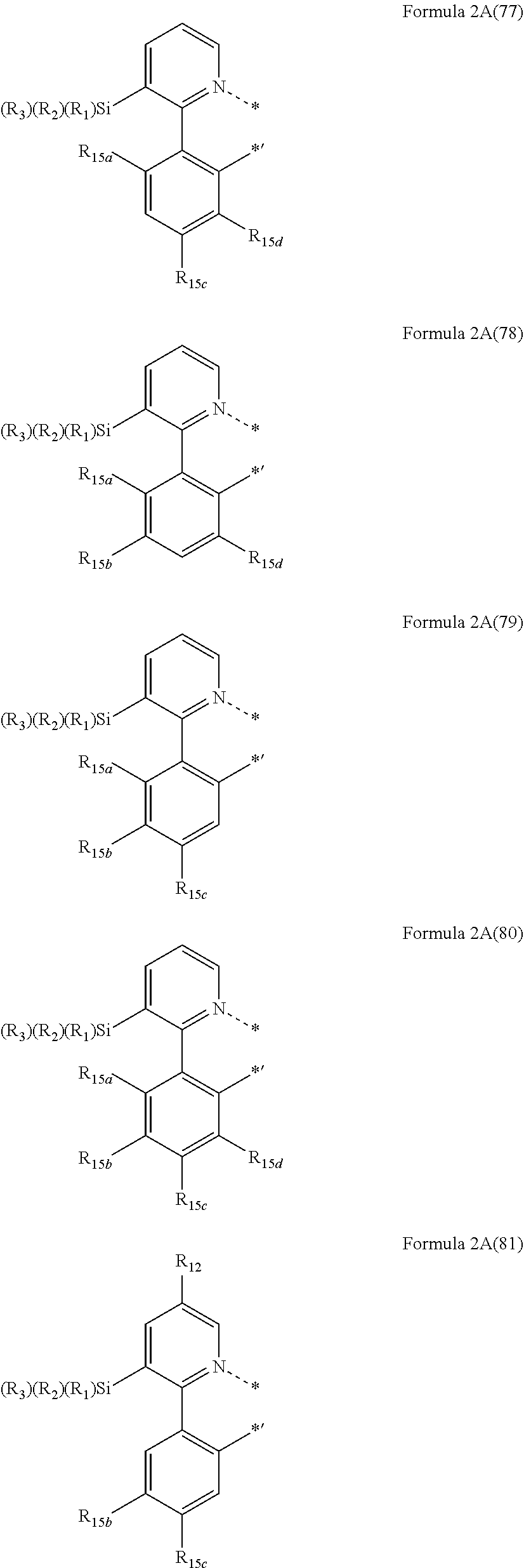













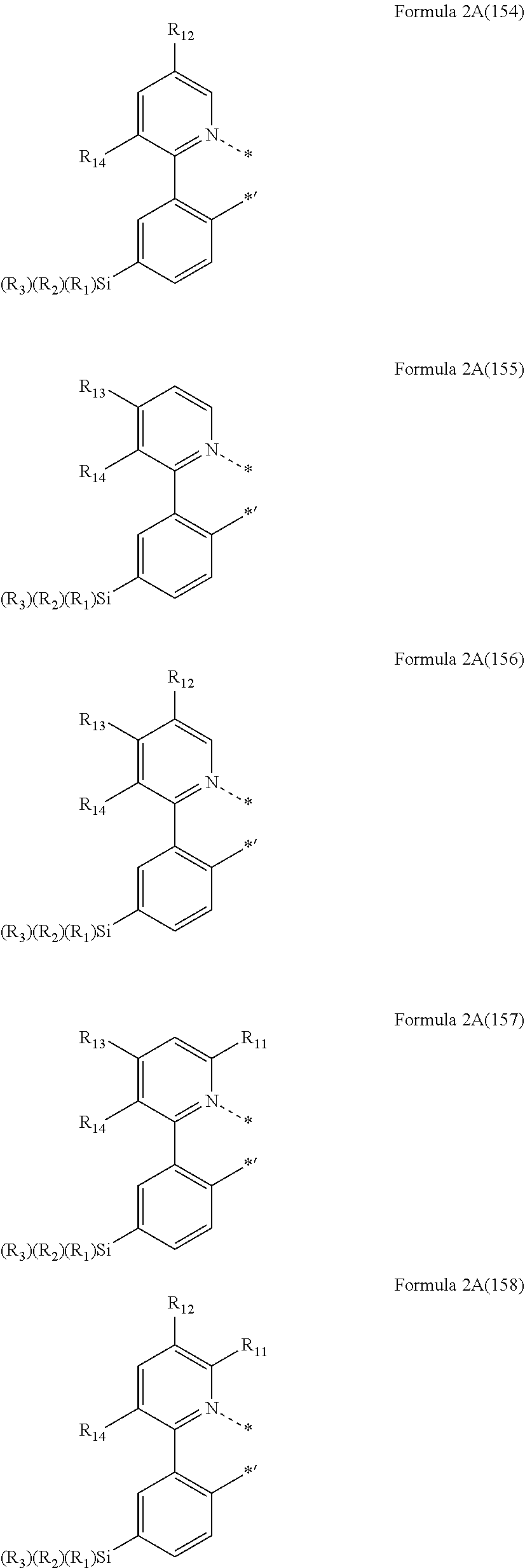






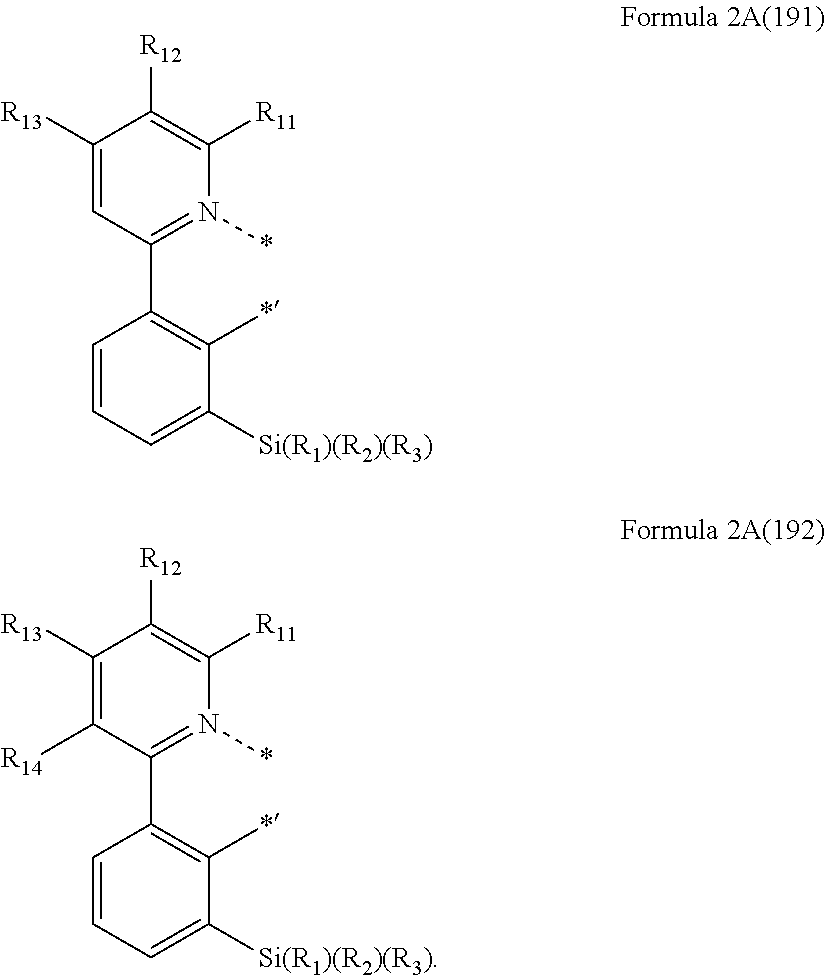






















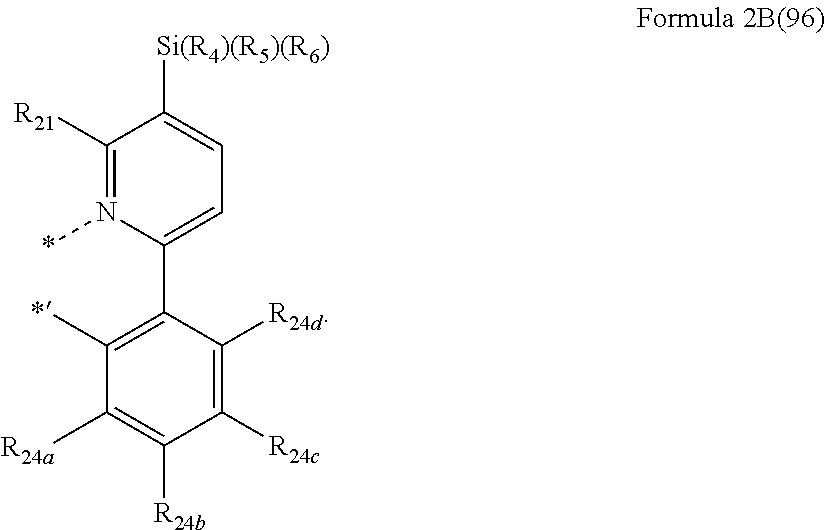







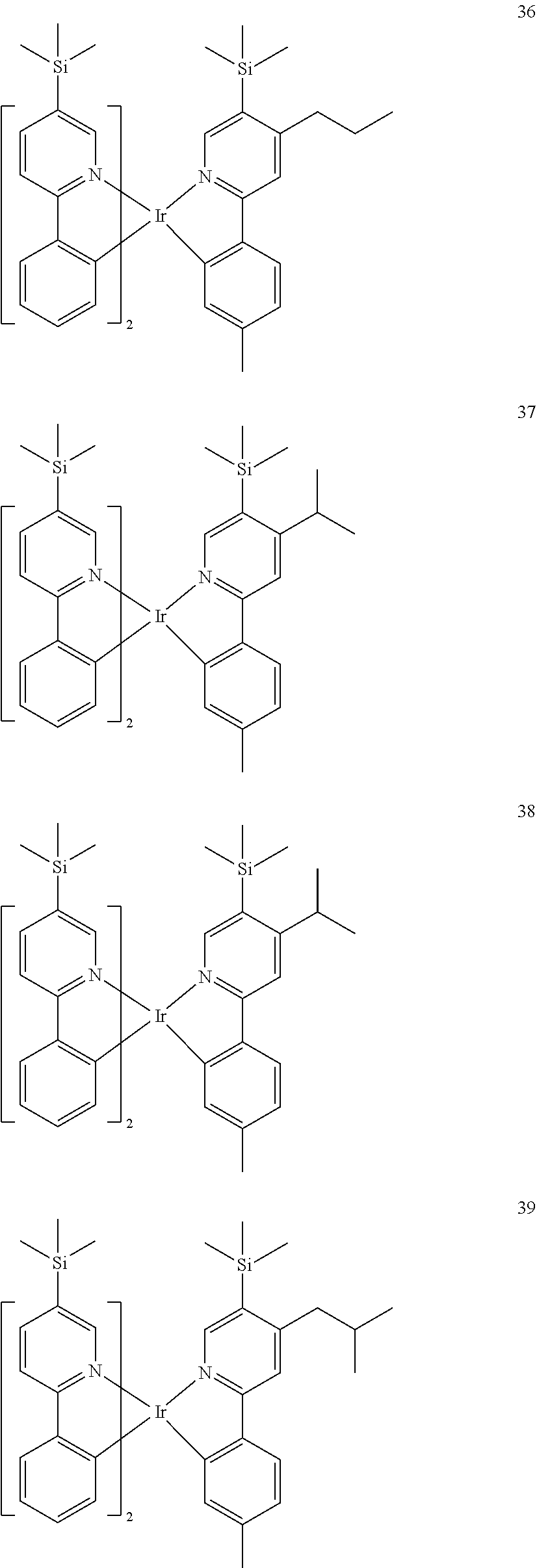
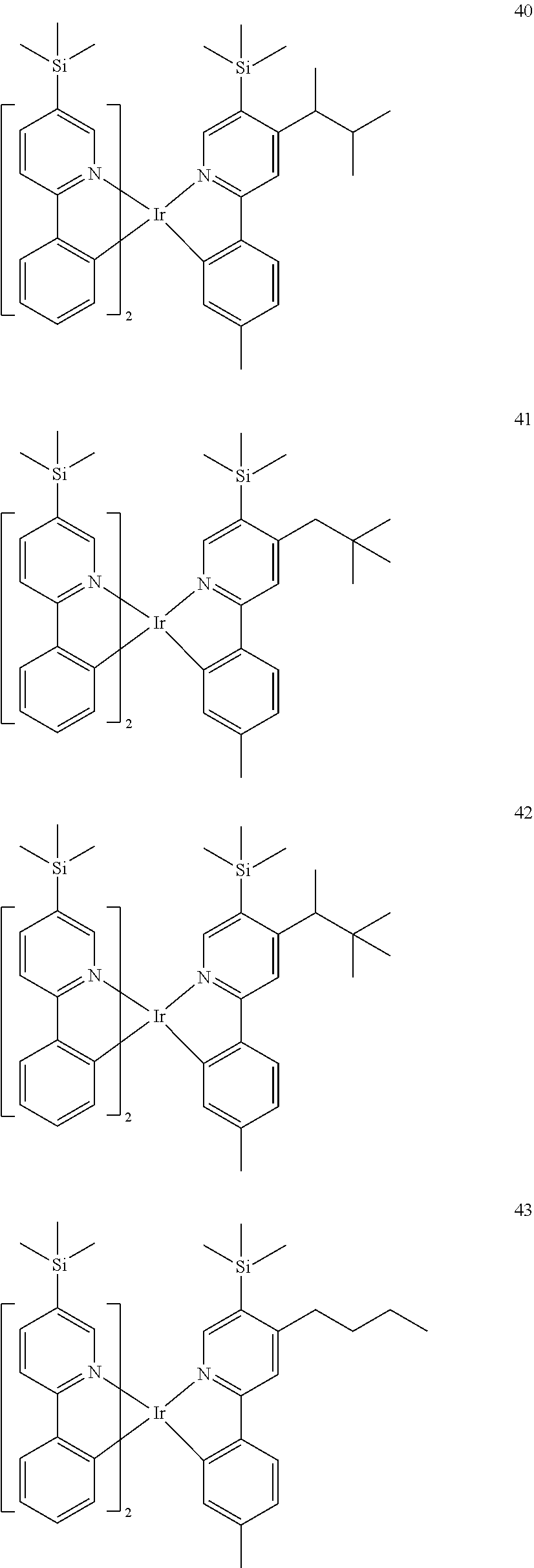
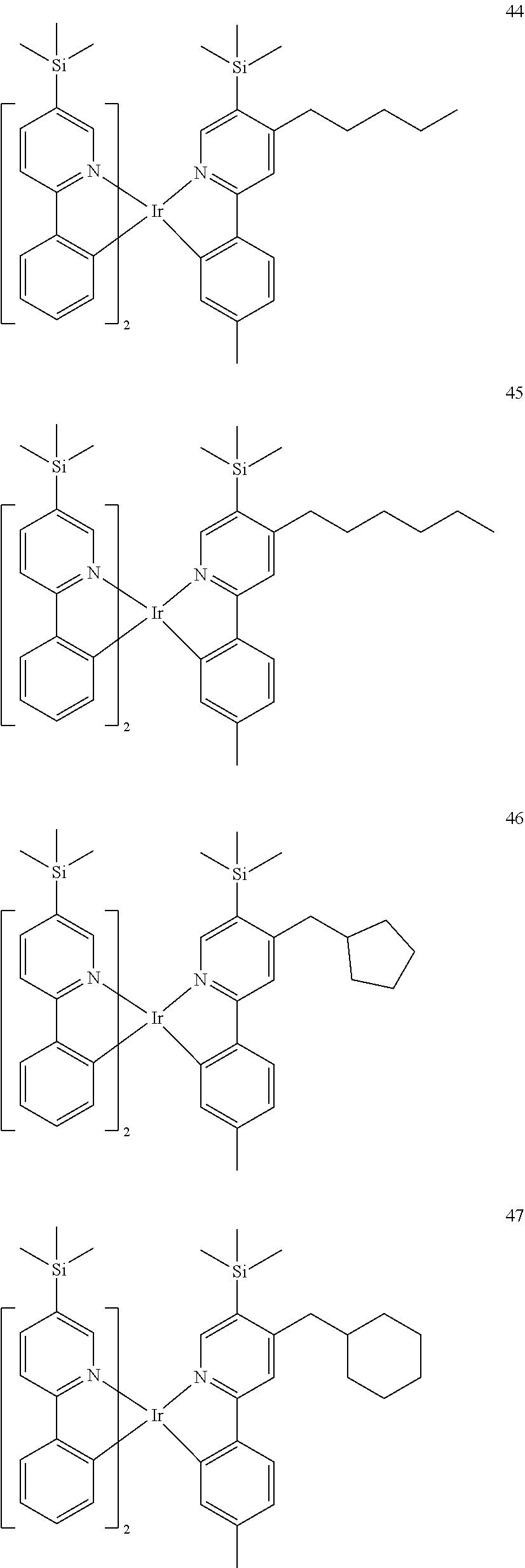


















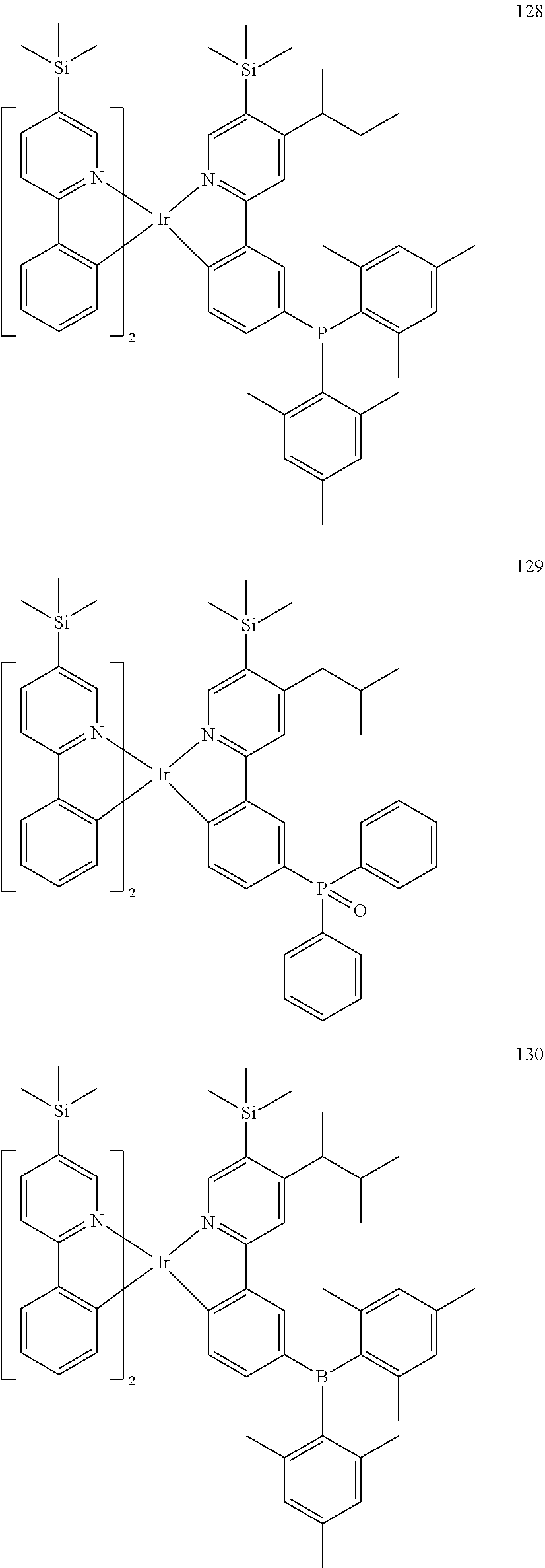
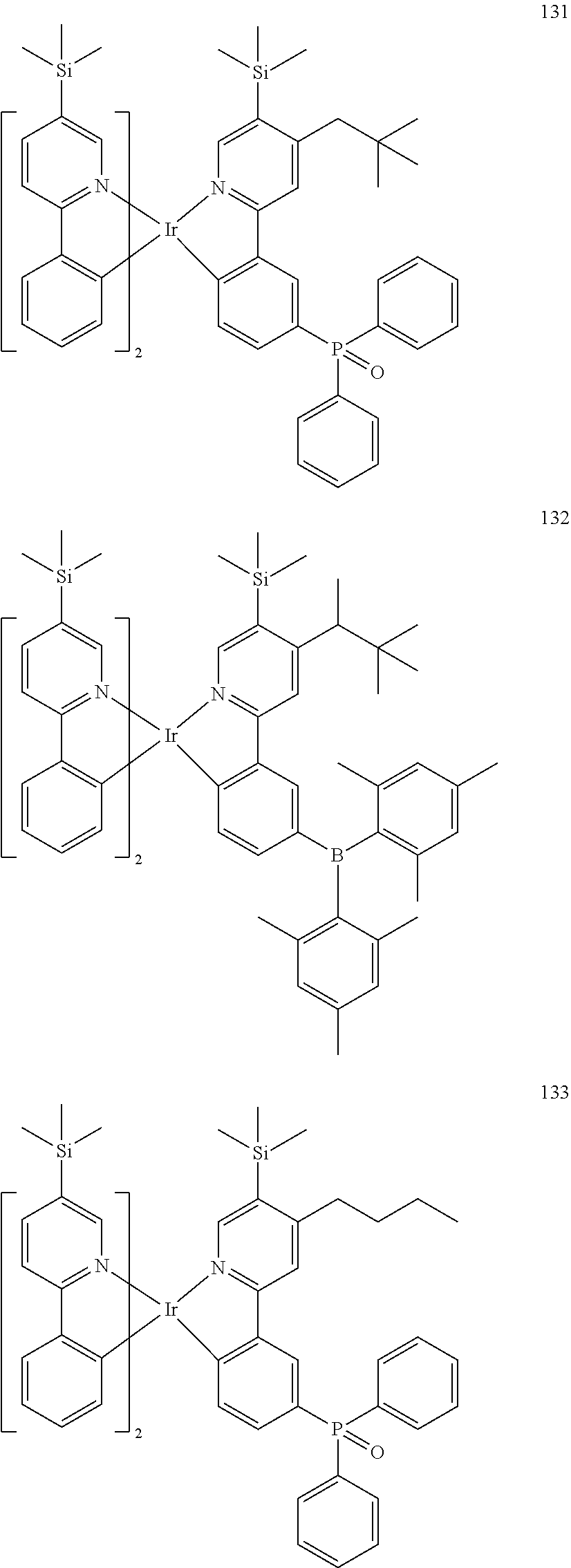
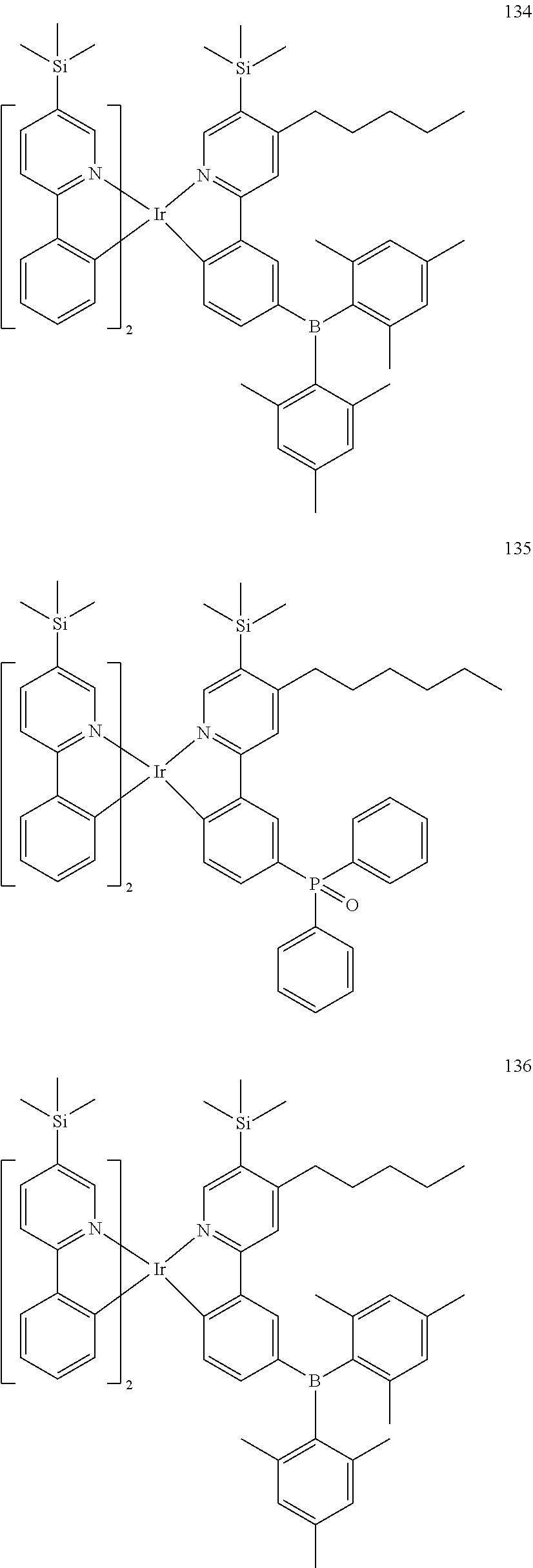





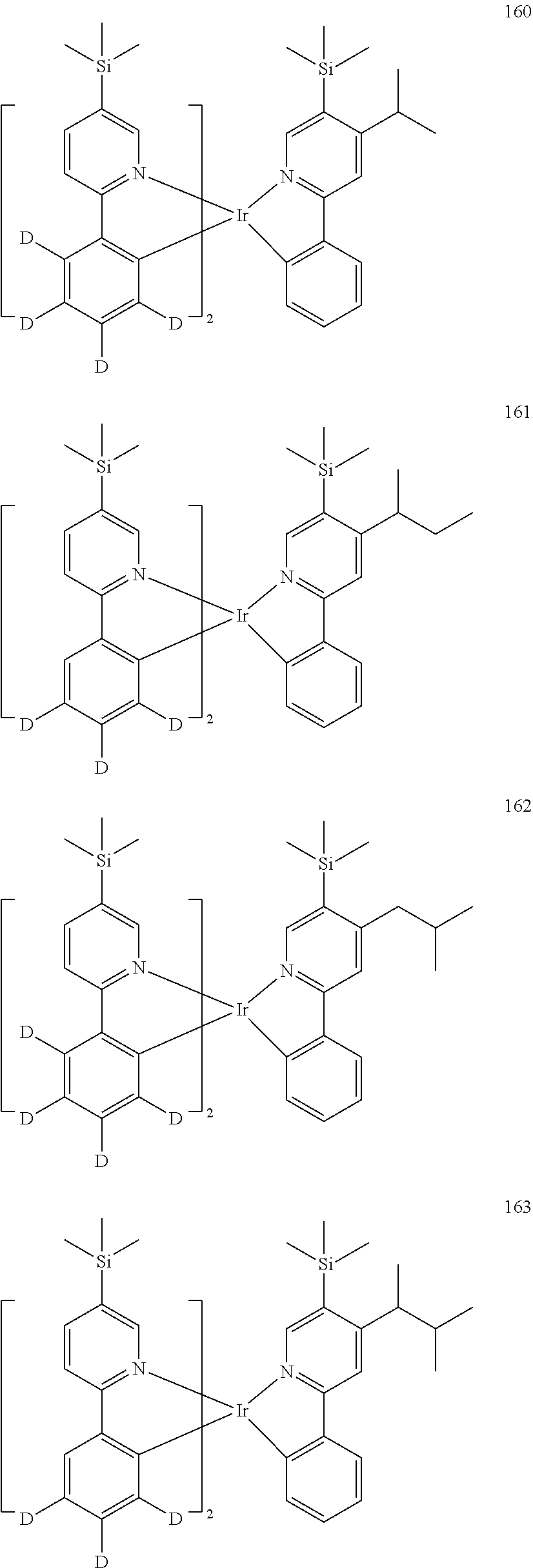
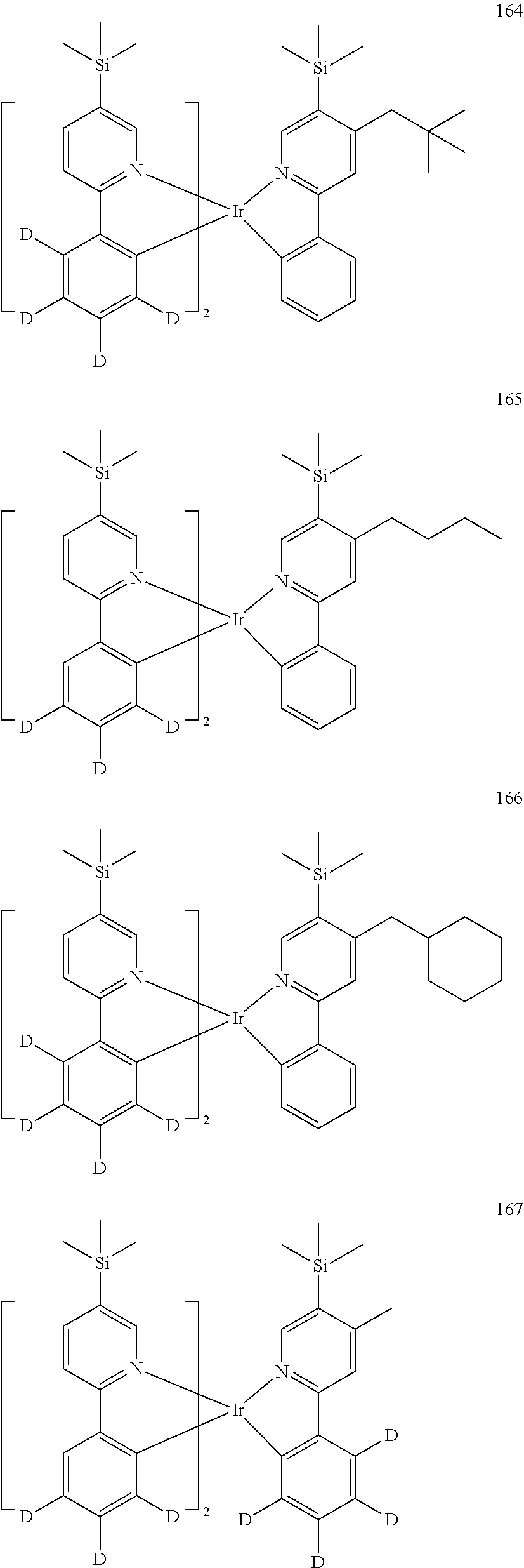
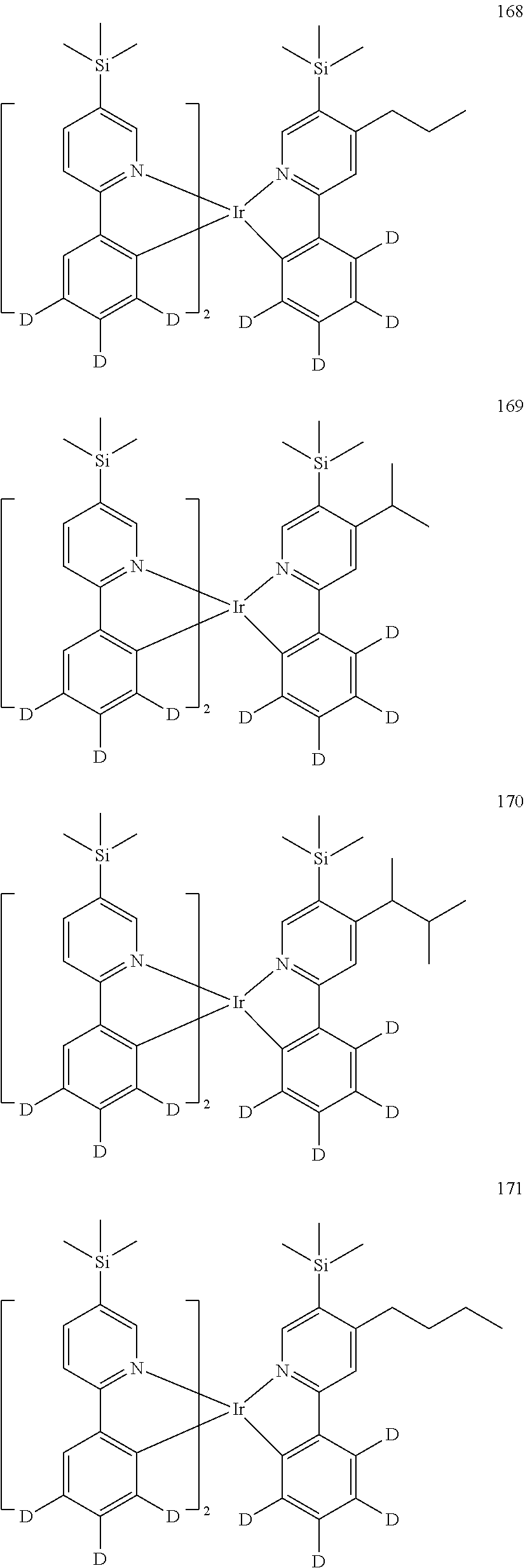









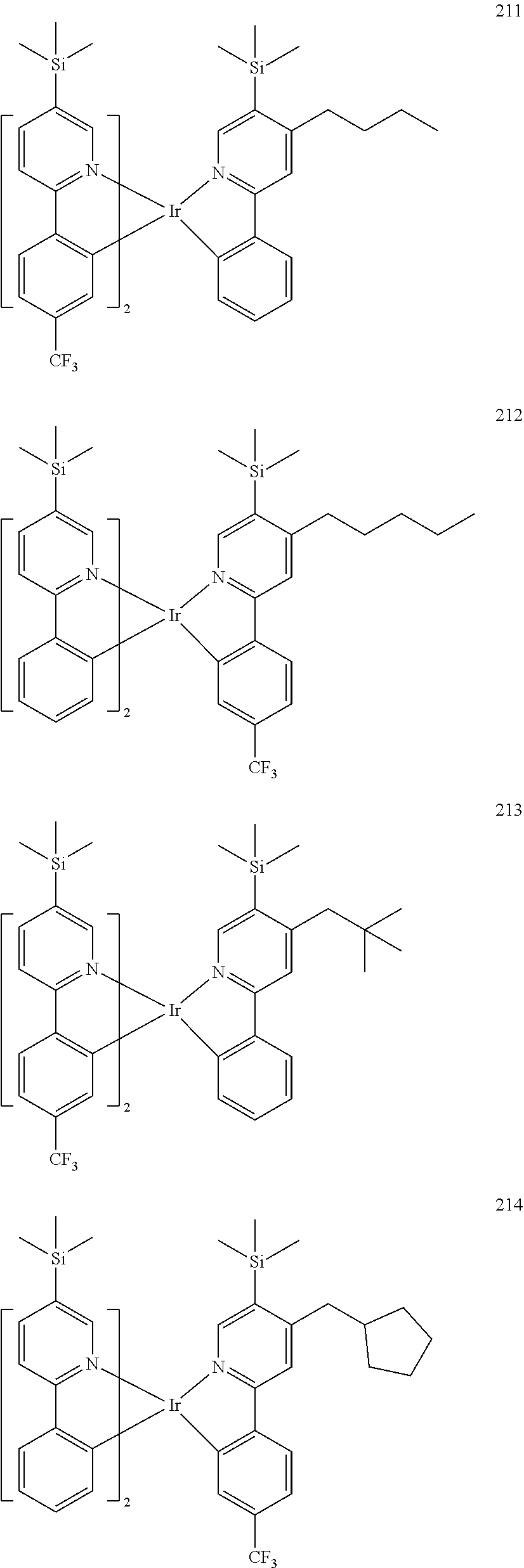

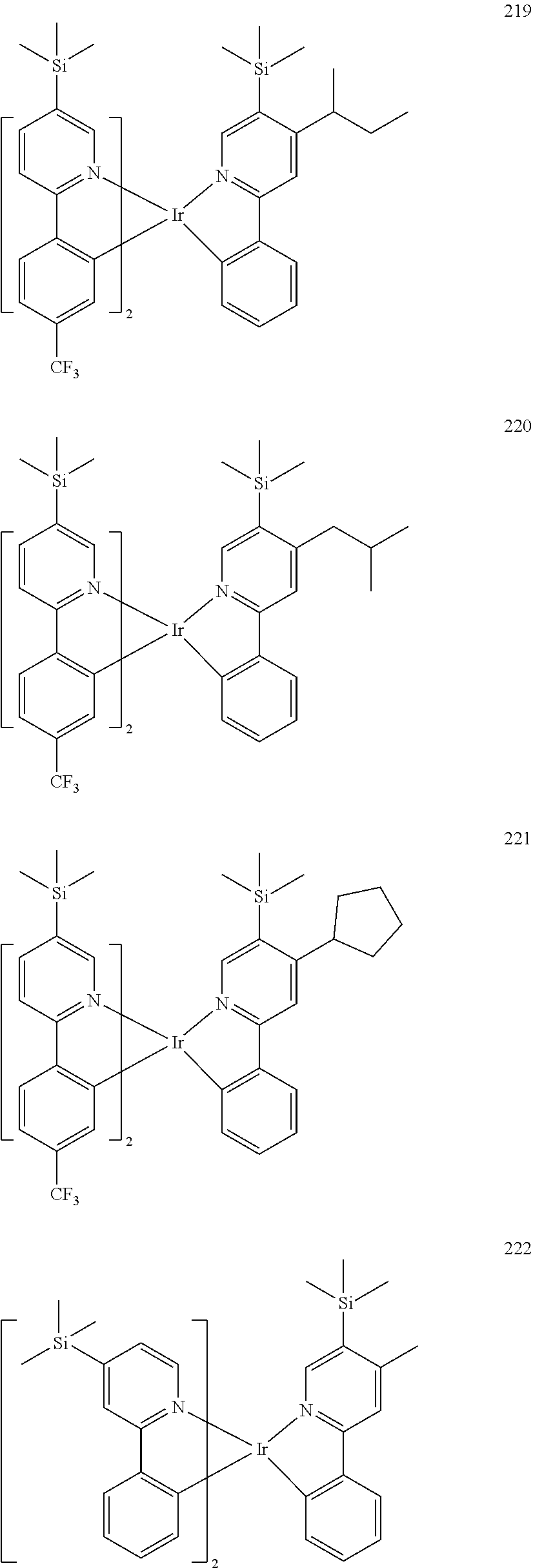
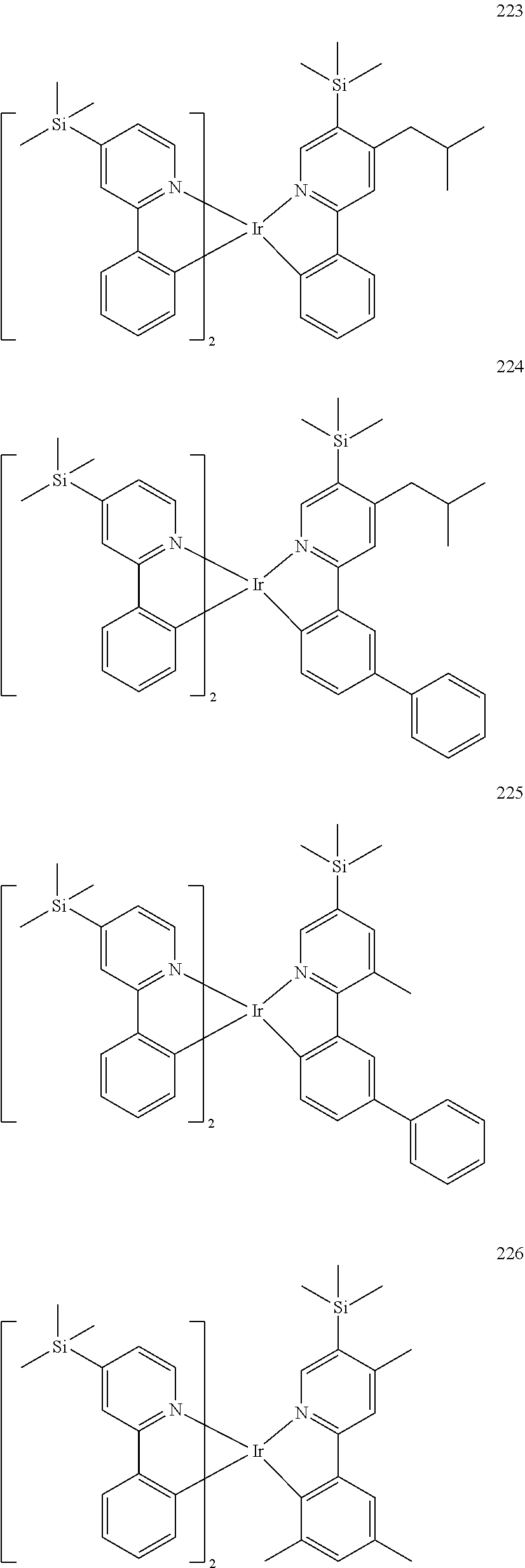
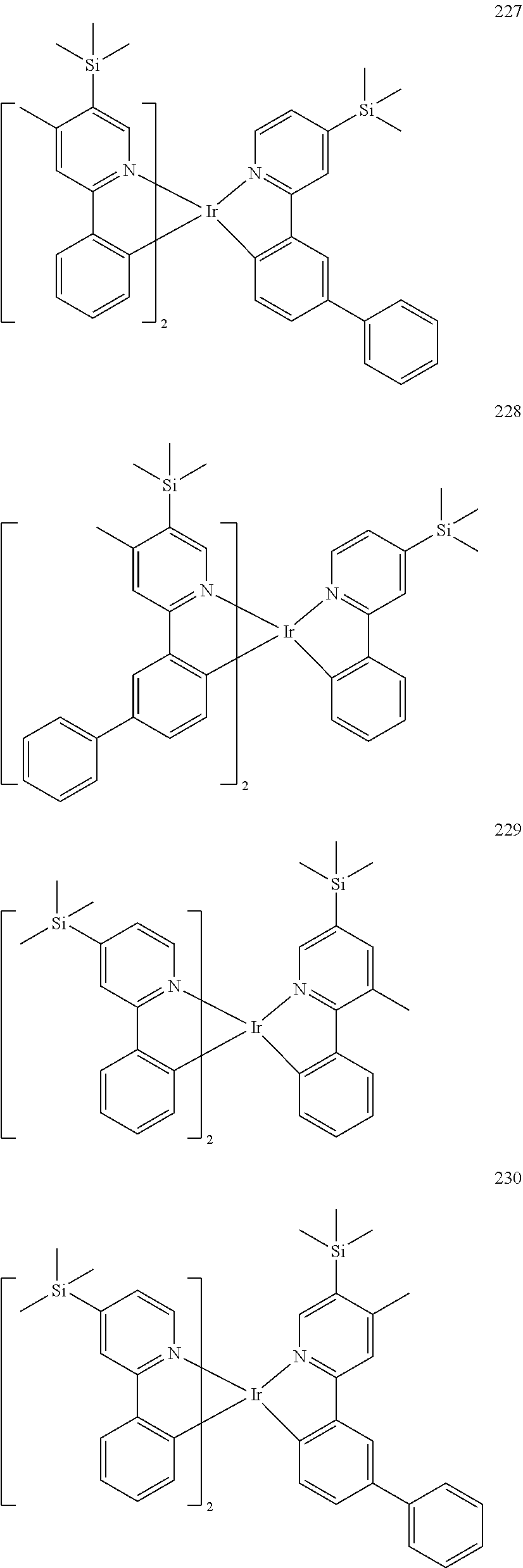










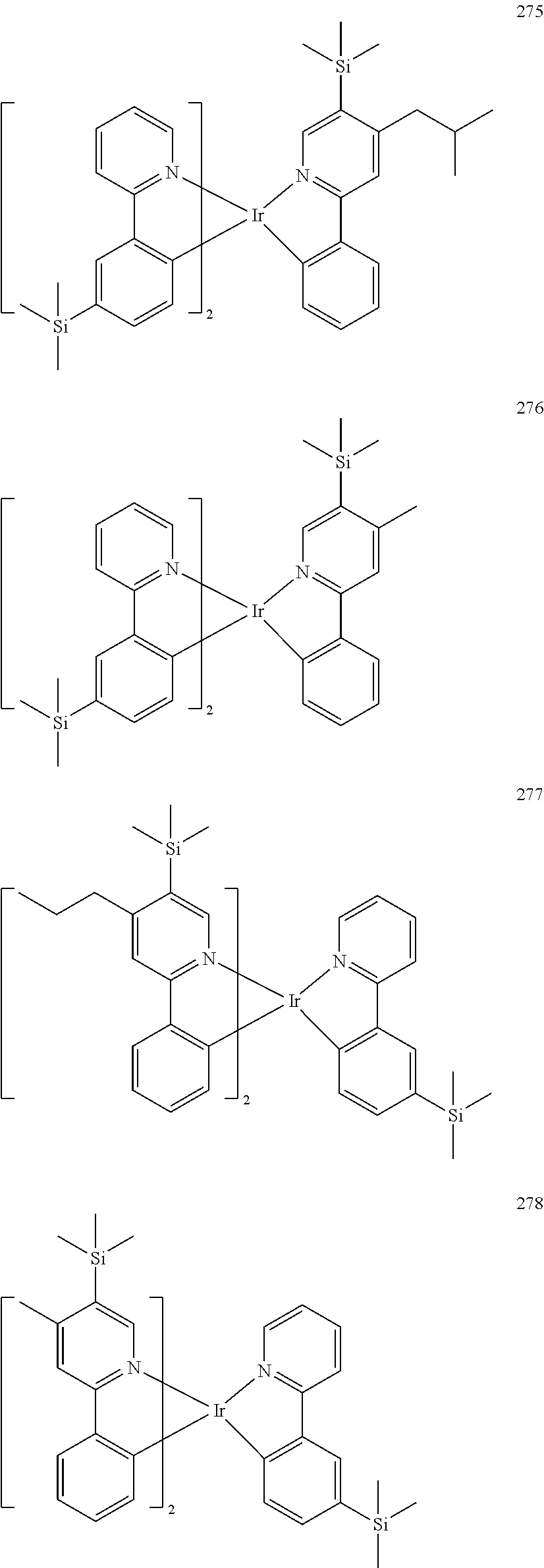

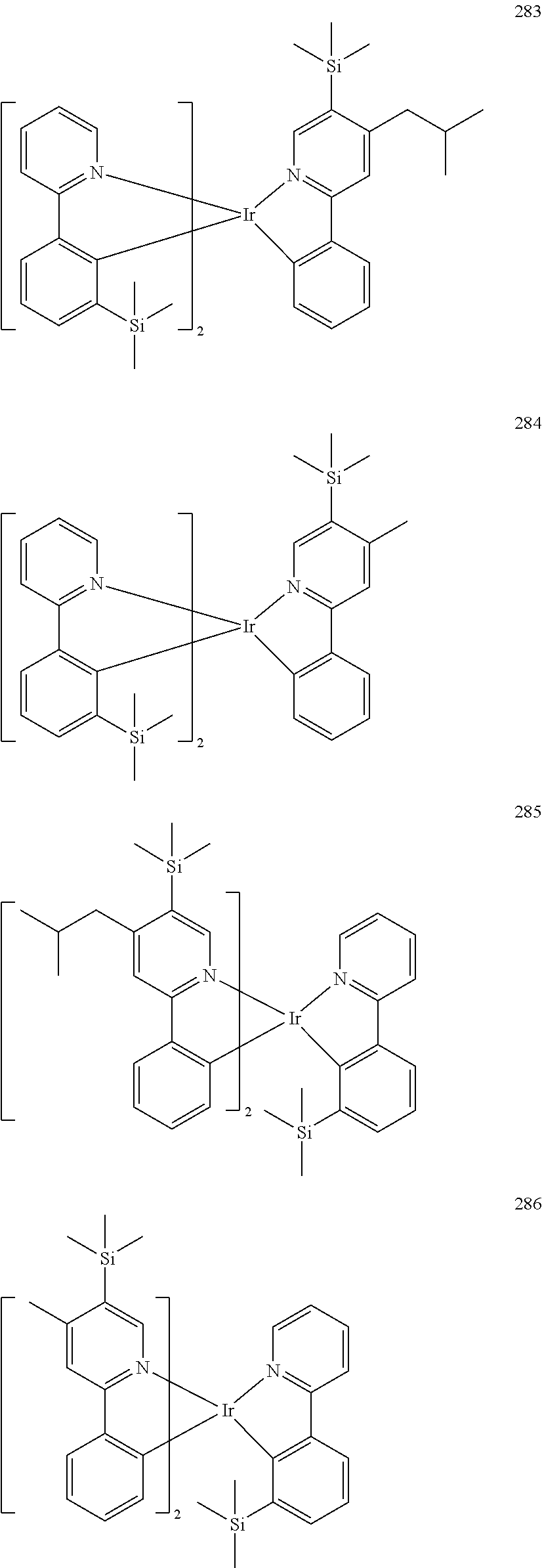

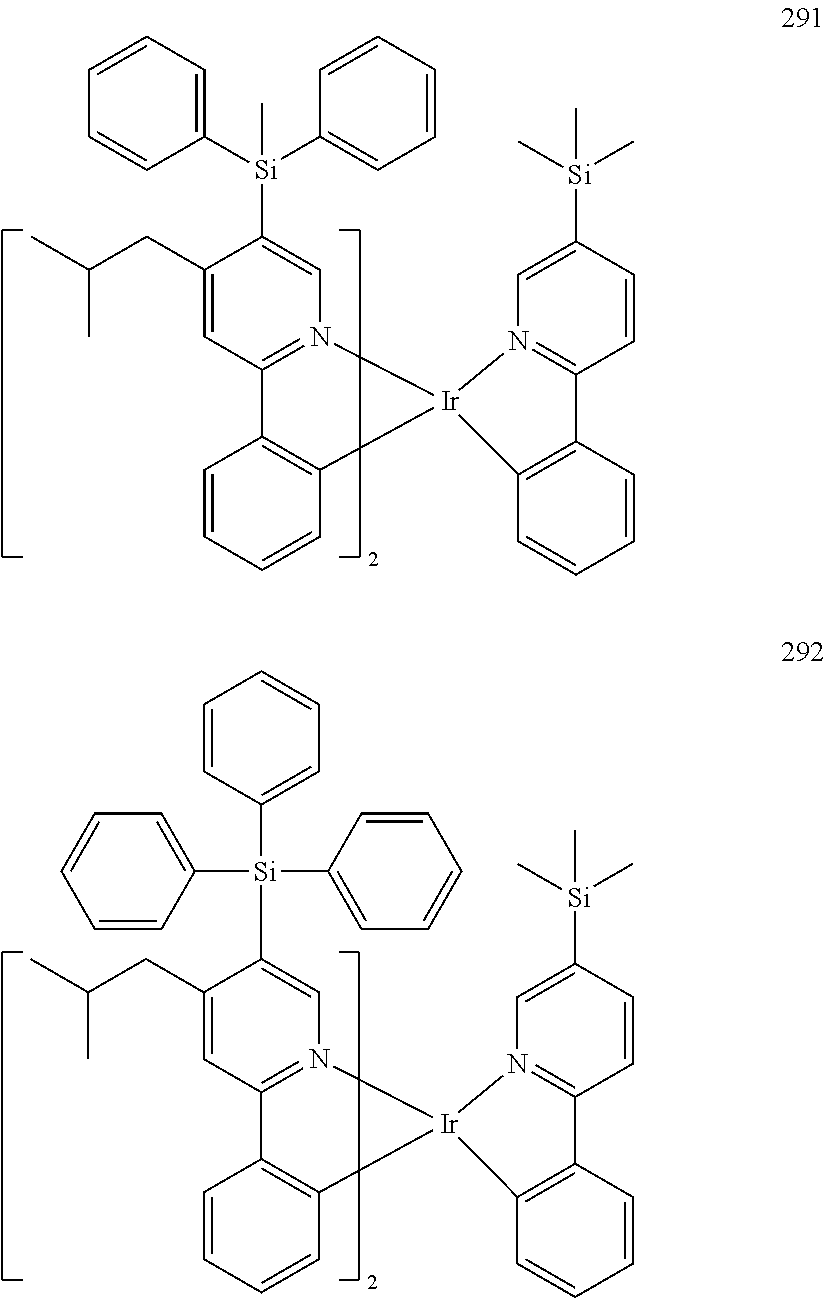
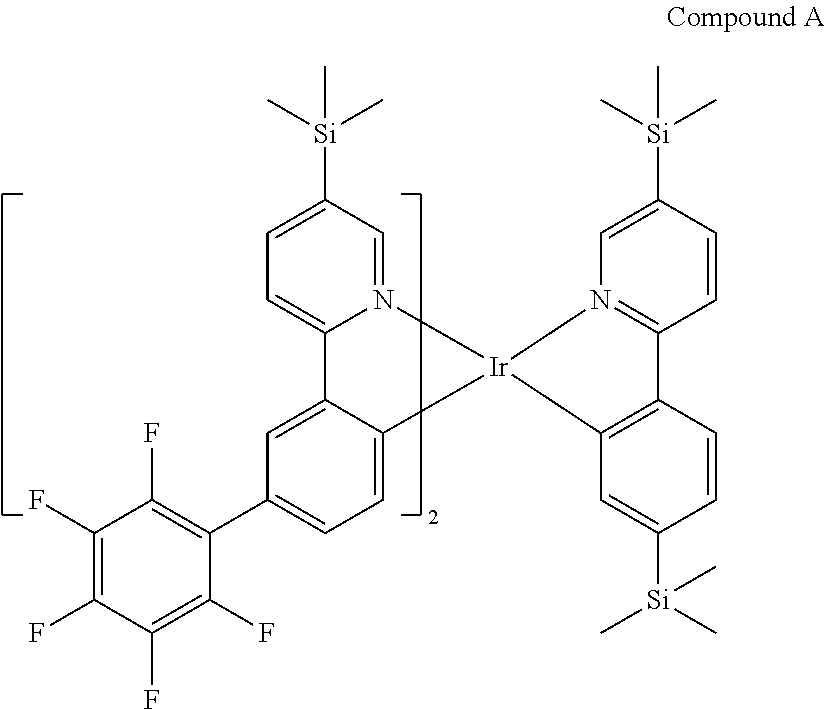

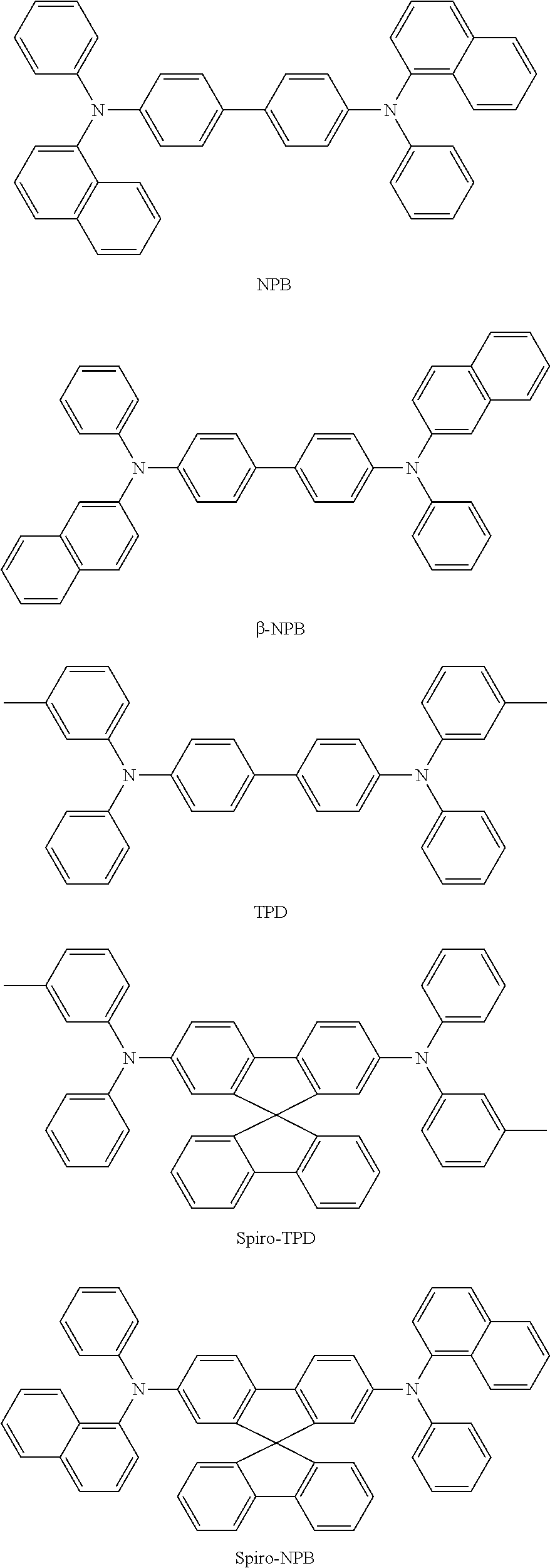
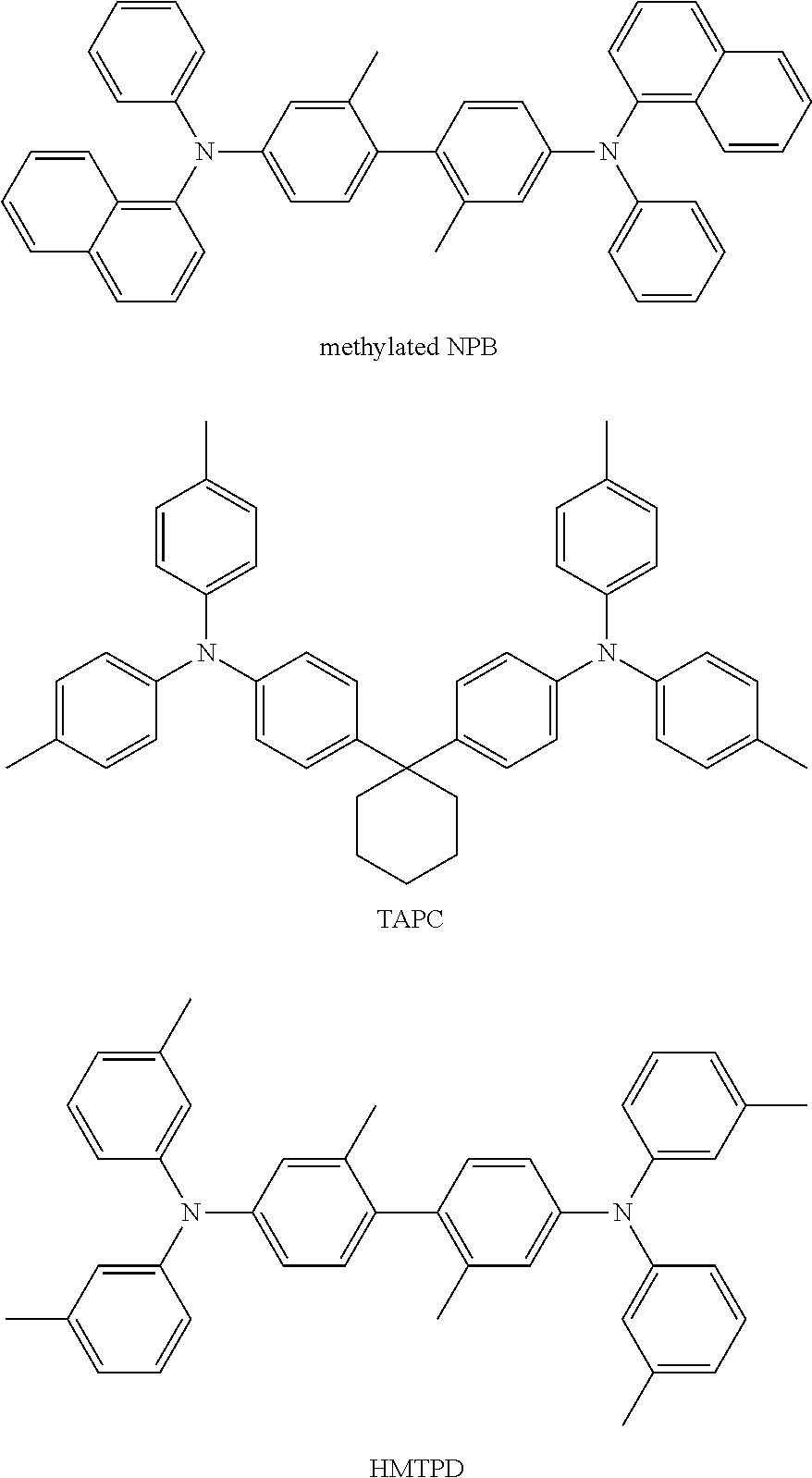
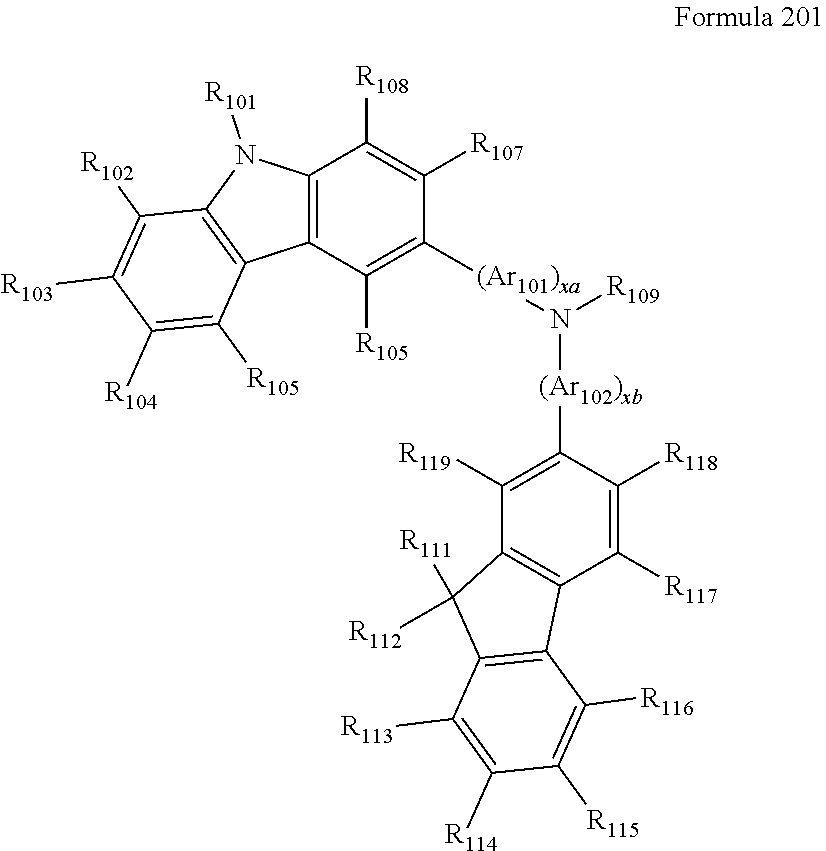
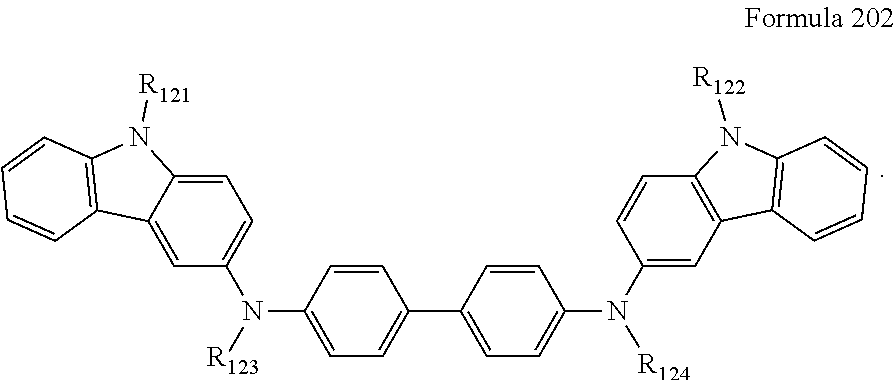
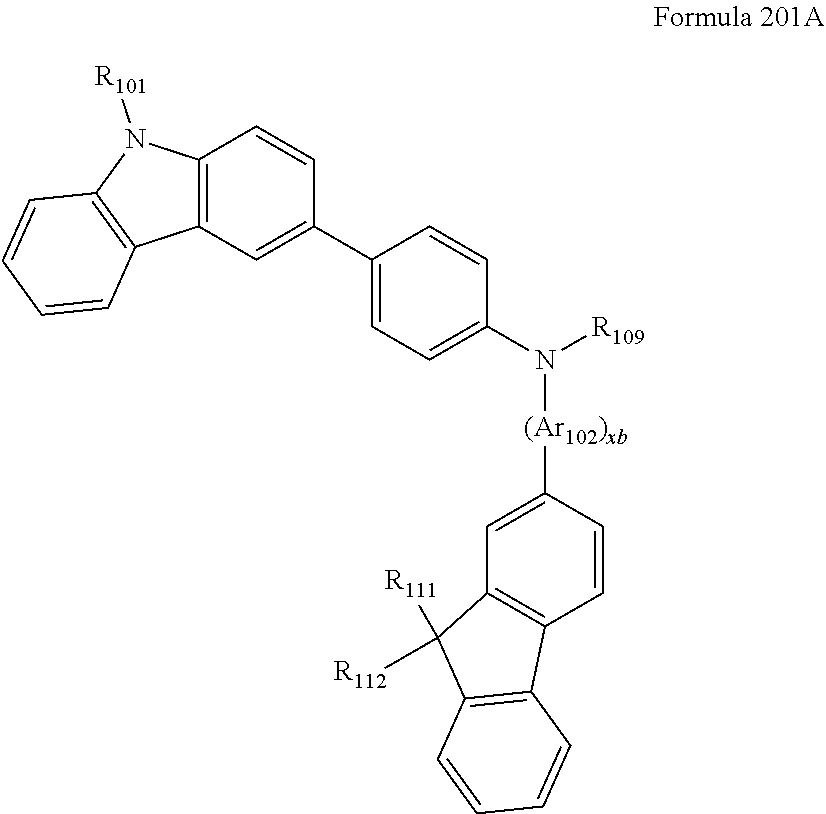








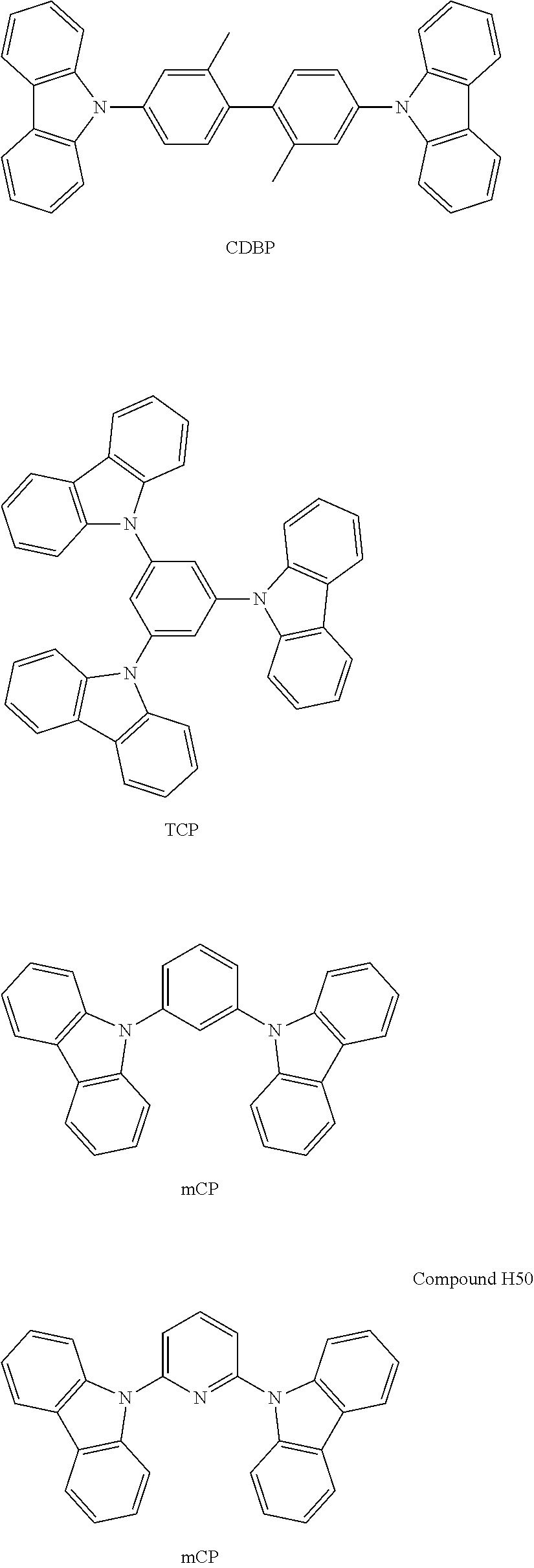
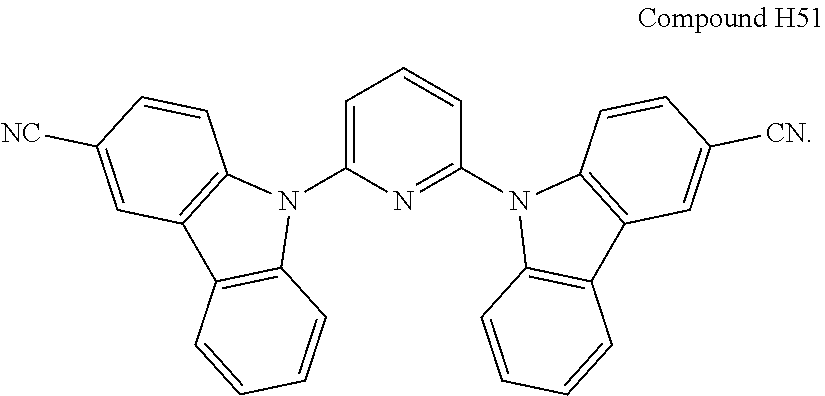
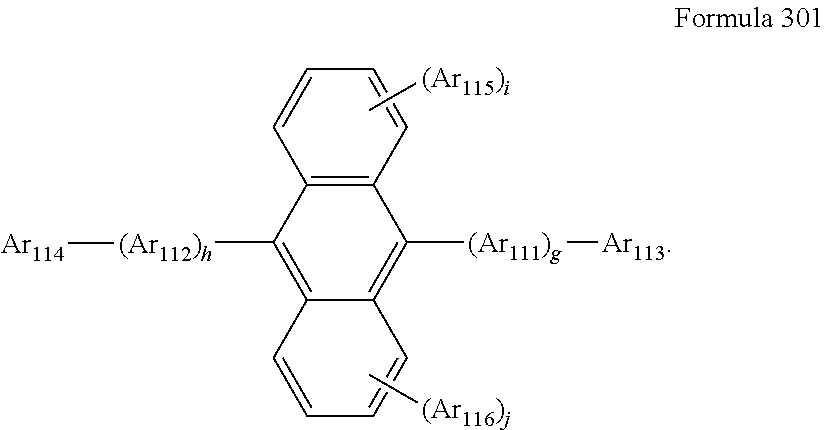

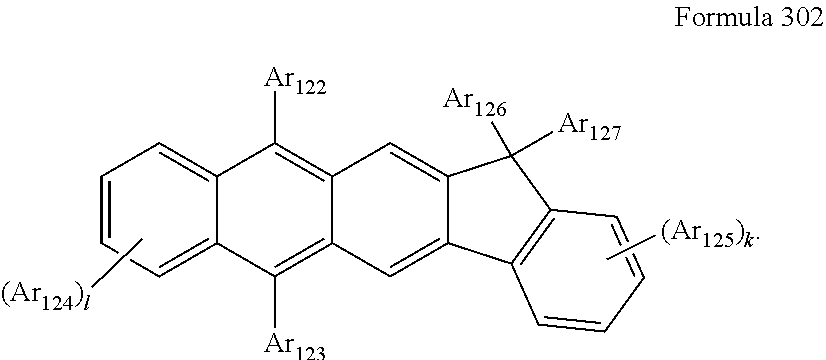

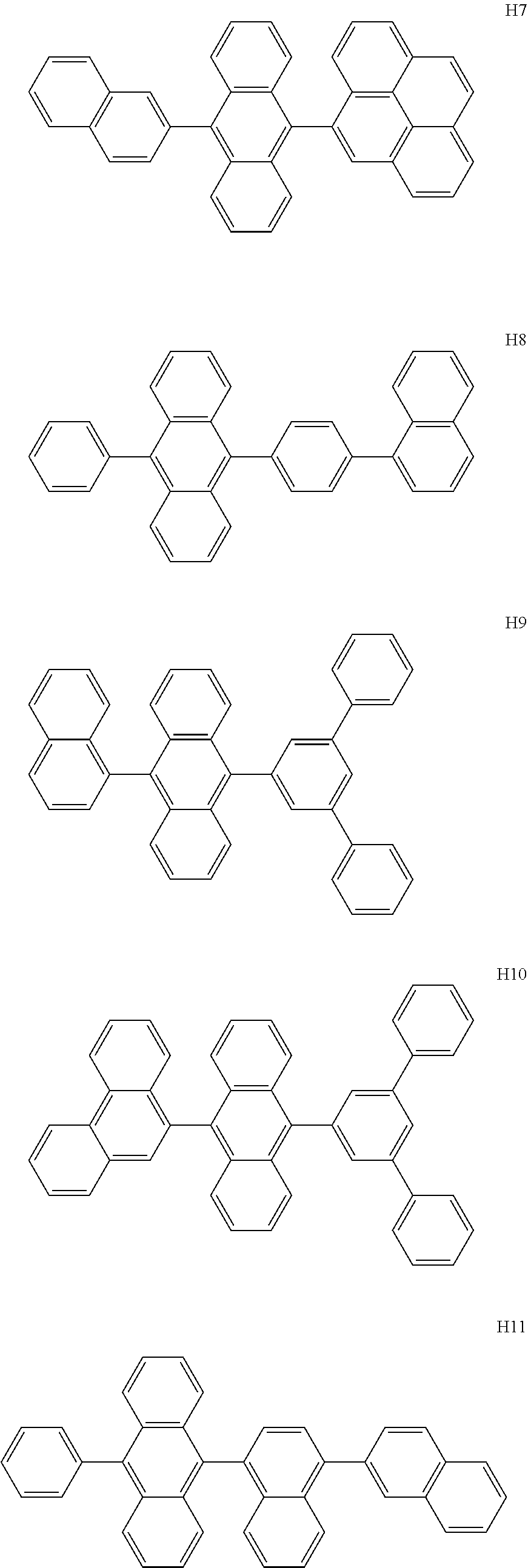




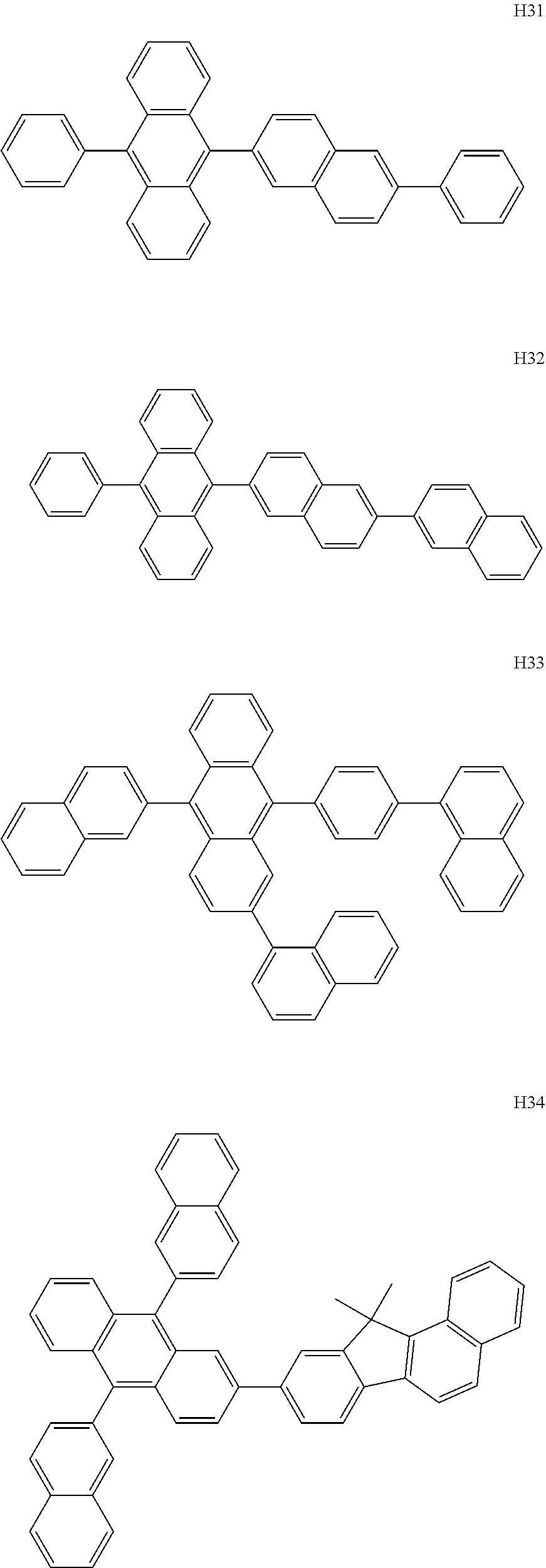

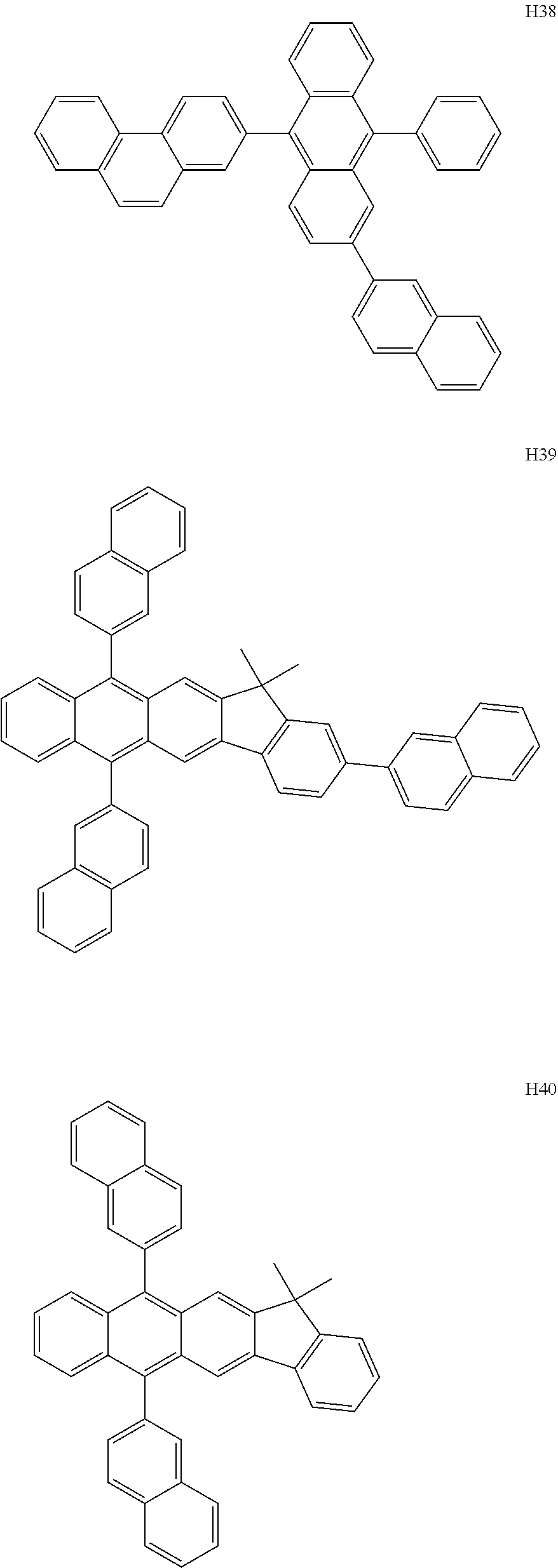
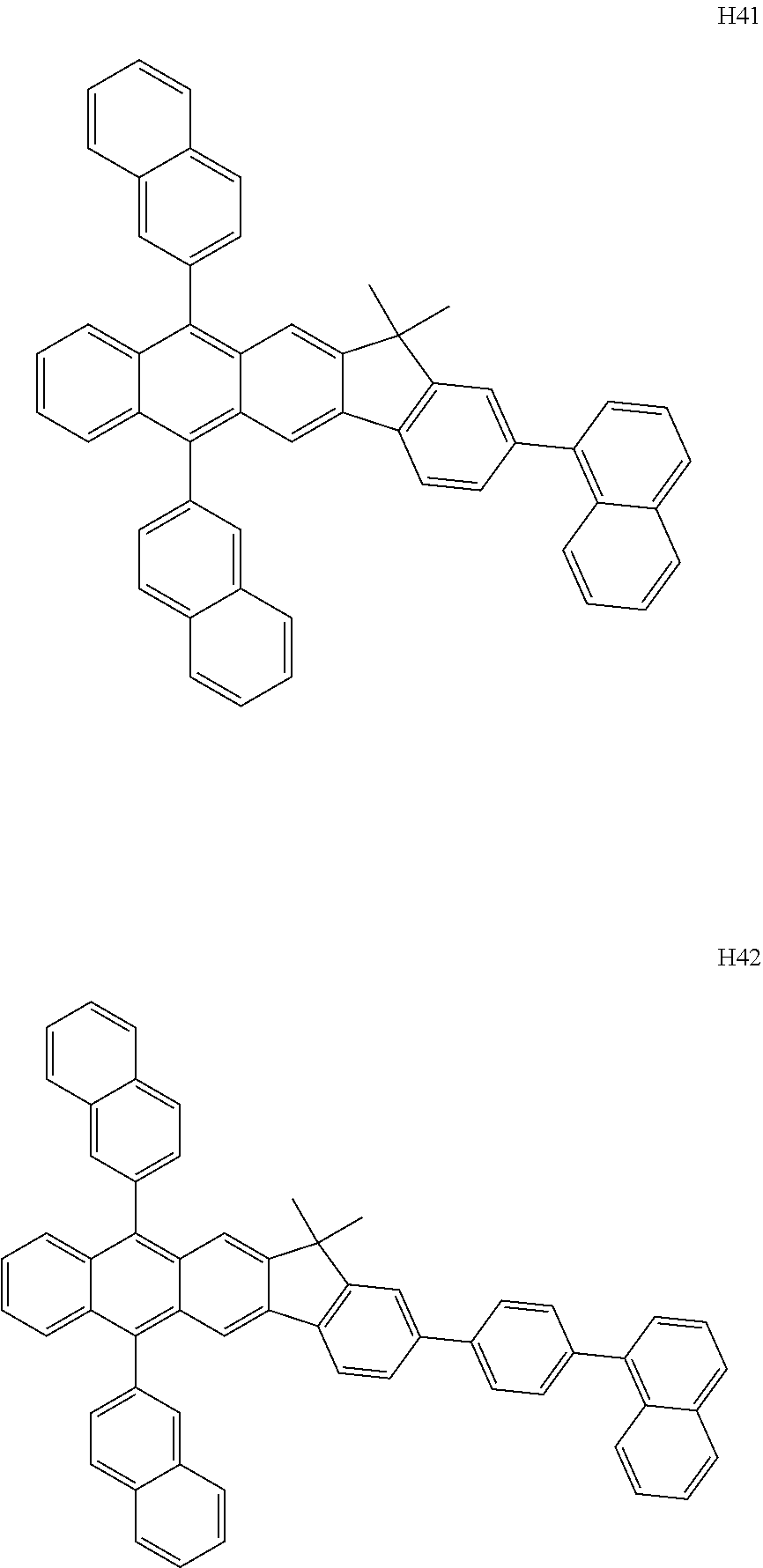
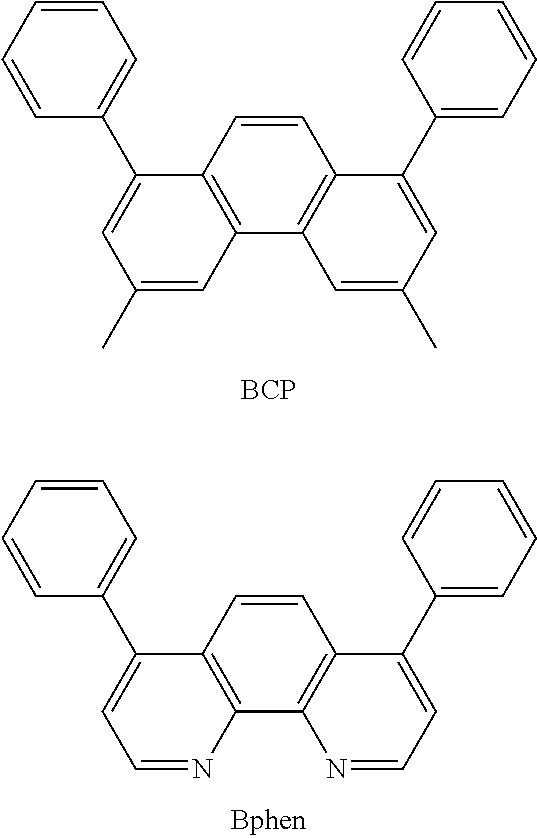
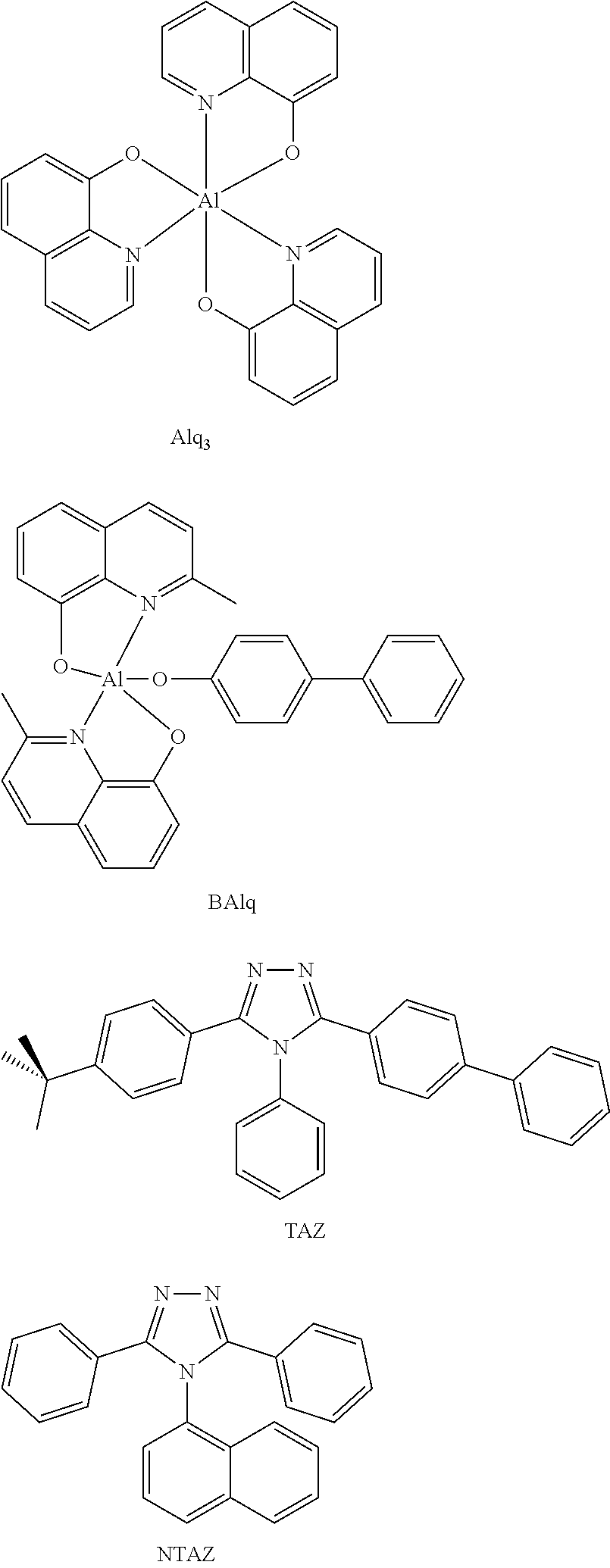
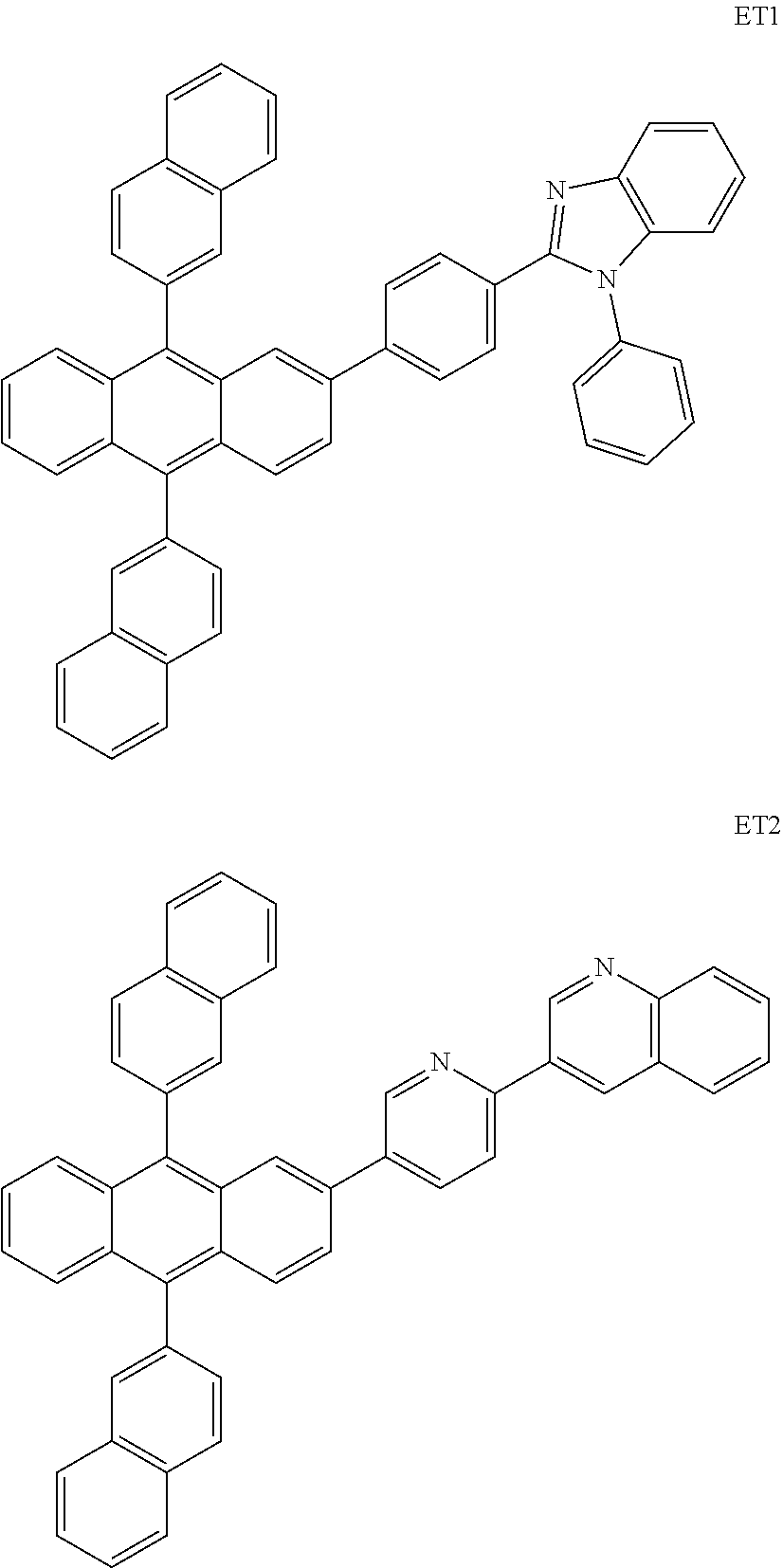
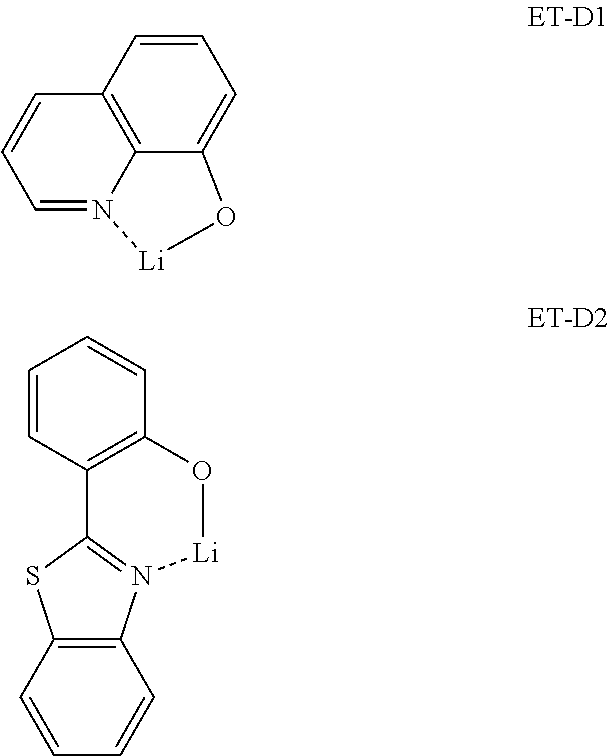
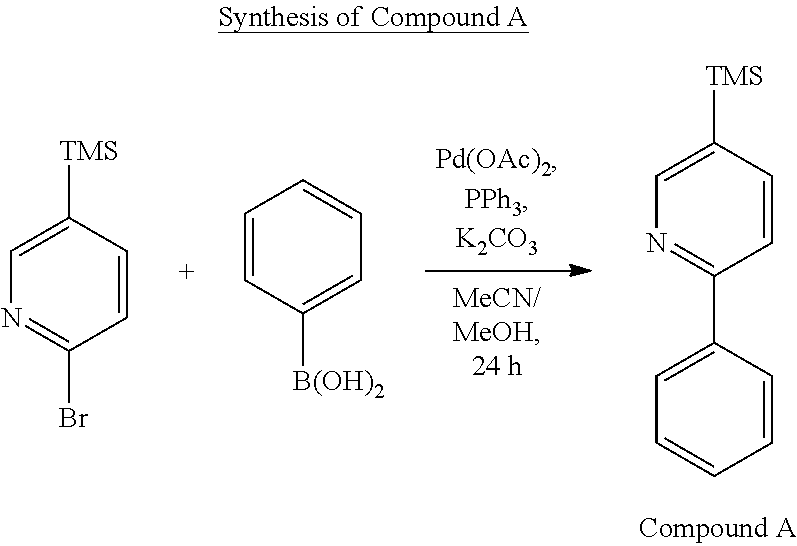

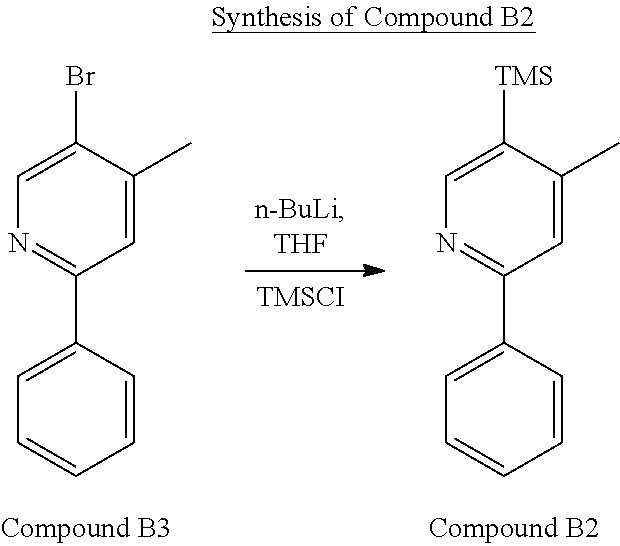
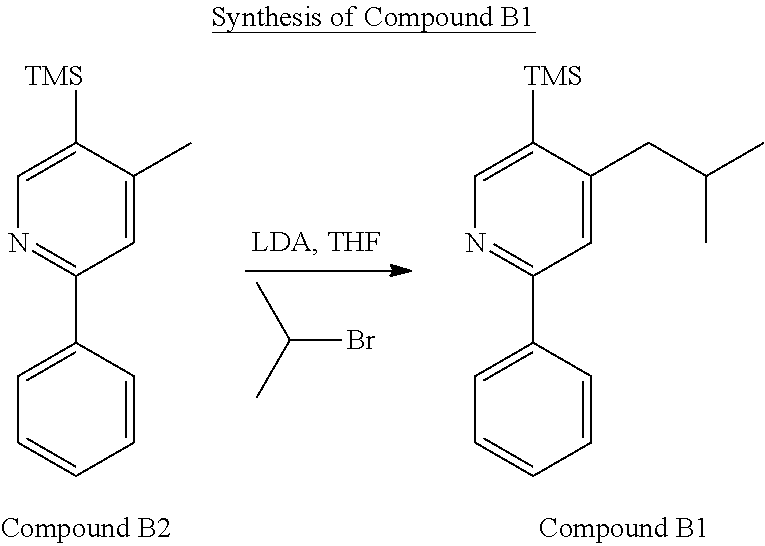
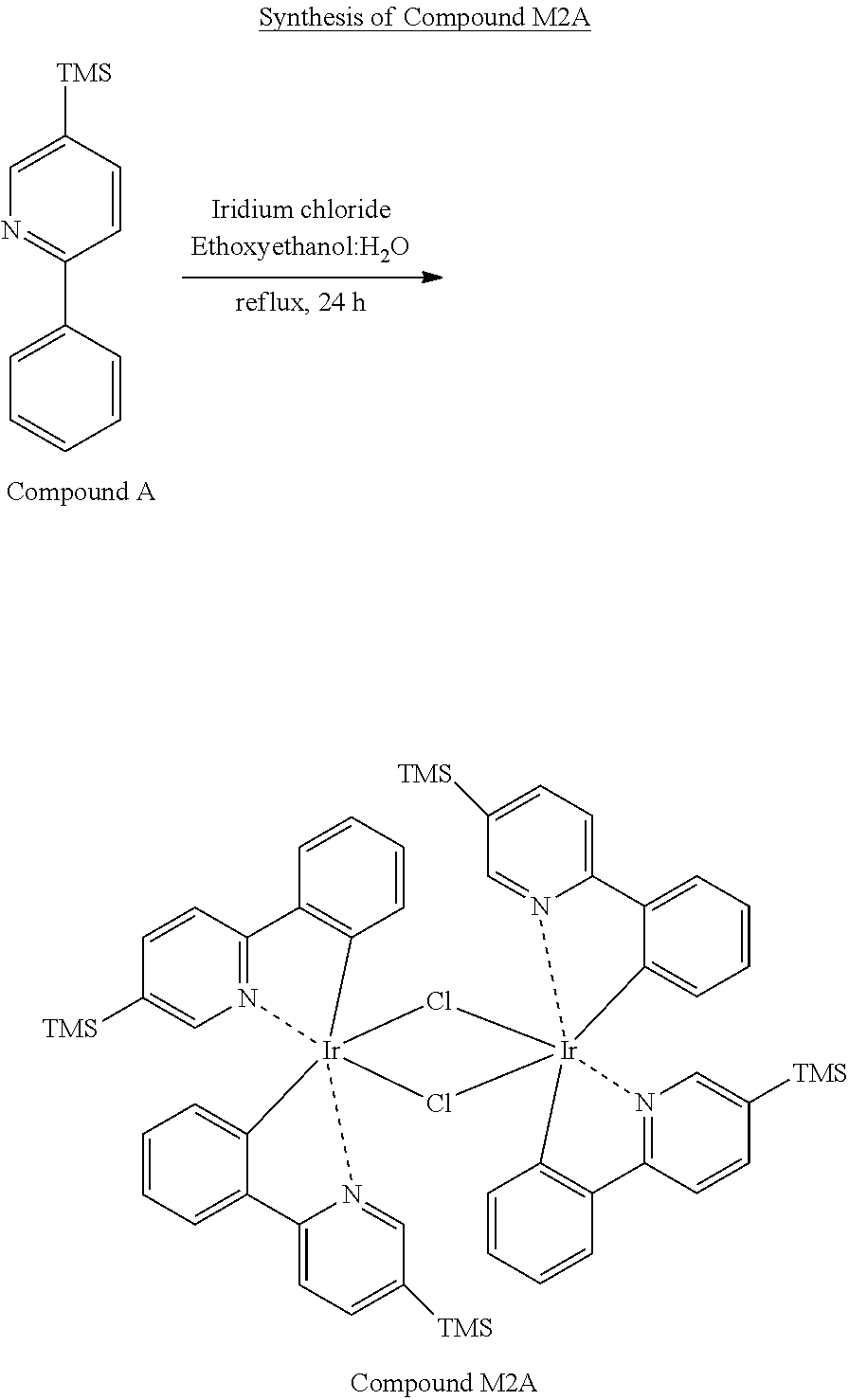

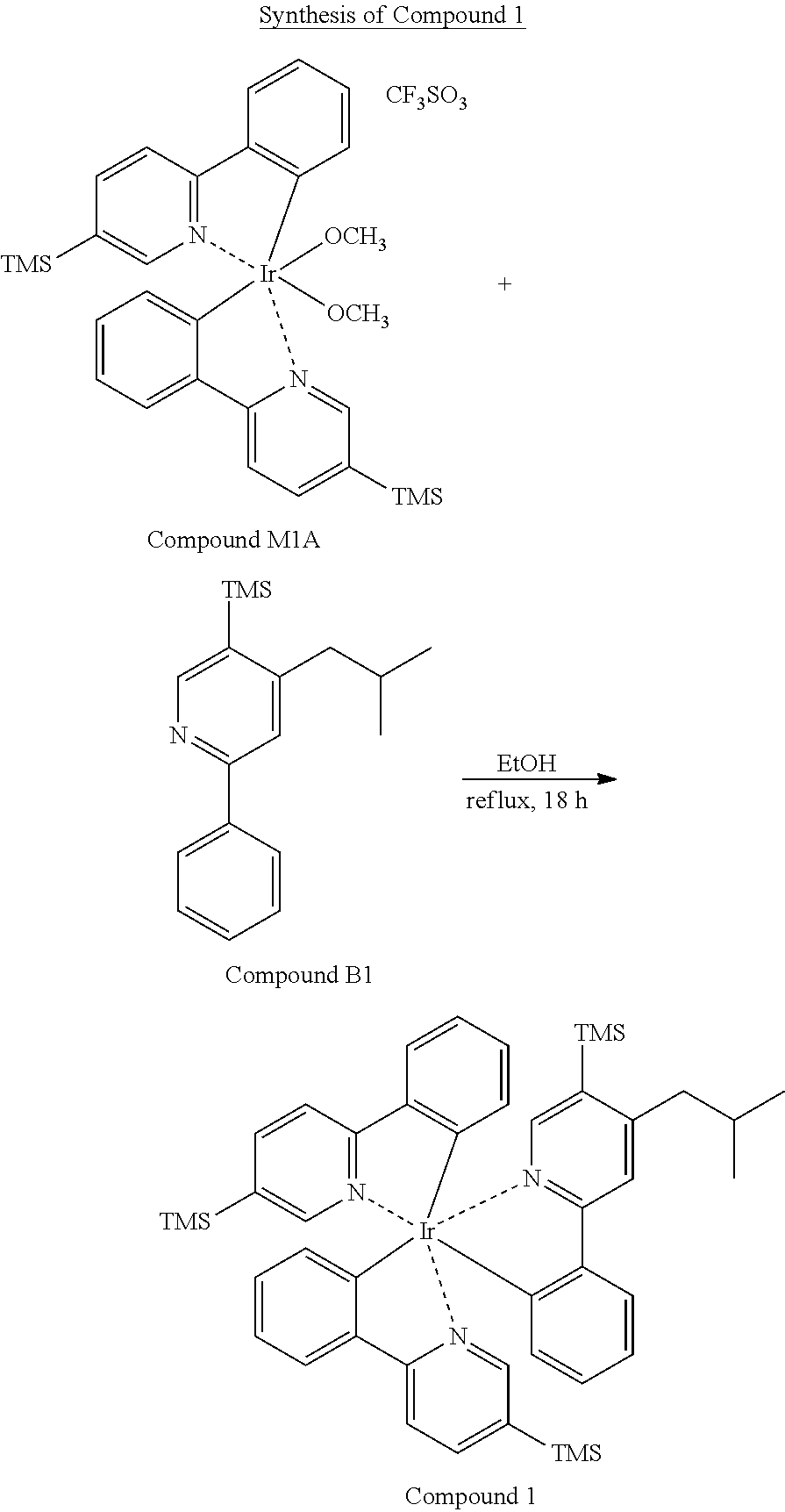
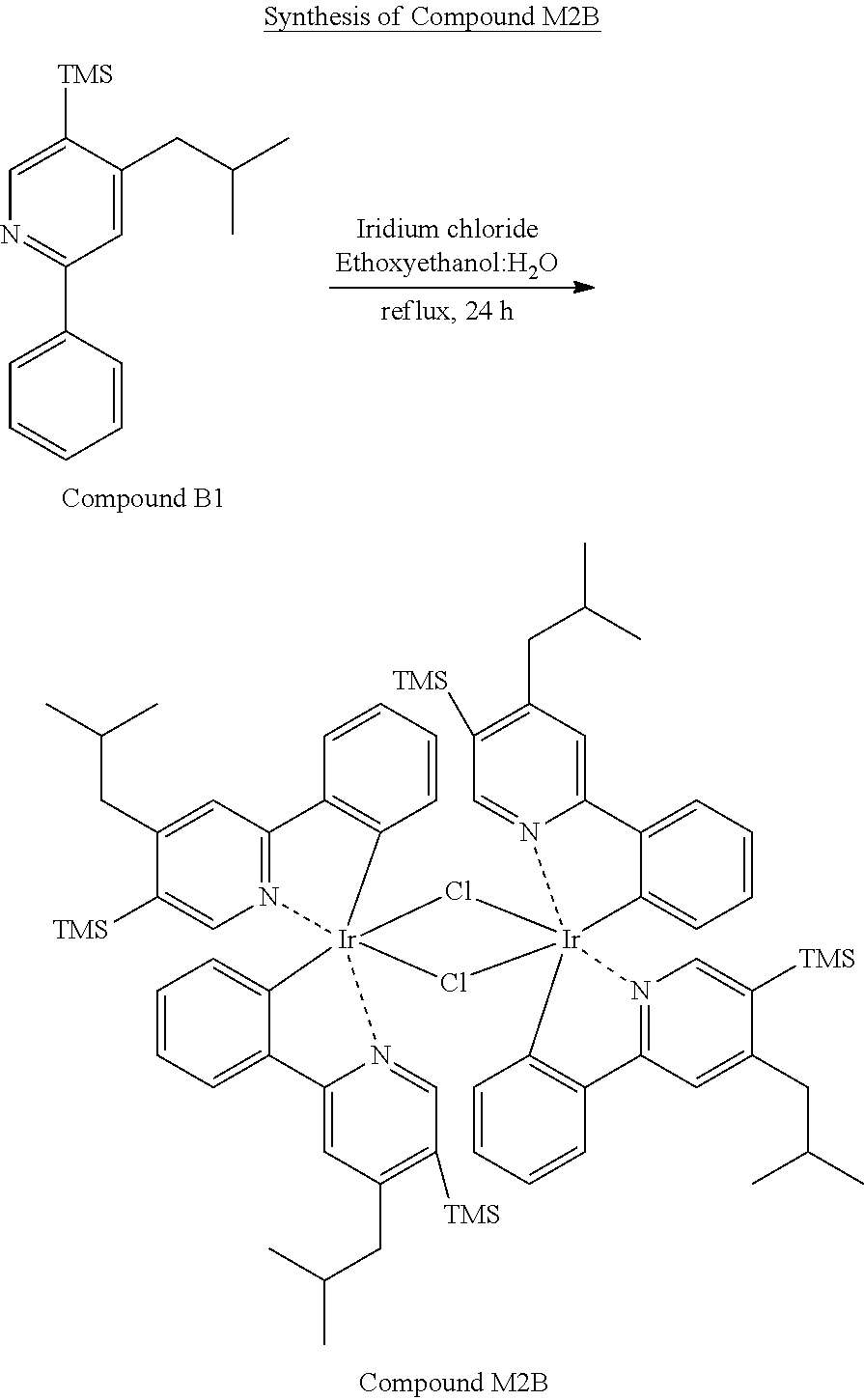
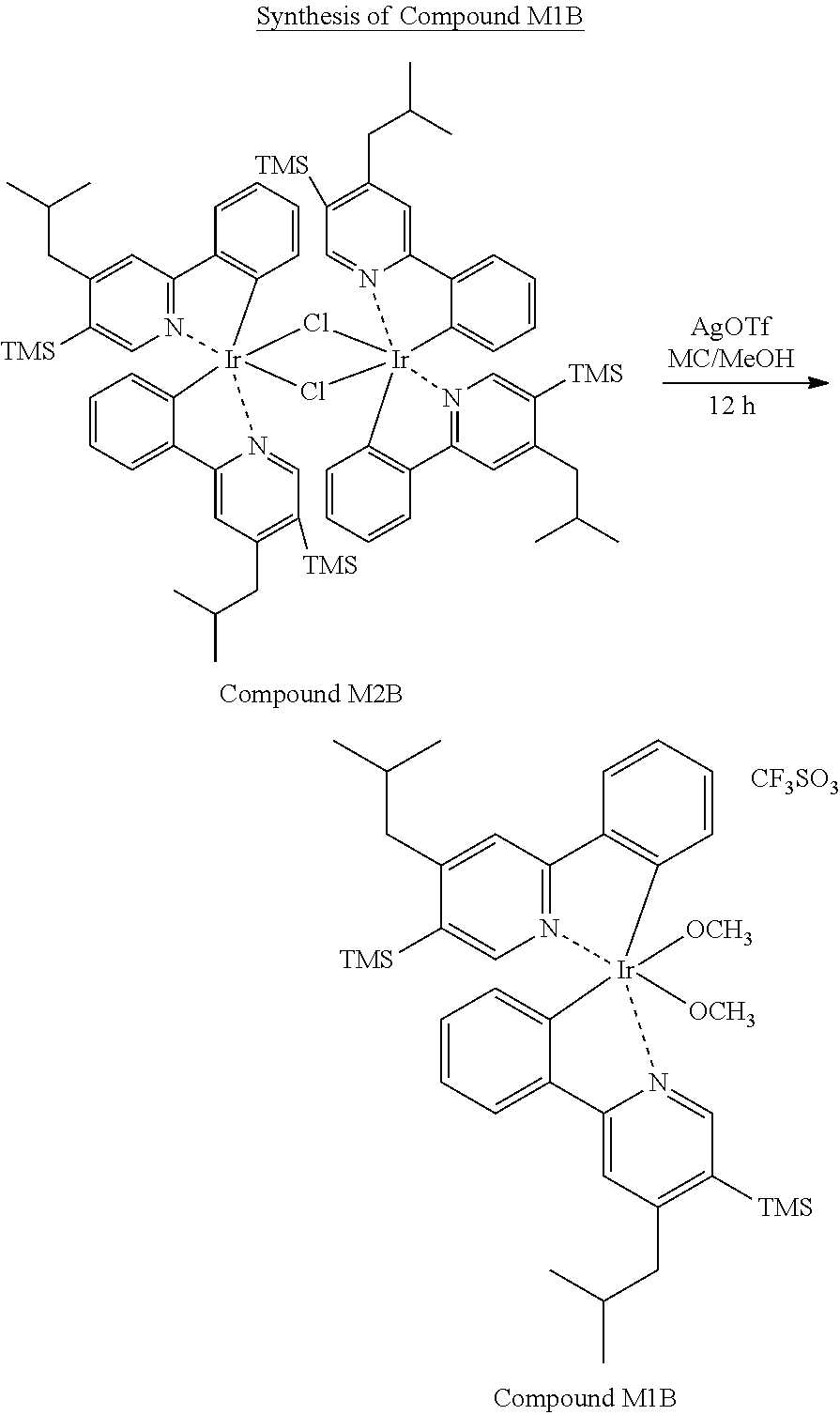

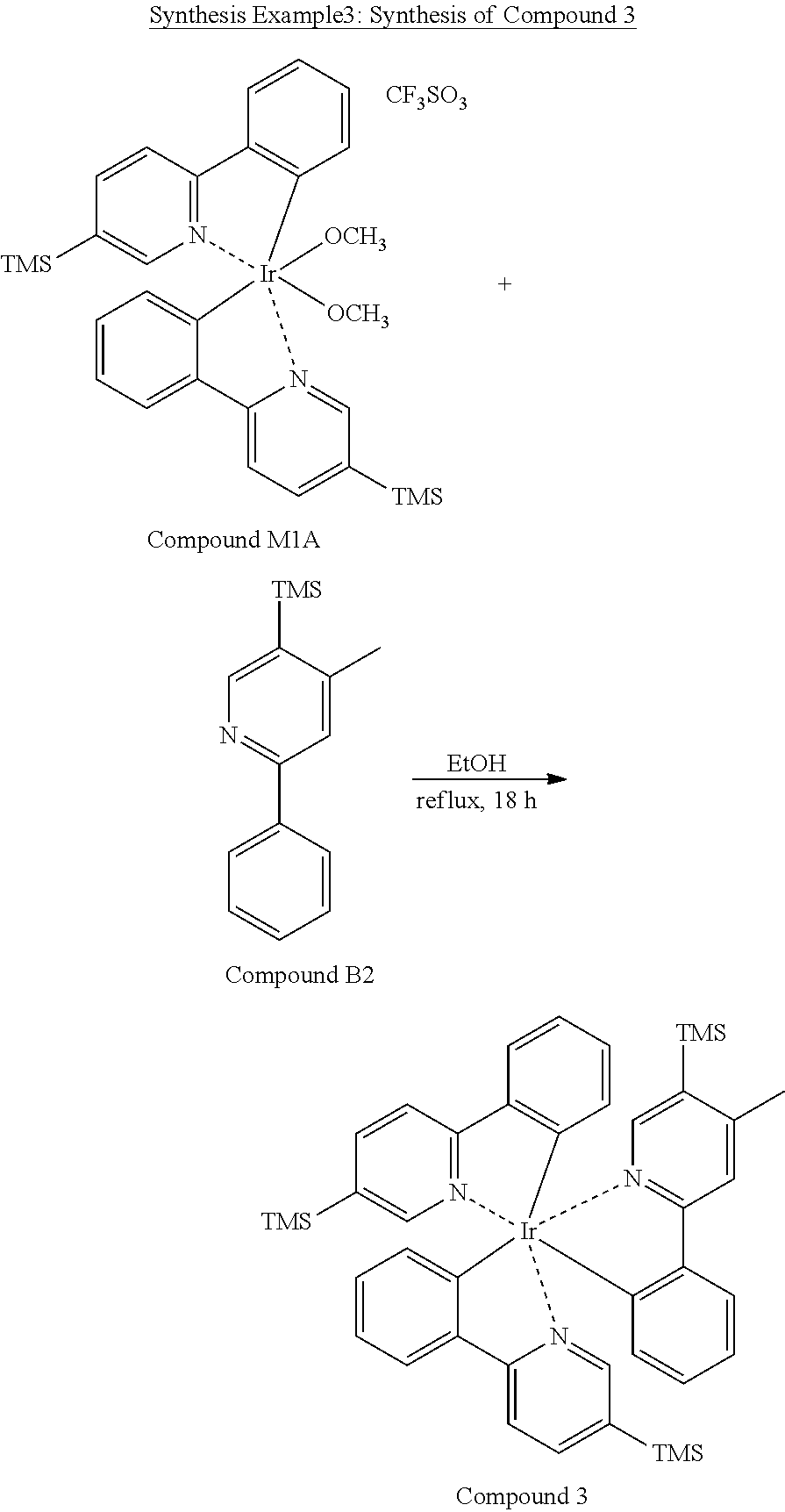
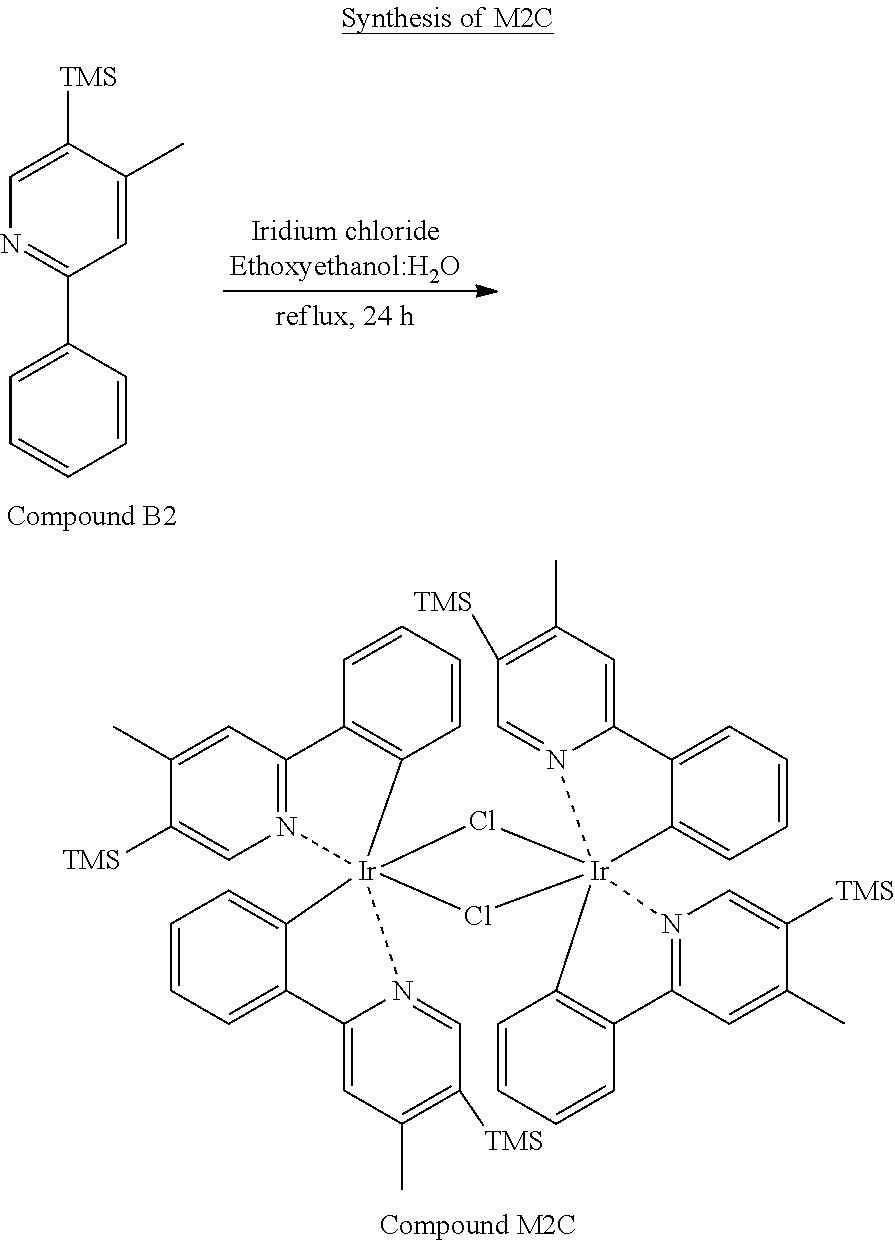
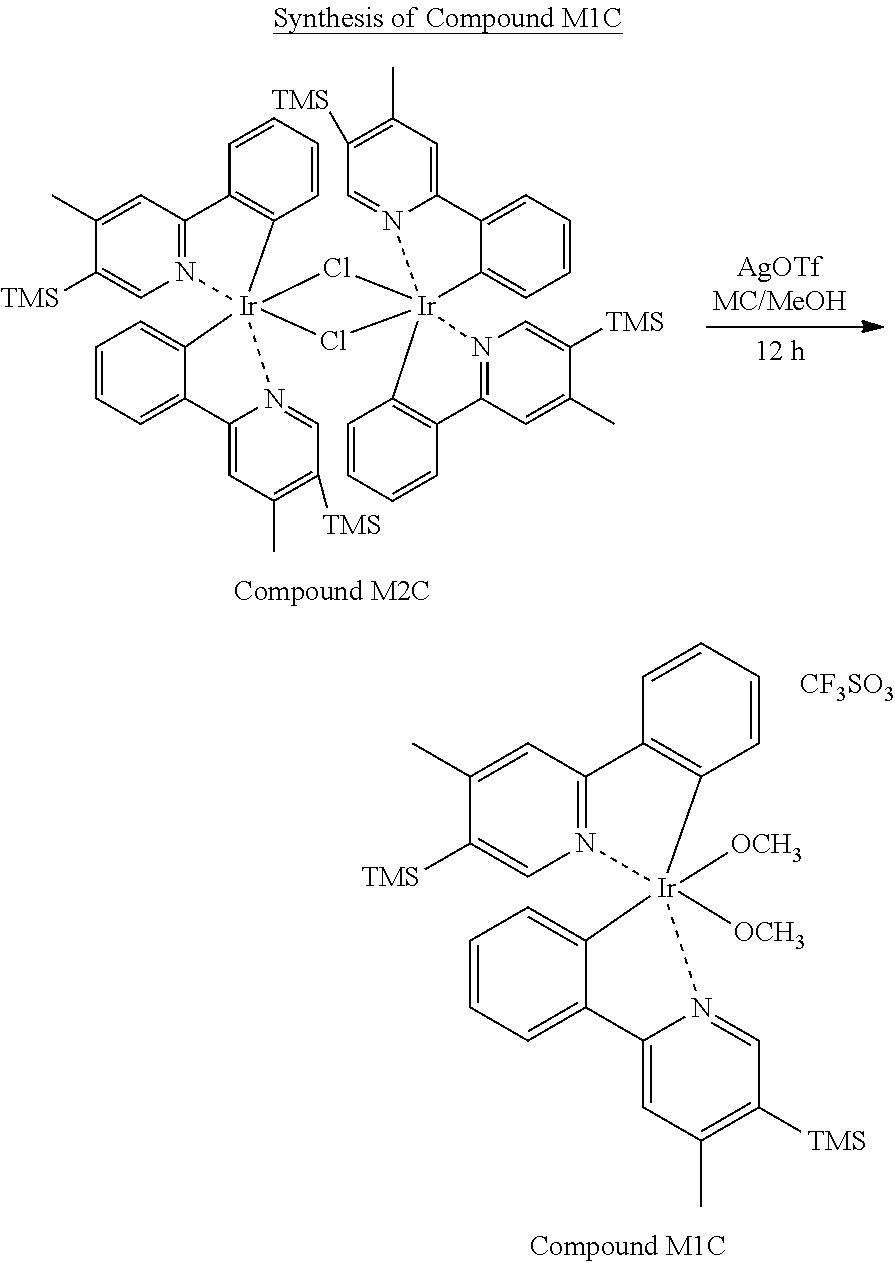
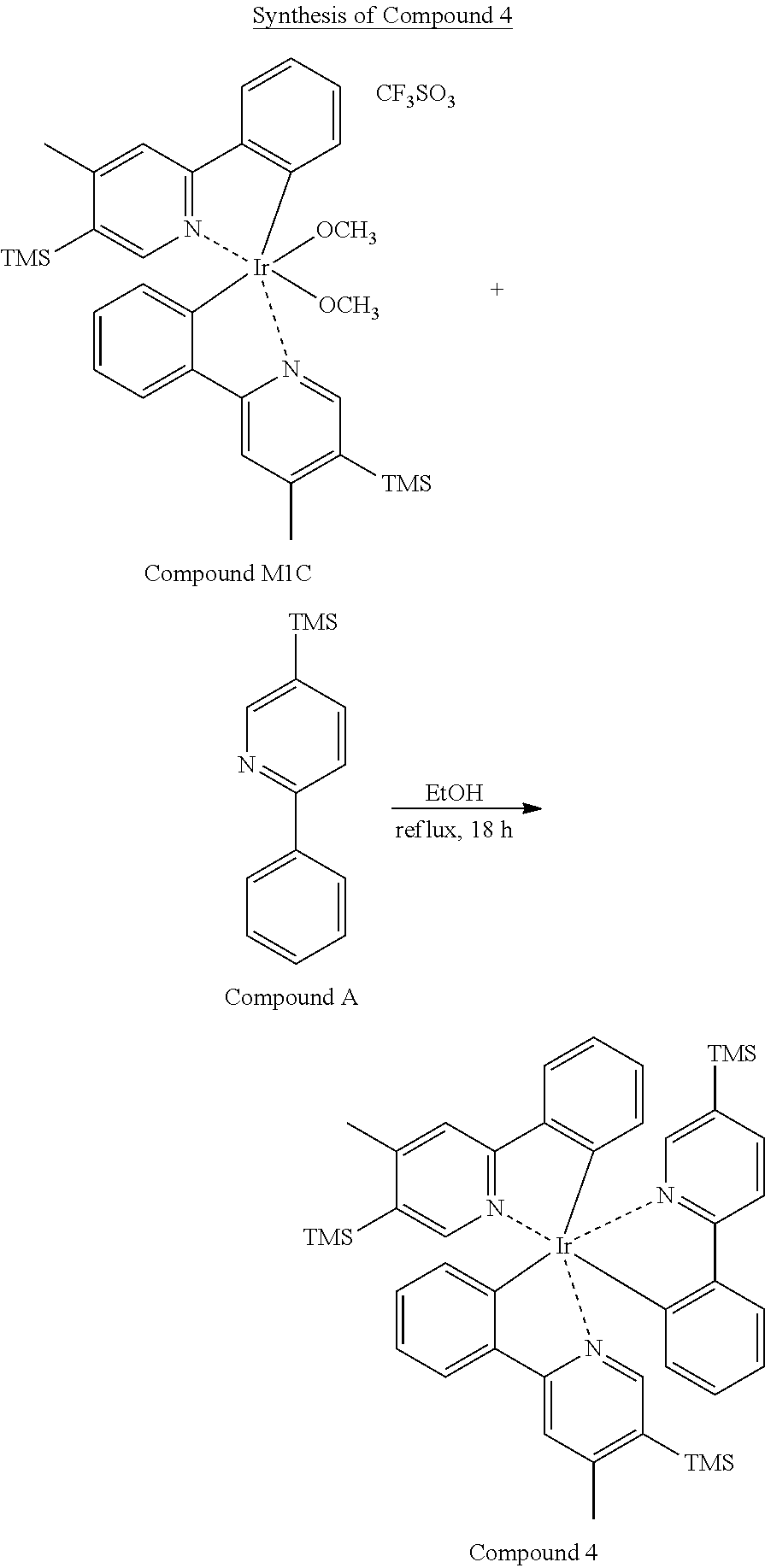
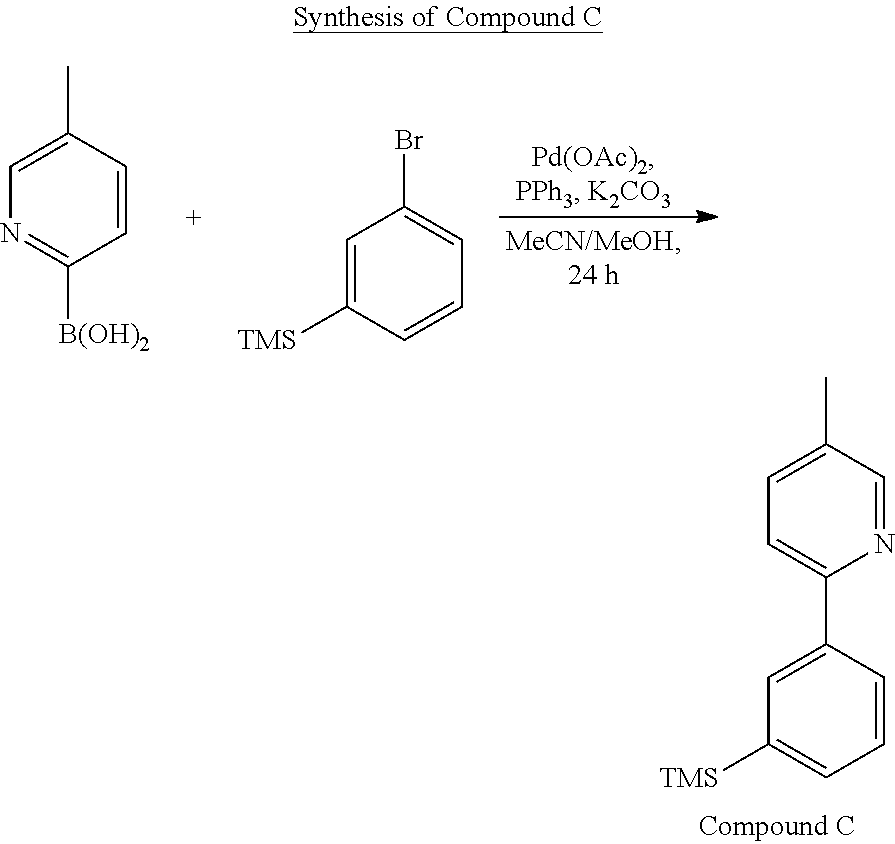


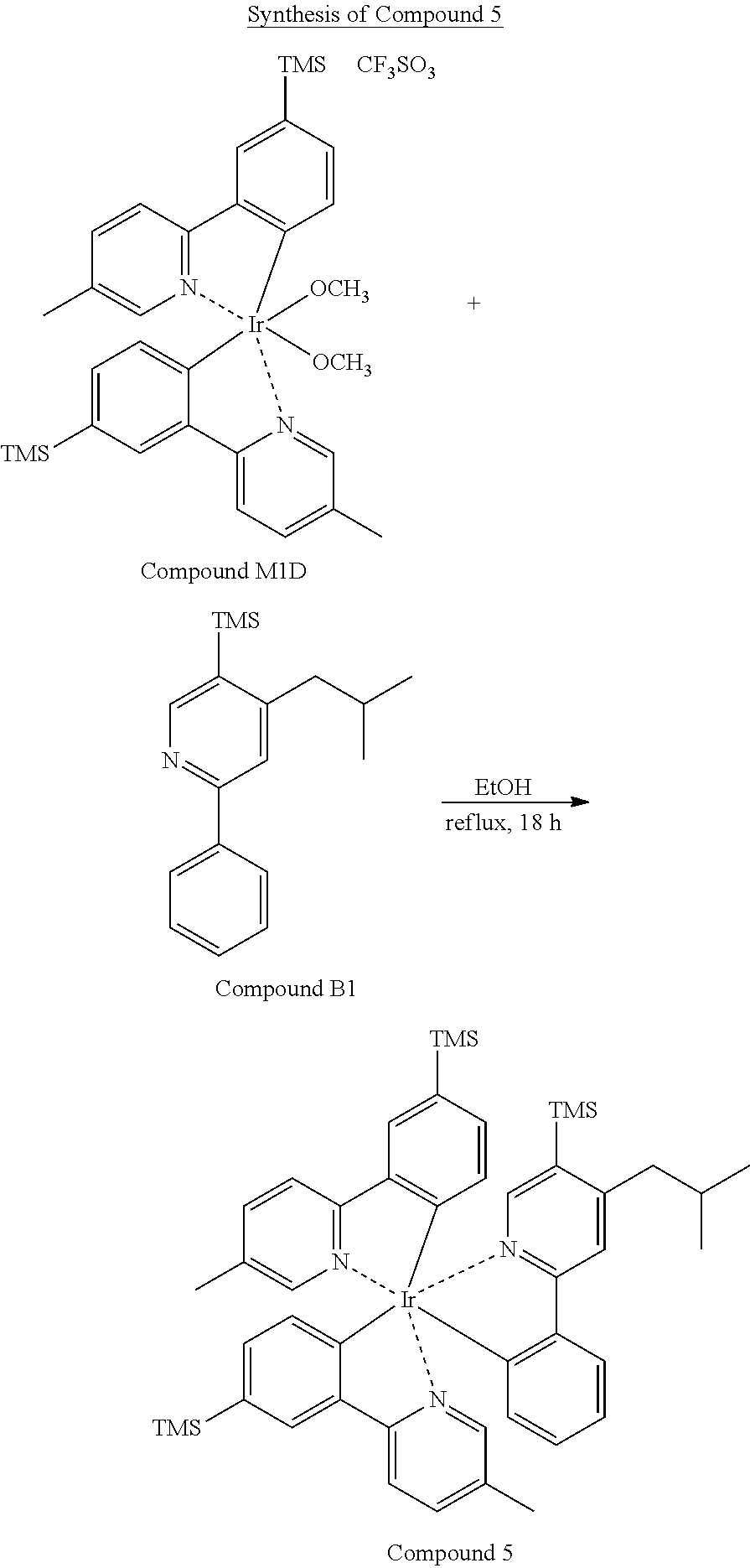
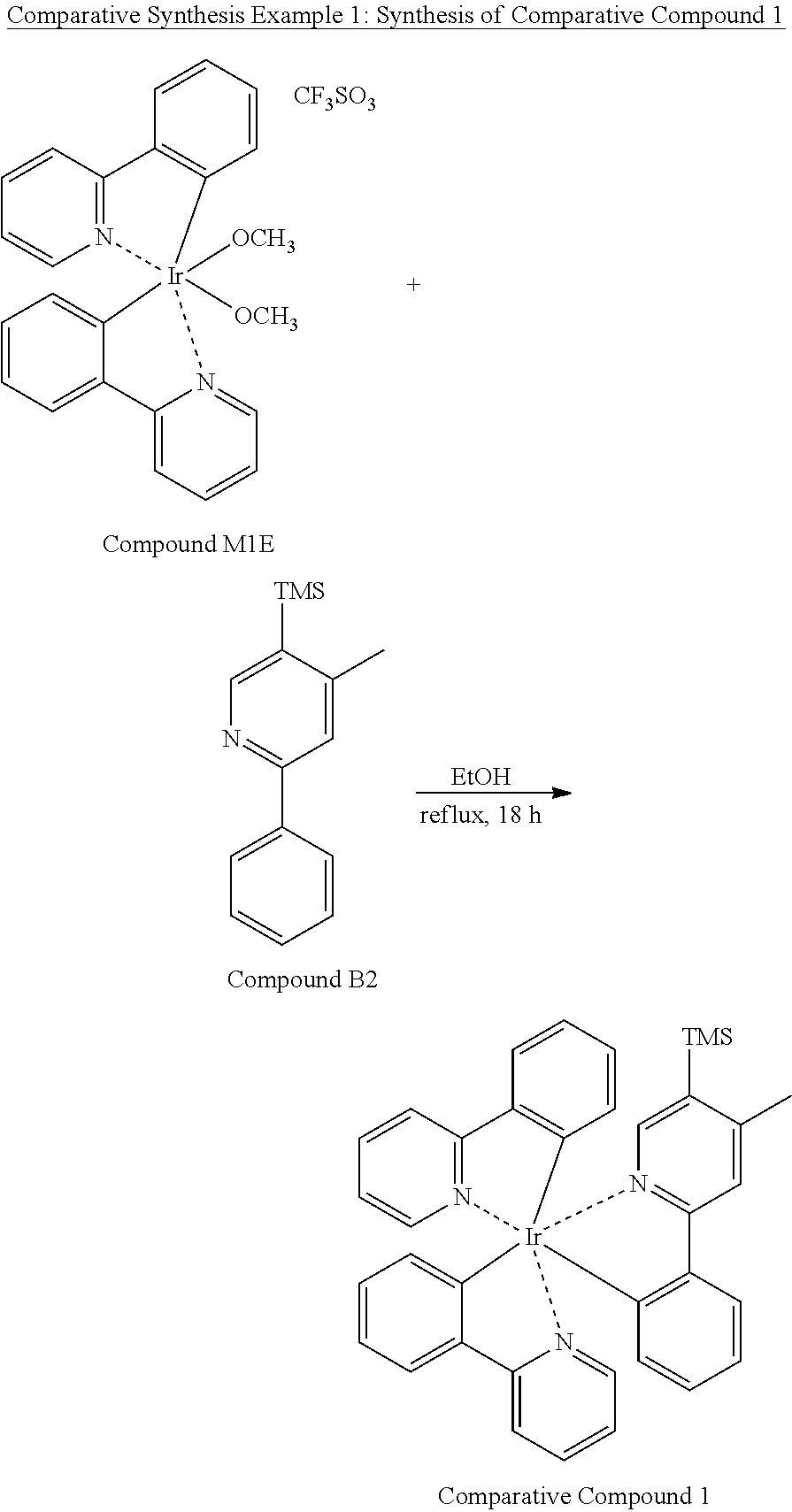
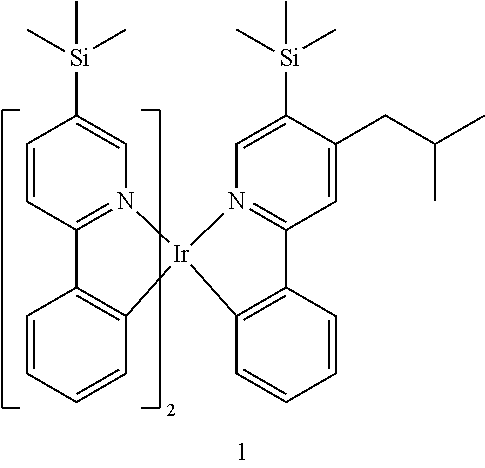
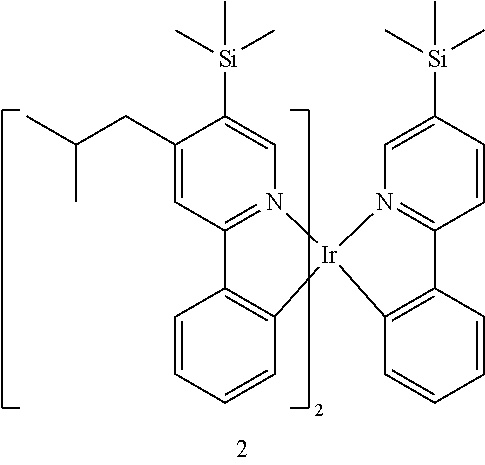
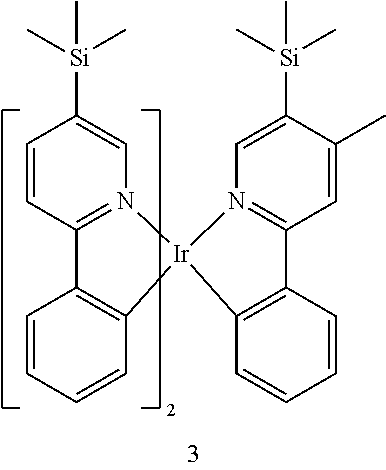
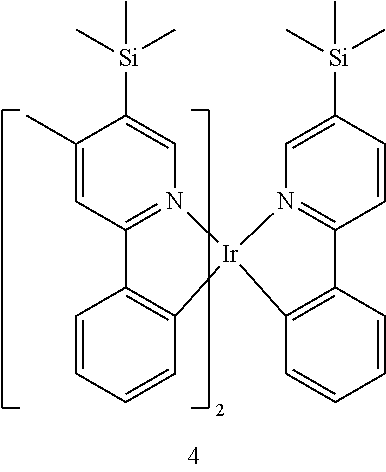
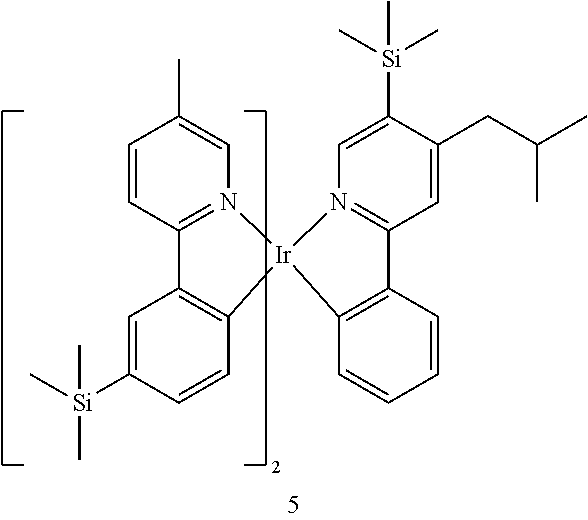
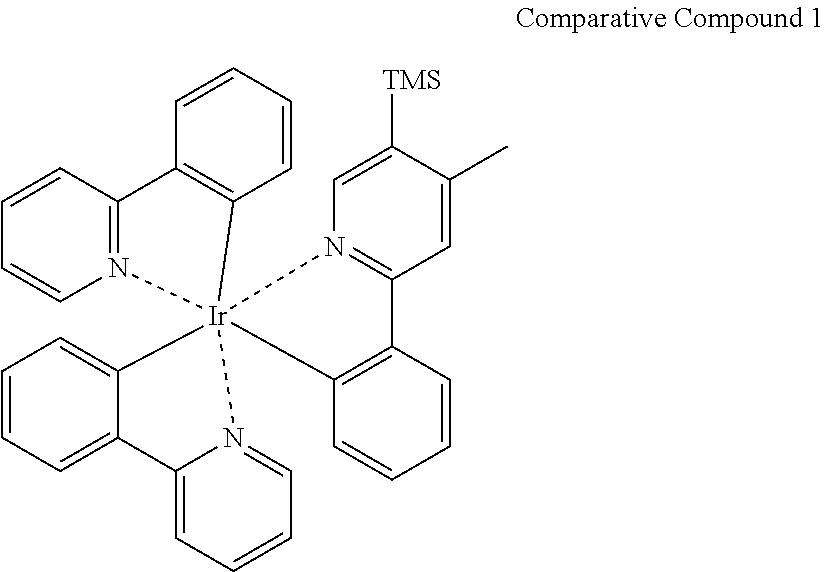

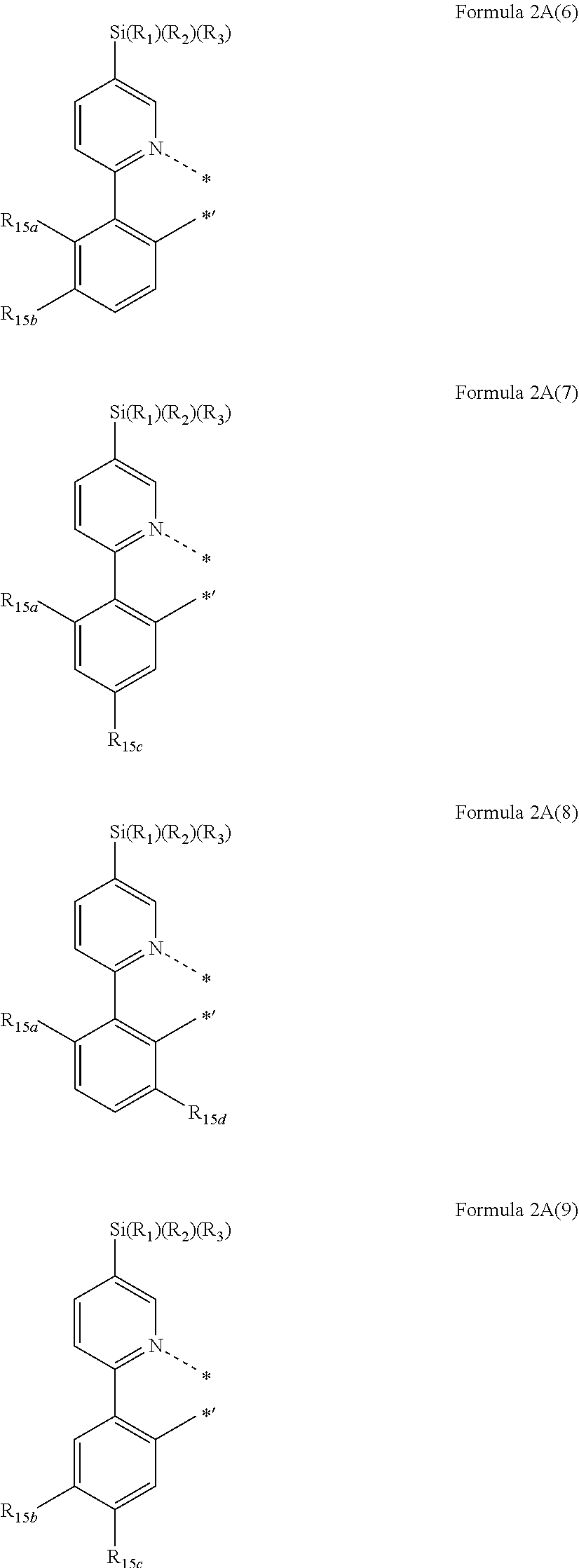
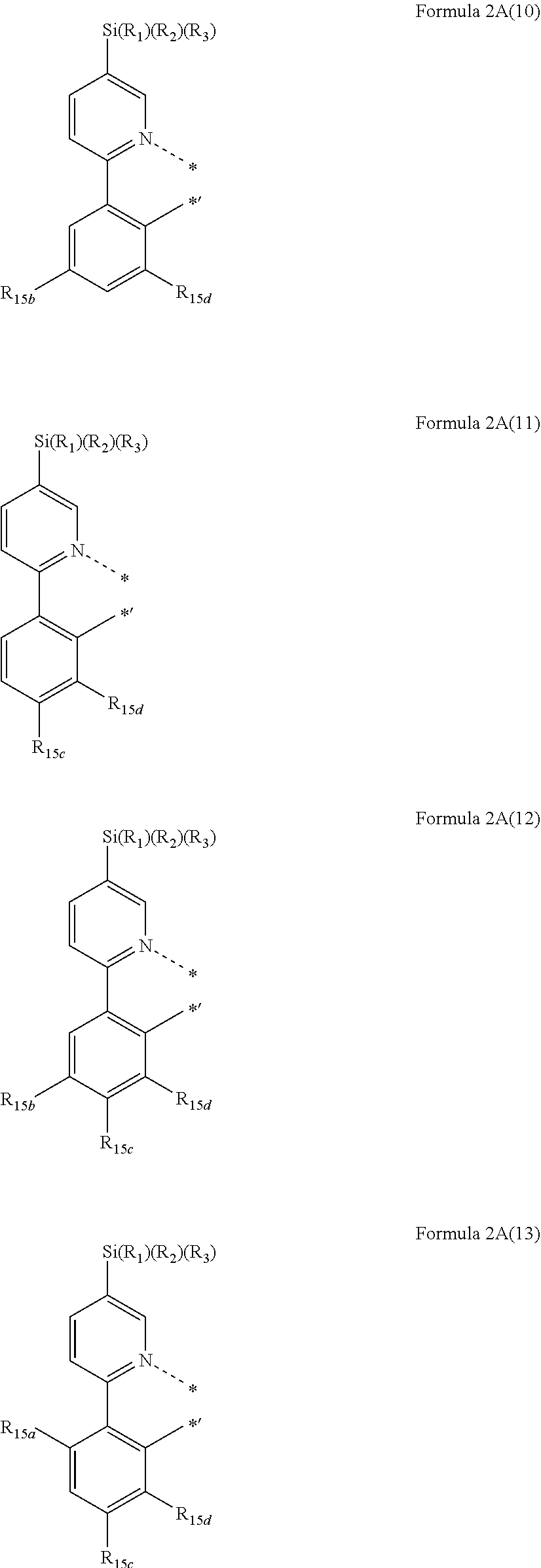
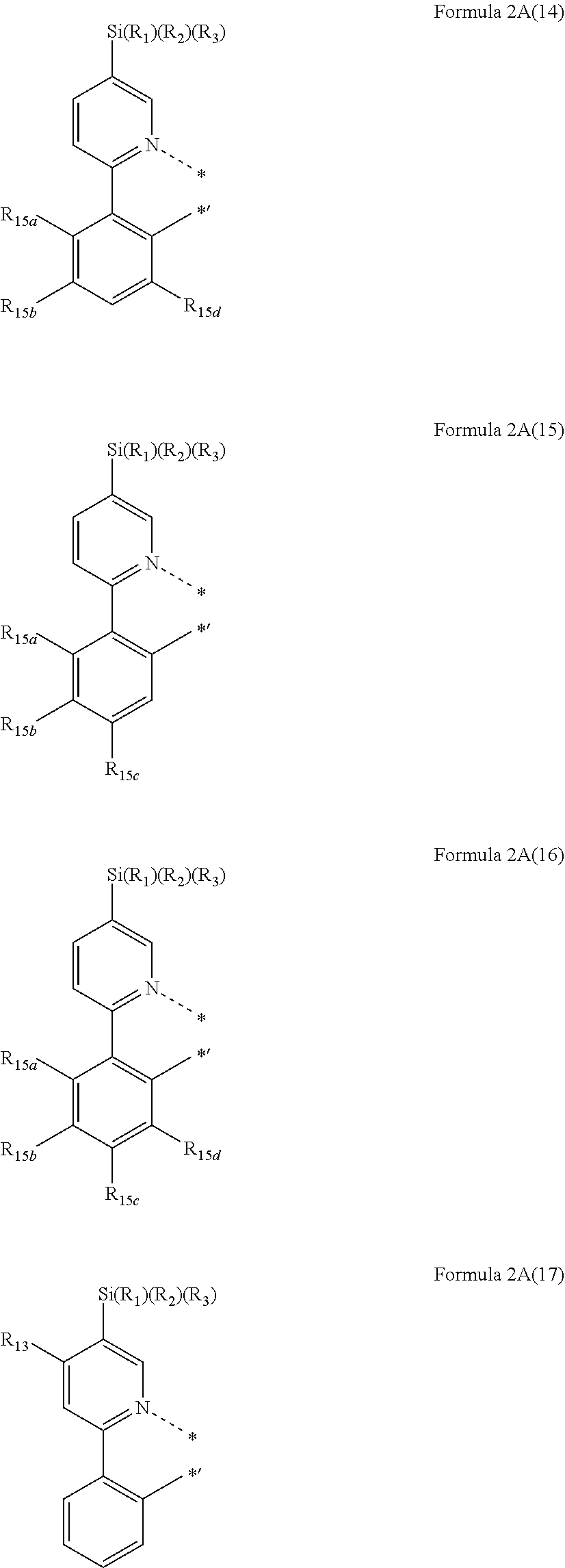
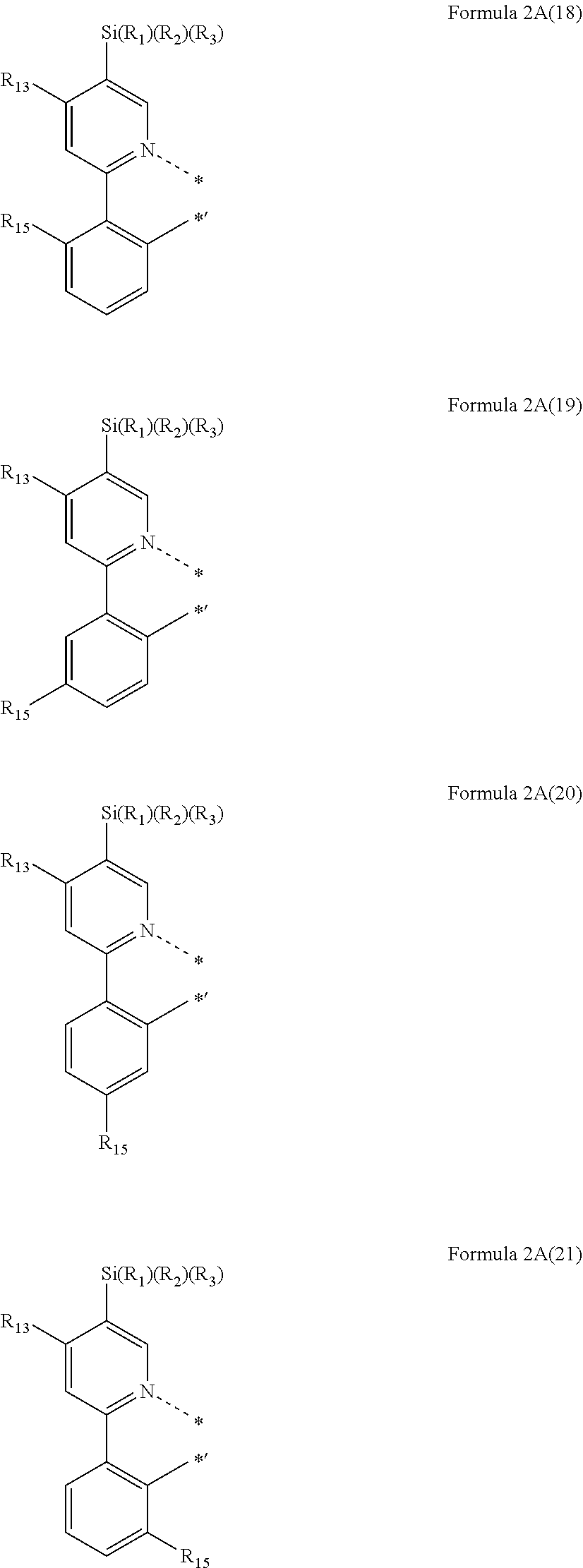


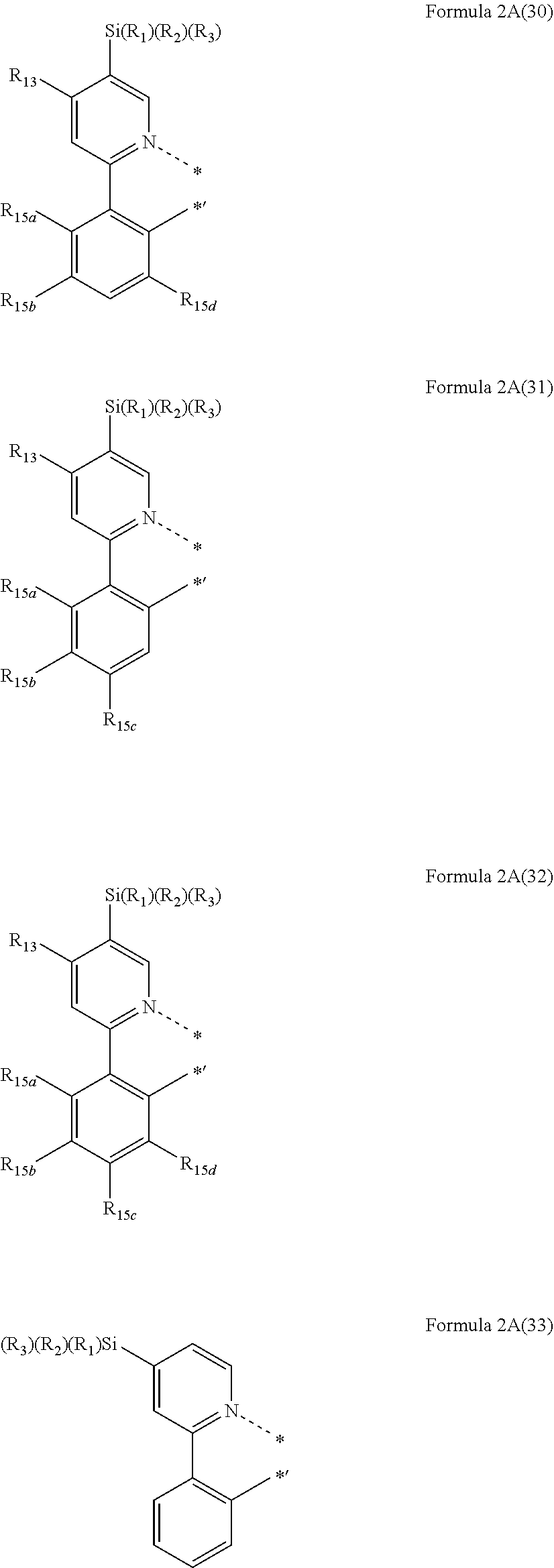































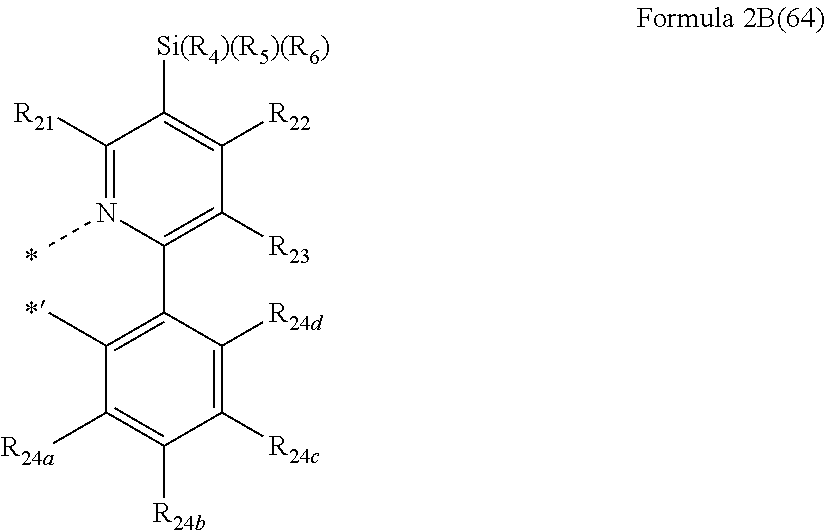

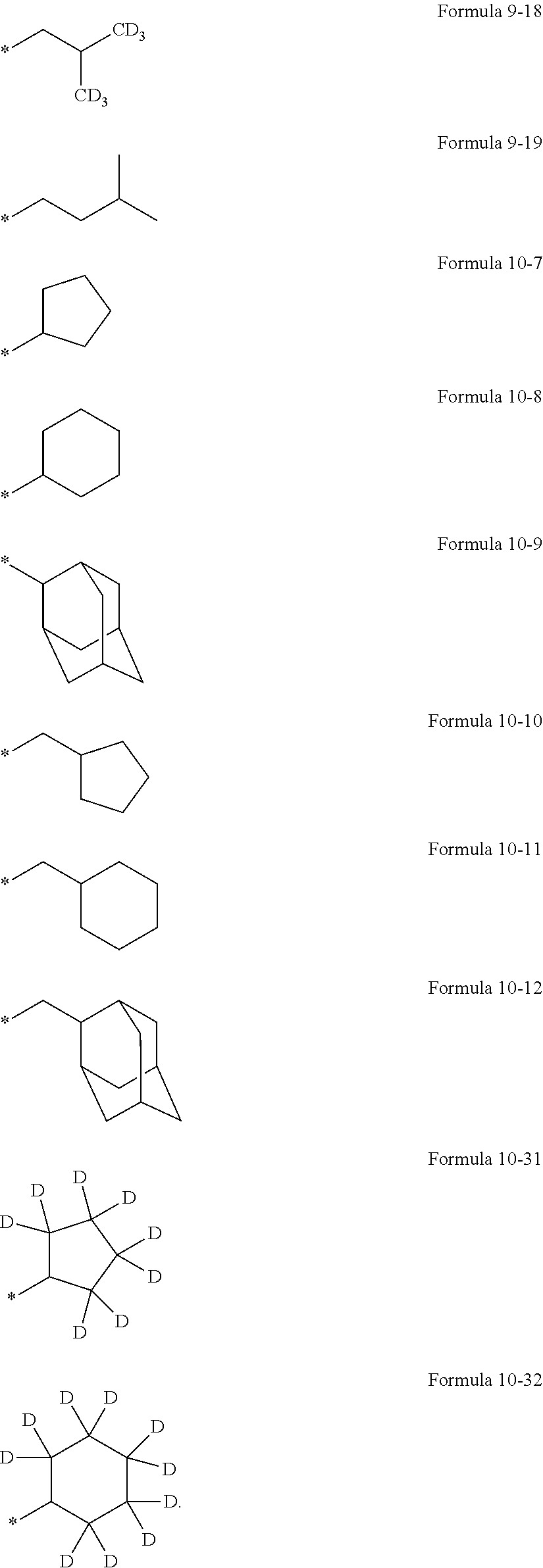


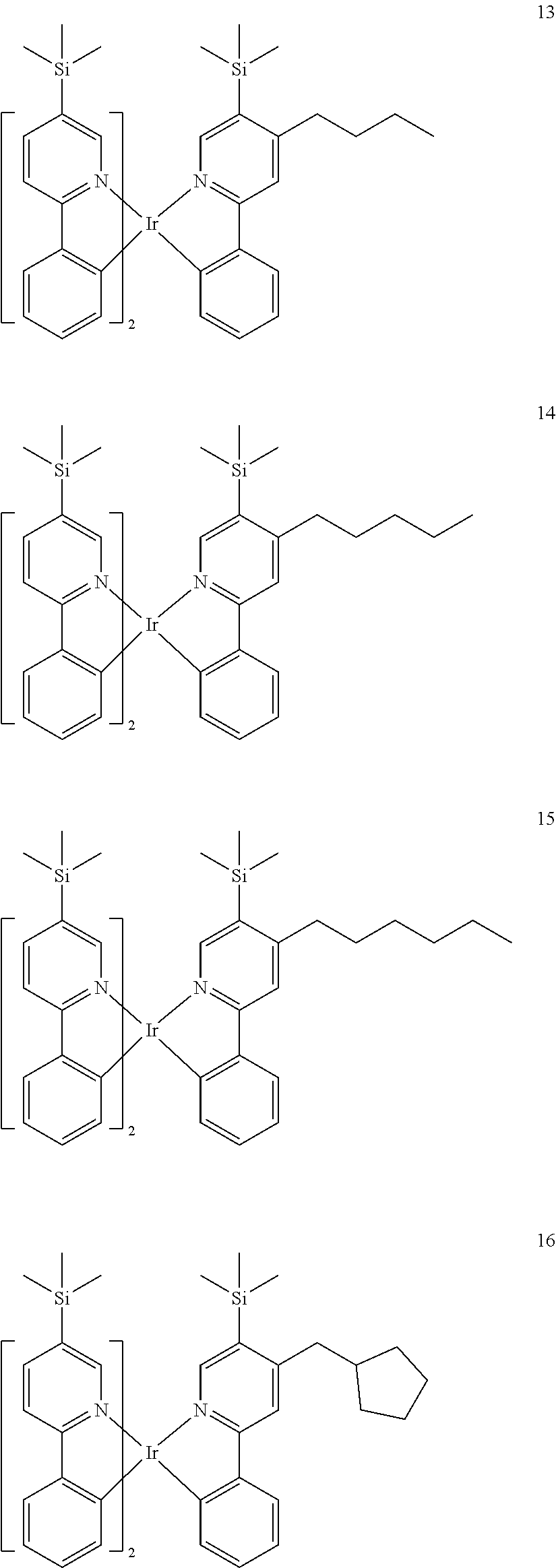
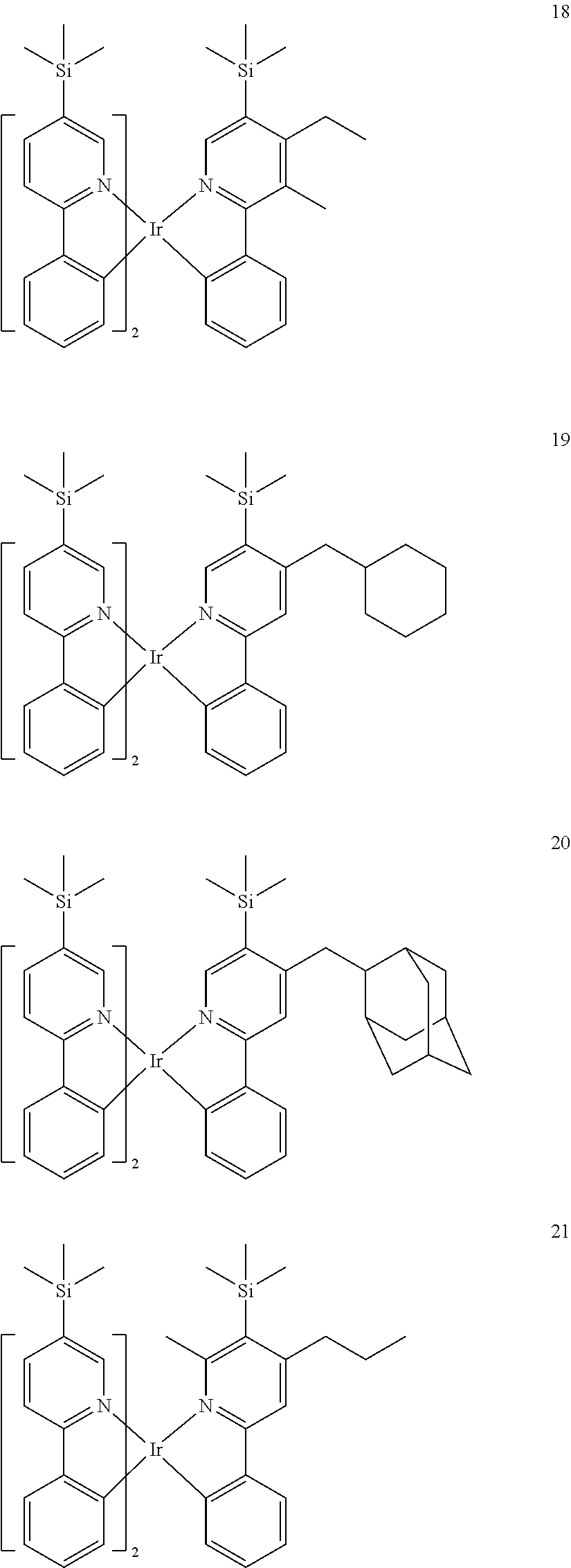
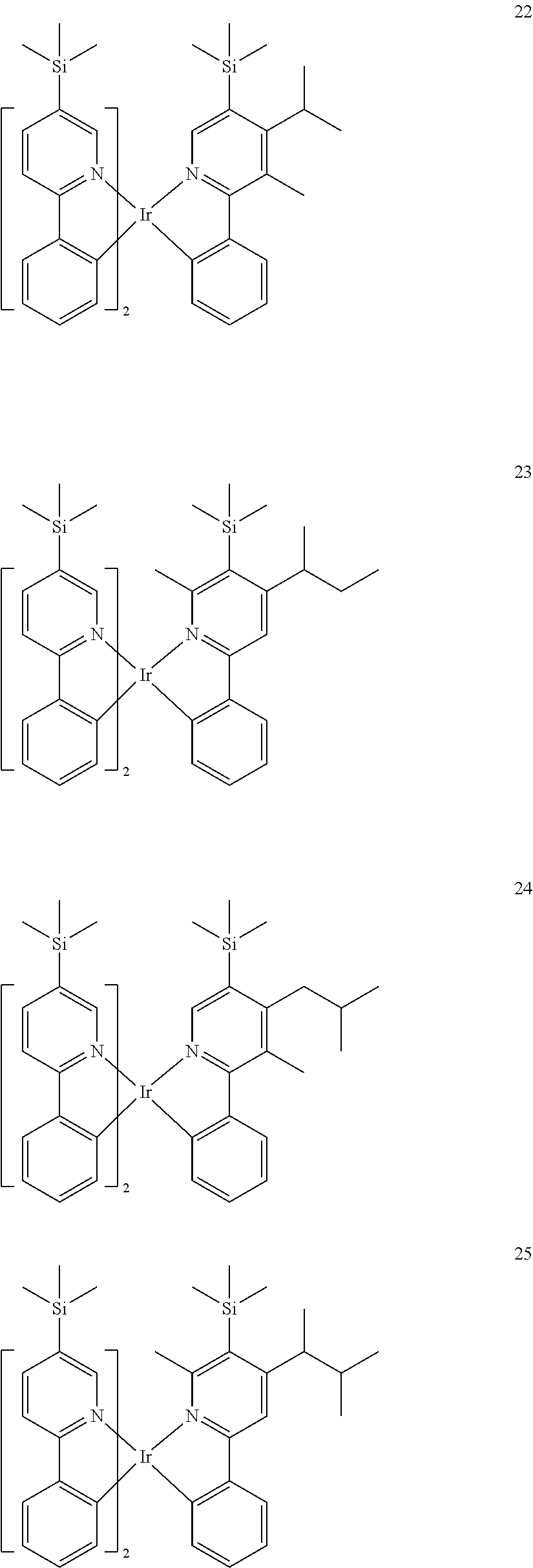




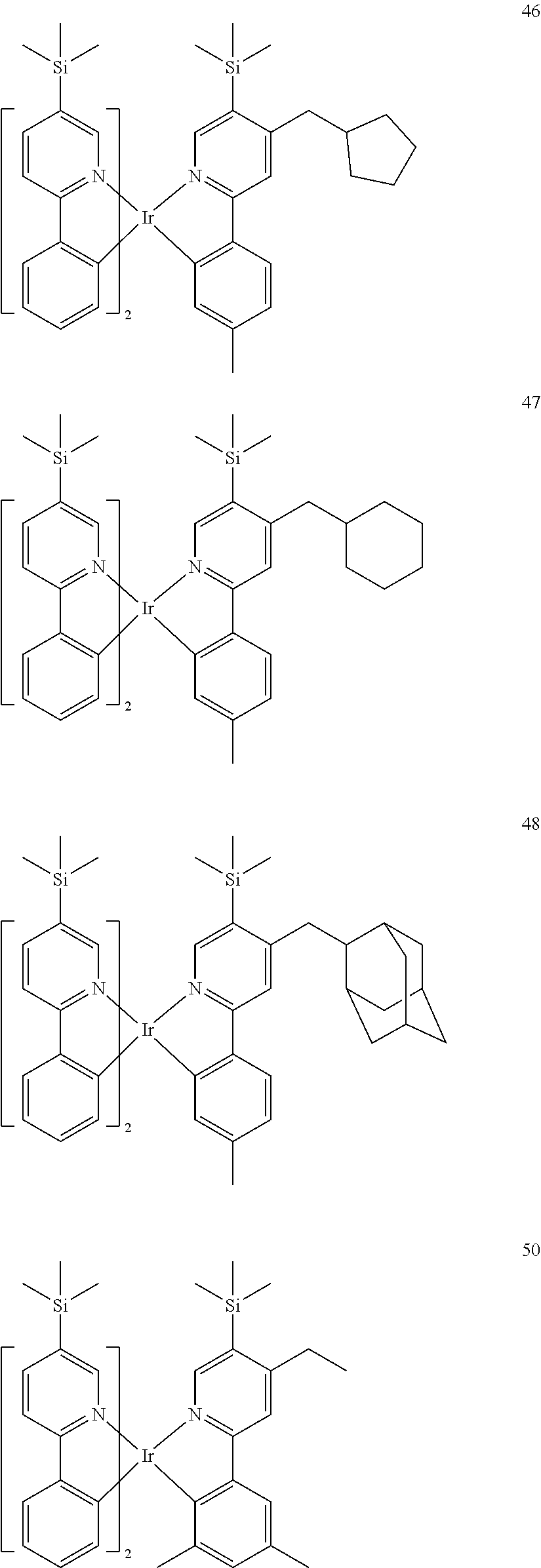


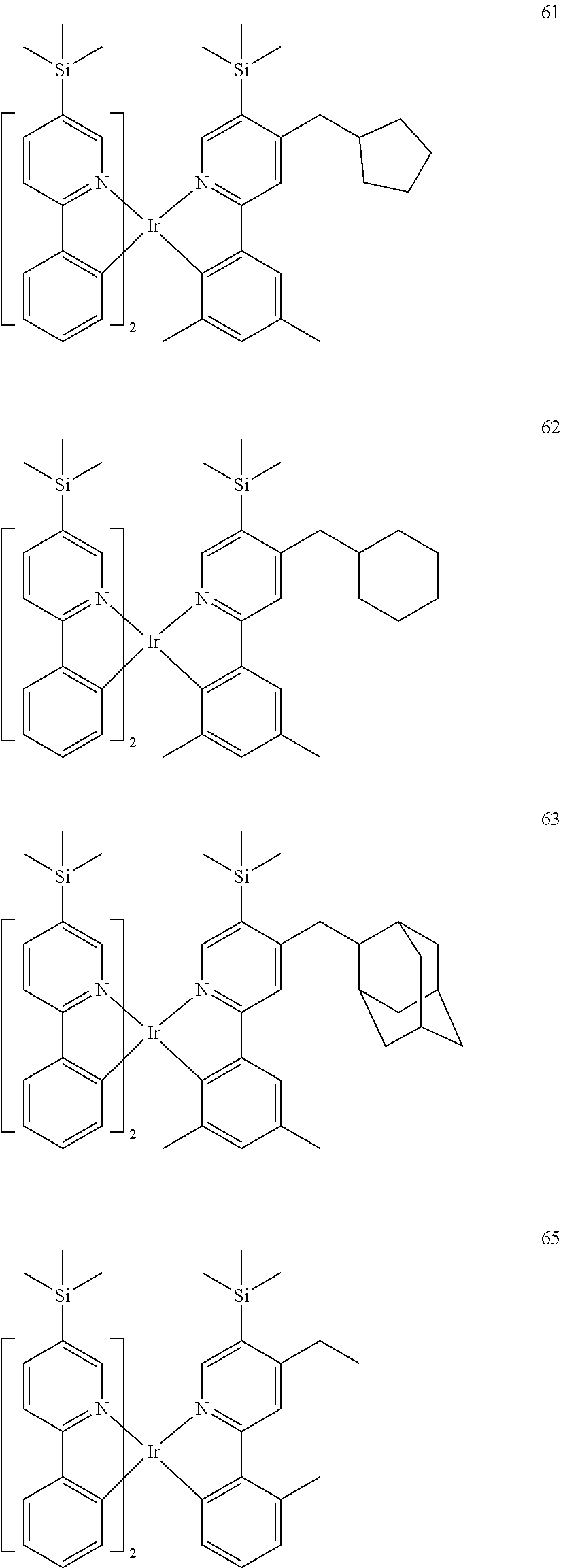




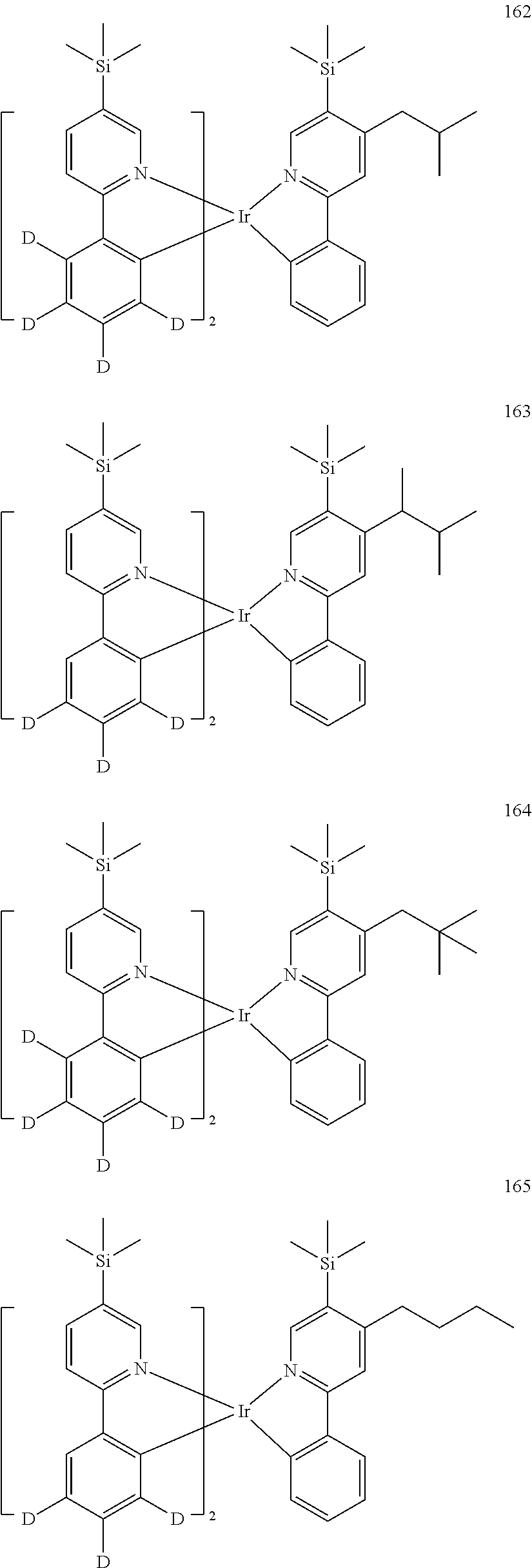


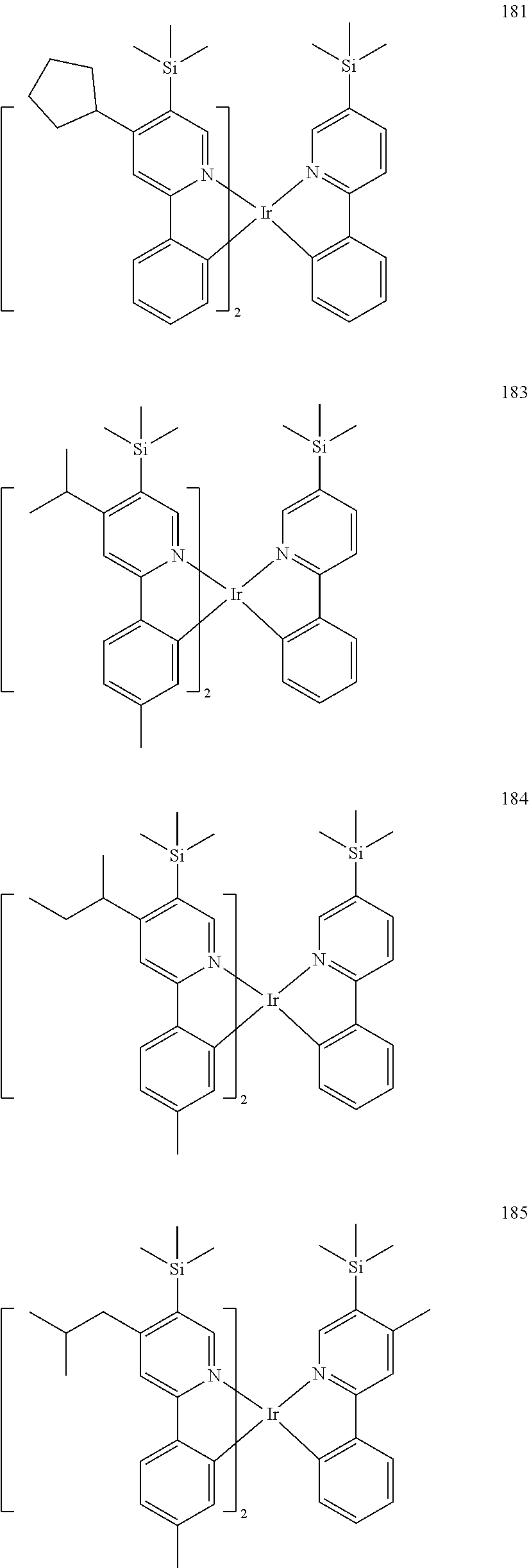








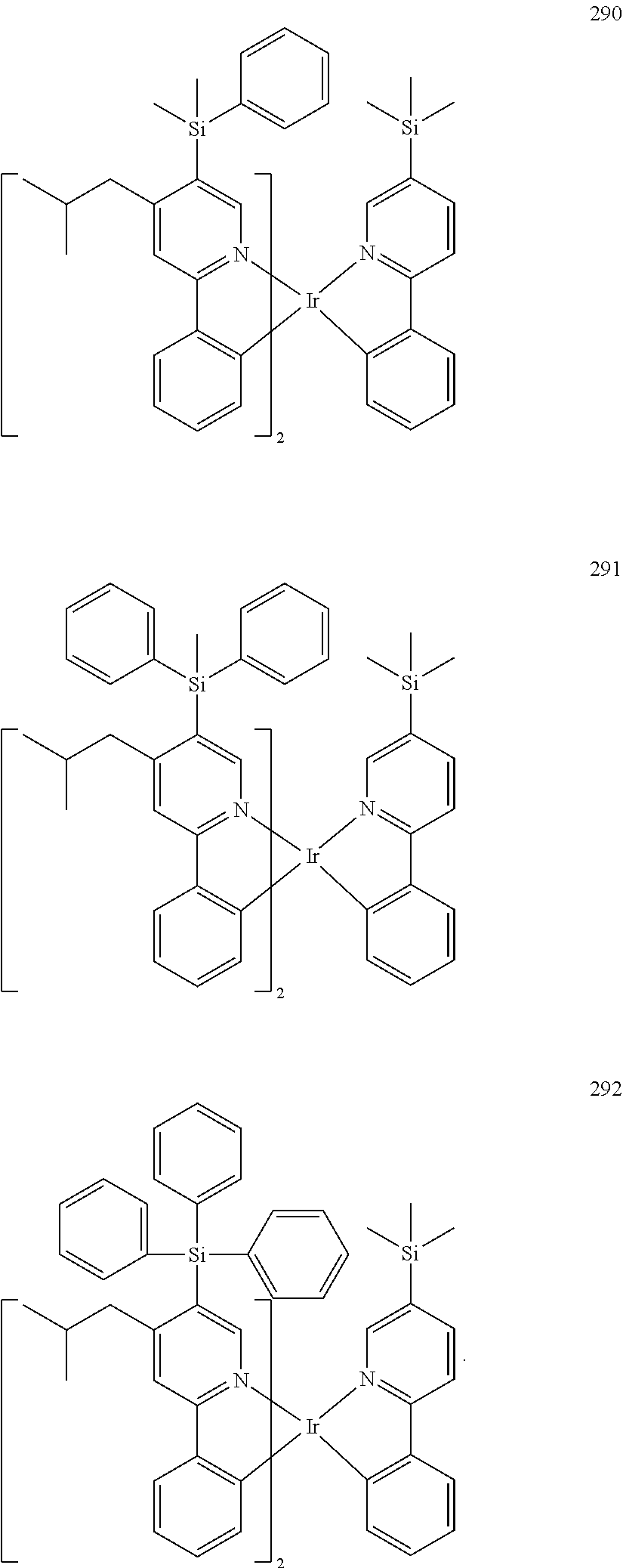
D00000
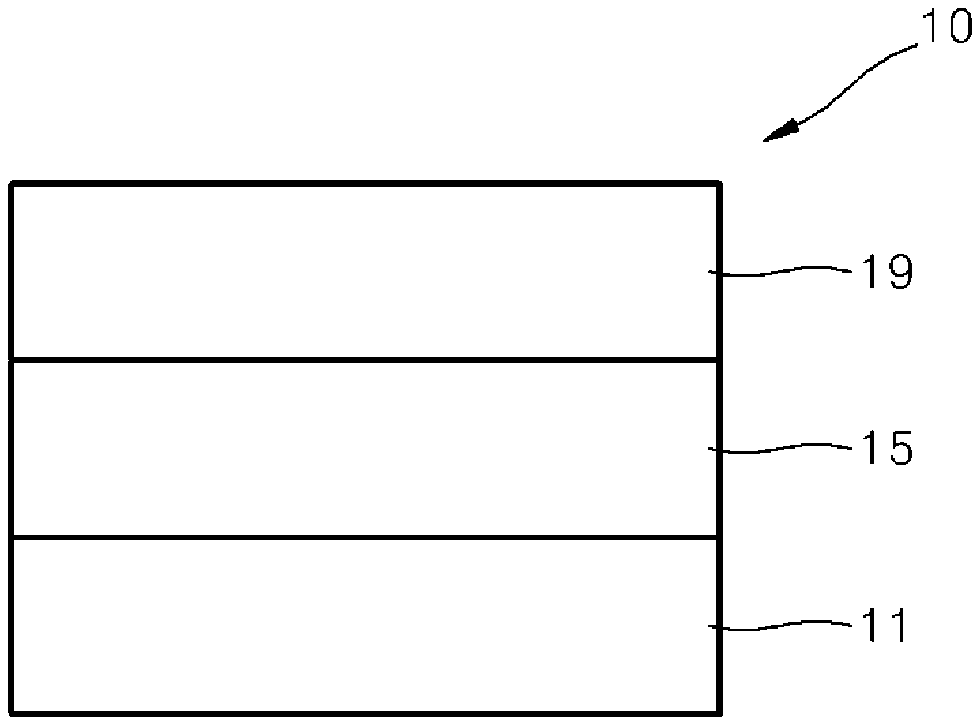
D00001

XML
uspto.report is an independent third-party trademark research tool that is not affiliated, endorsed, or sponsored by the United States Patent and Trademark Office (USPTO) or any other governmental organization. The information provided by uspto.report is based on publicly available data at the time of writing and is intended for informational purposes only.
While we strive to provide accurate and up-to-date information, we do not guarantee the accuracy, completeness, reliability, or suitability of the information displayed on this site. The use of this site is at your own risk. Any reliance you place on such information is therefore strictly at your own risk.
All official trademark data, including owner information, should be verified by visiting the official USPTO website at www.uspto.gov. This site is not intended to replace professional legal advice and should not be used as a substitute for consulting with a legal professional who is knowledgeable about trademark law.